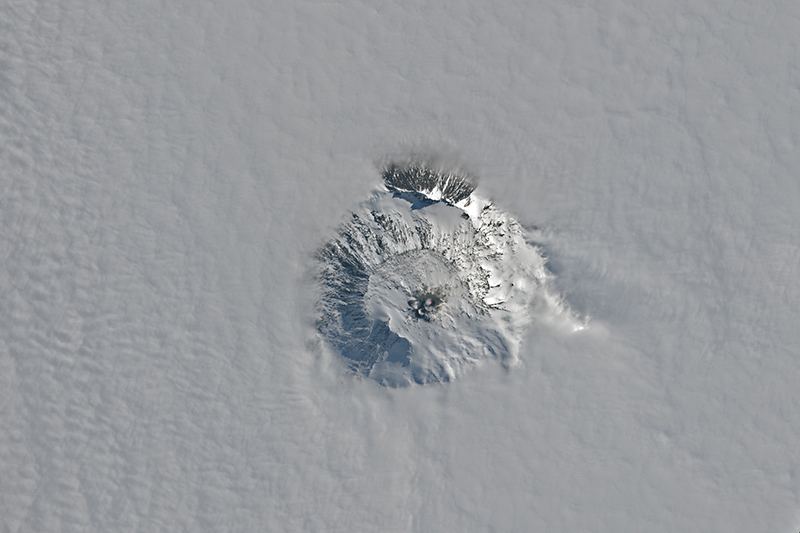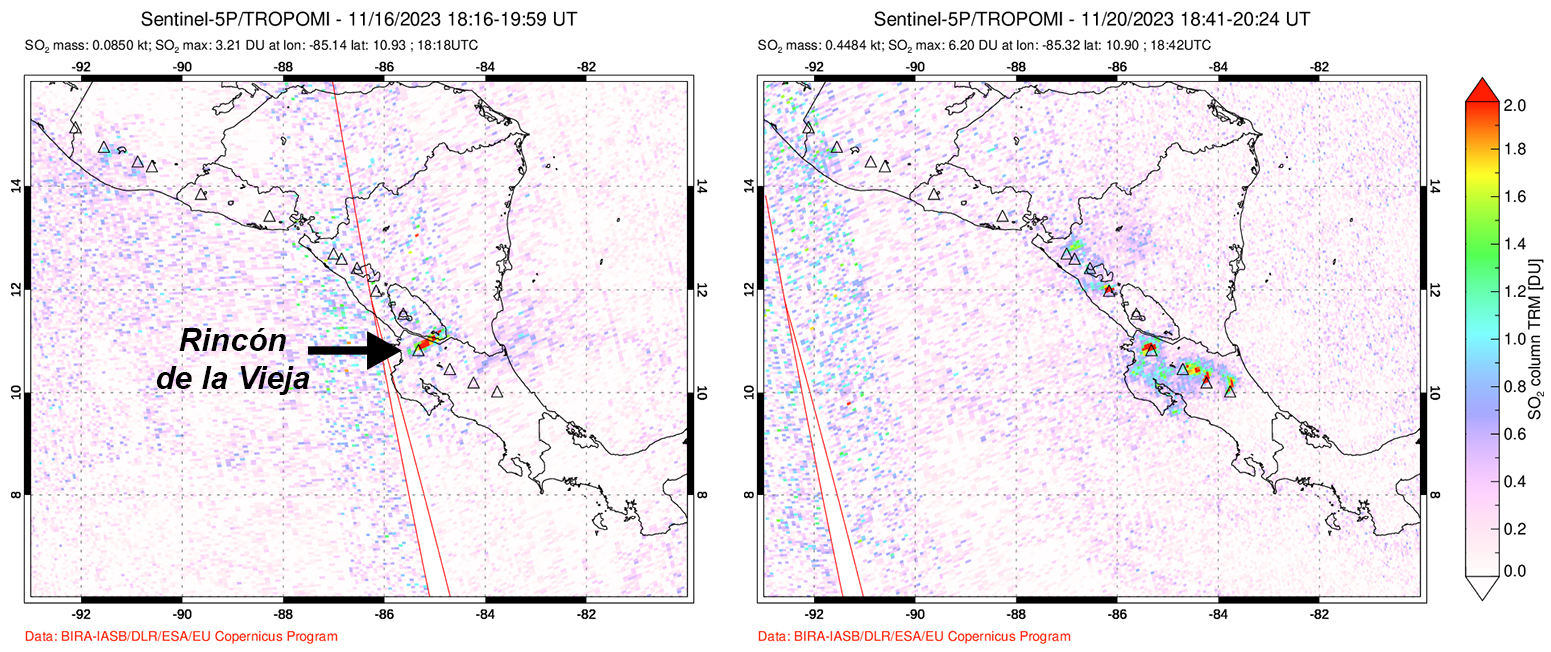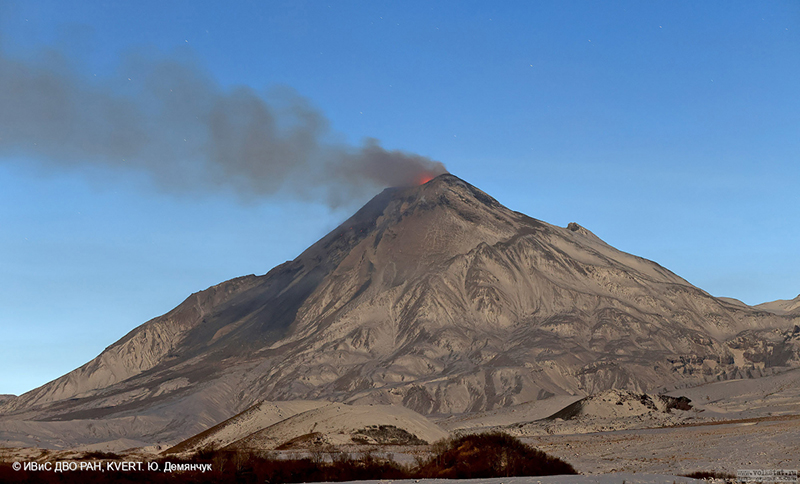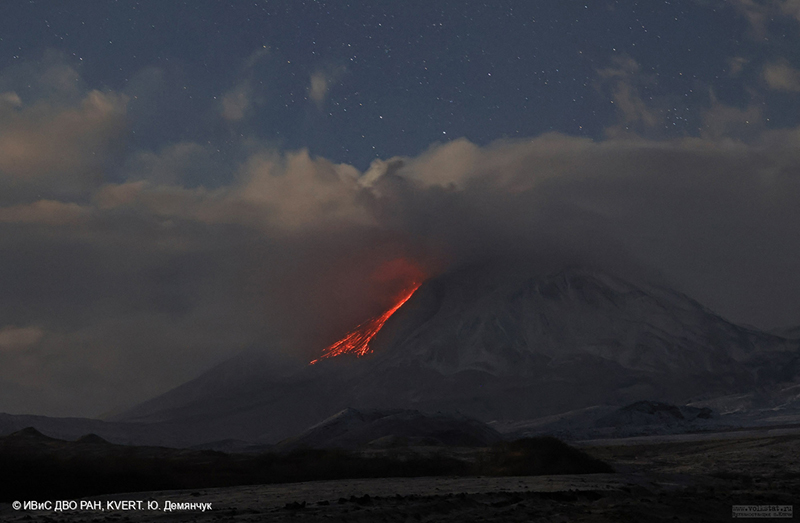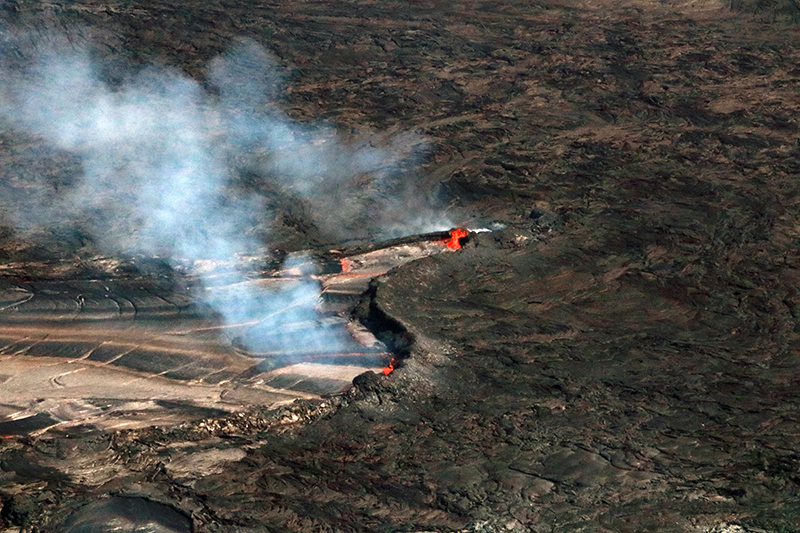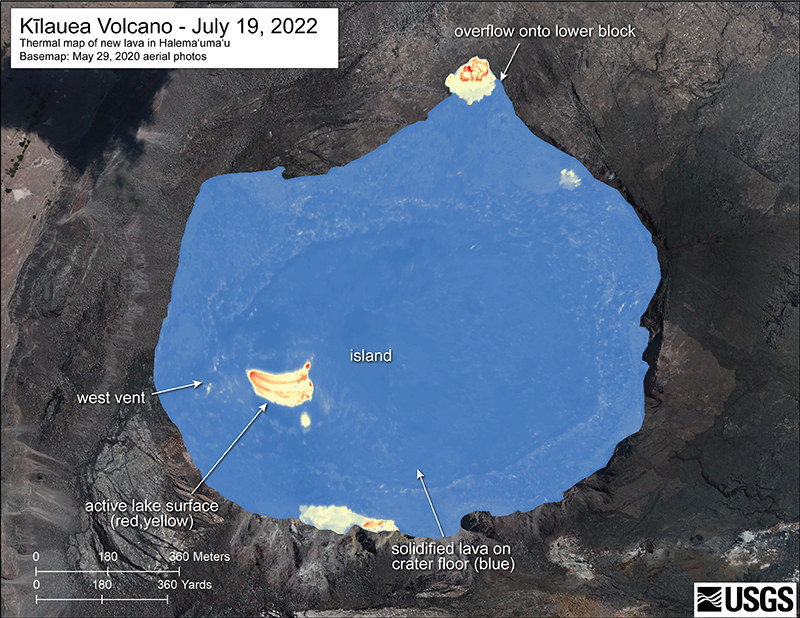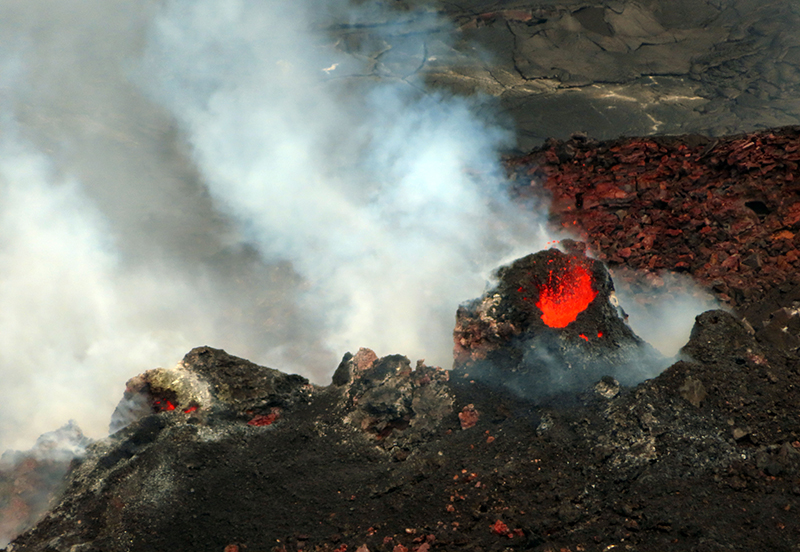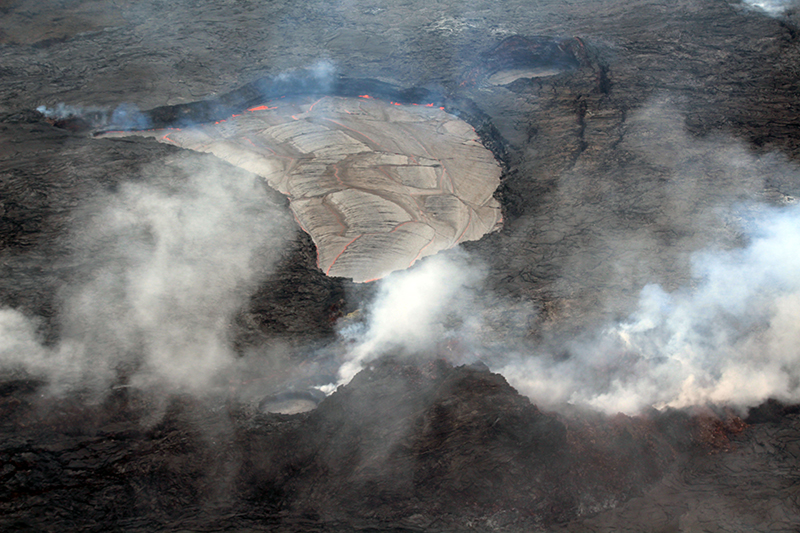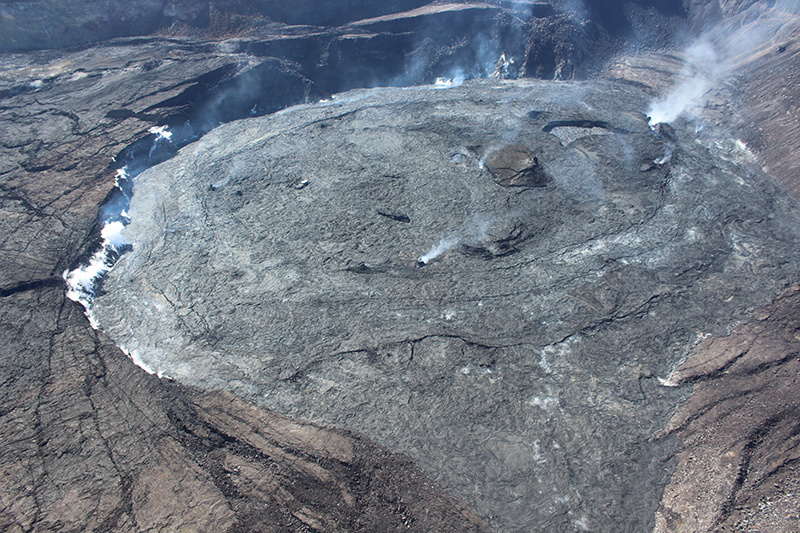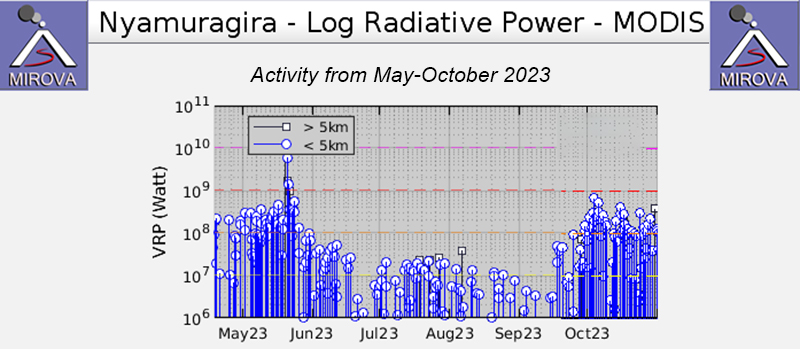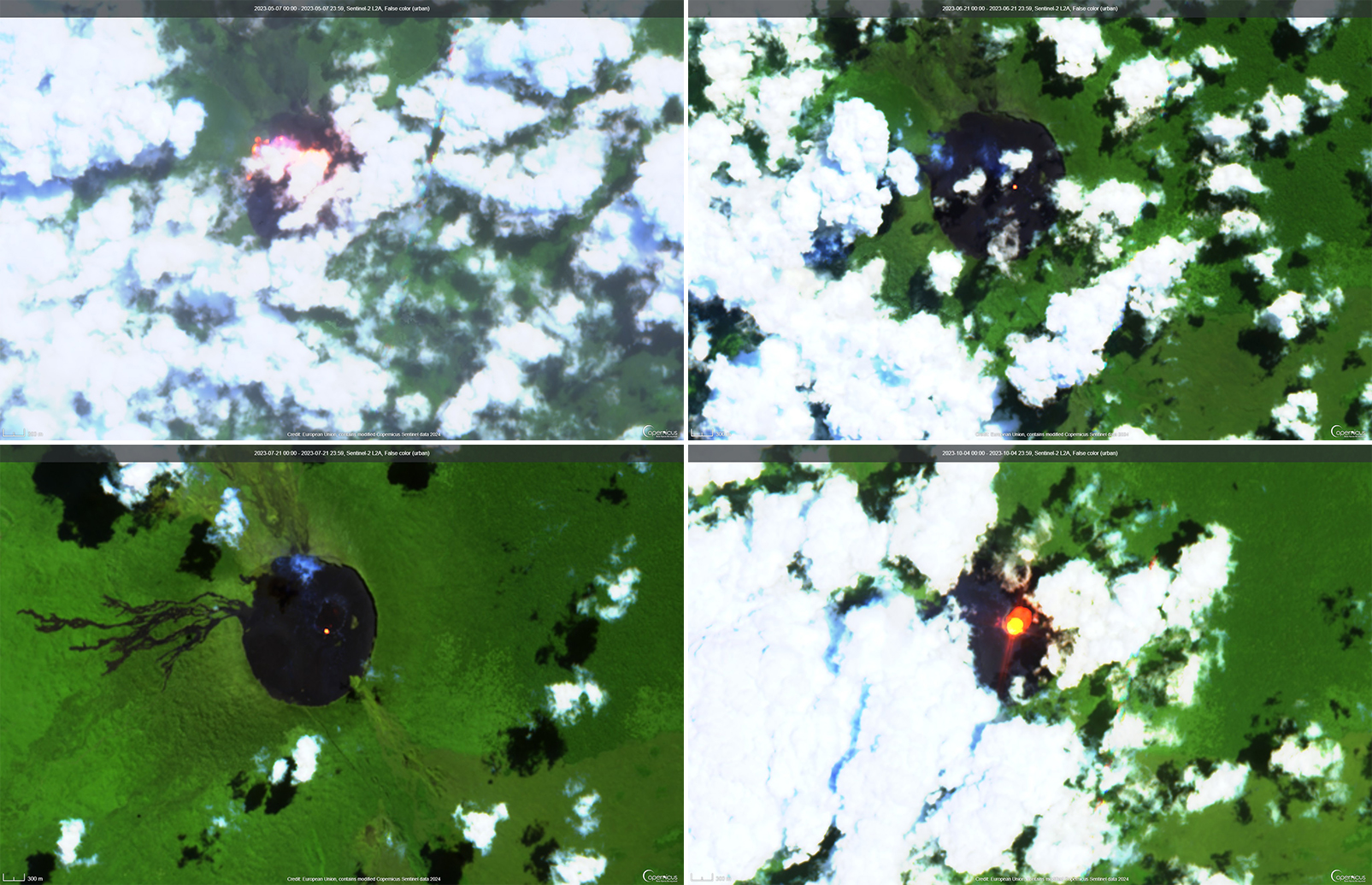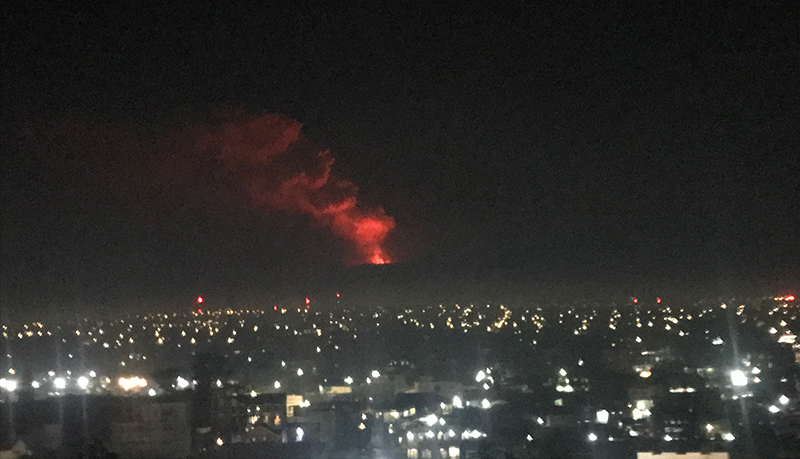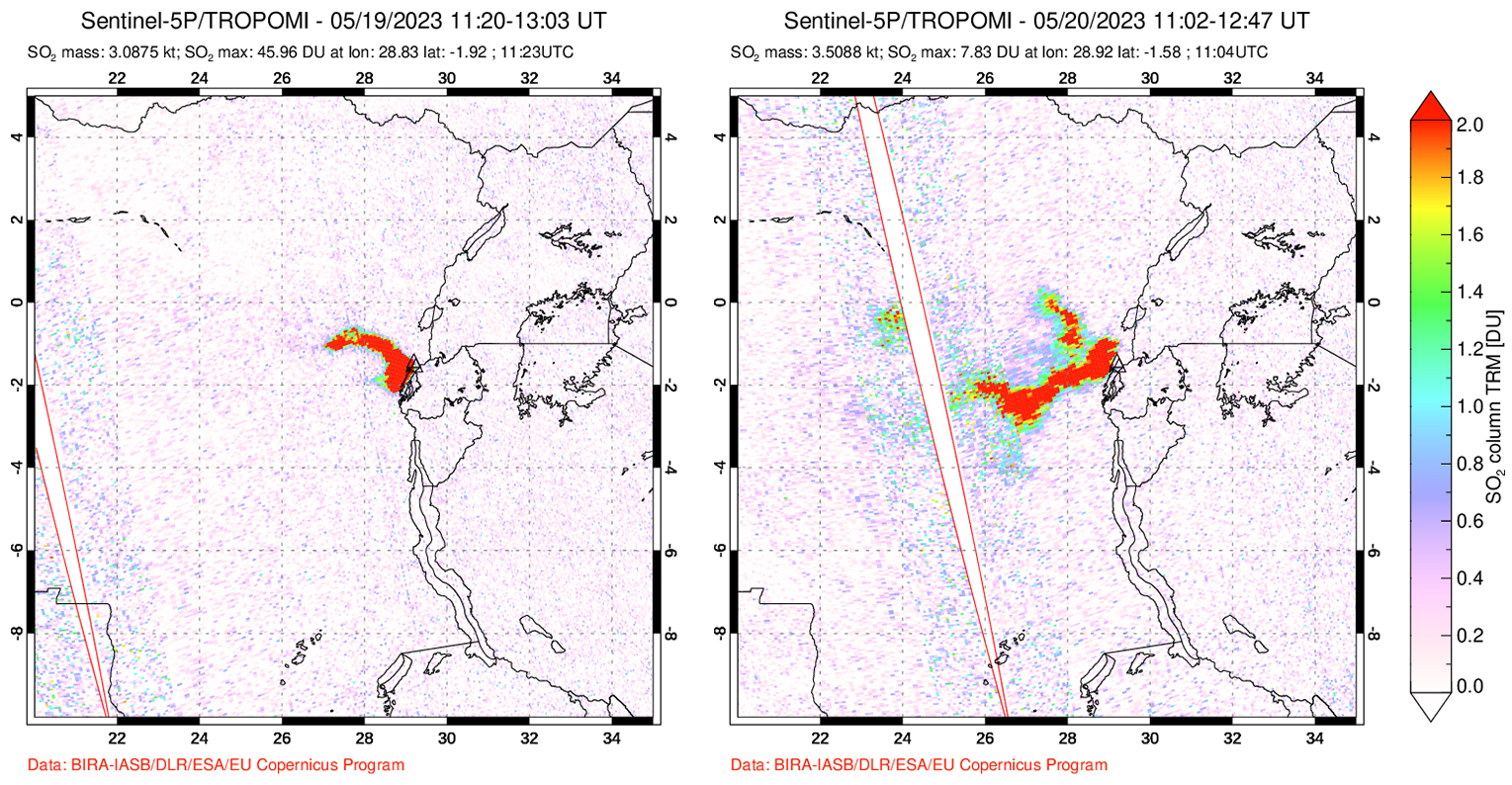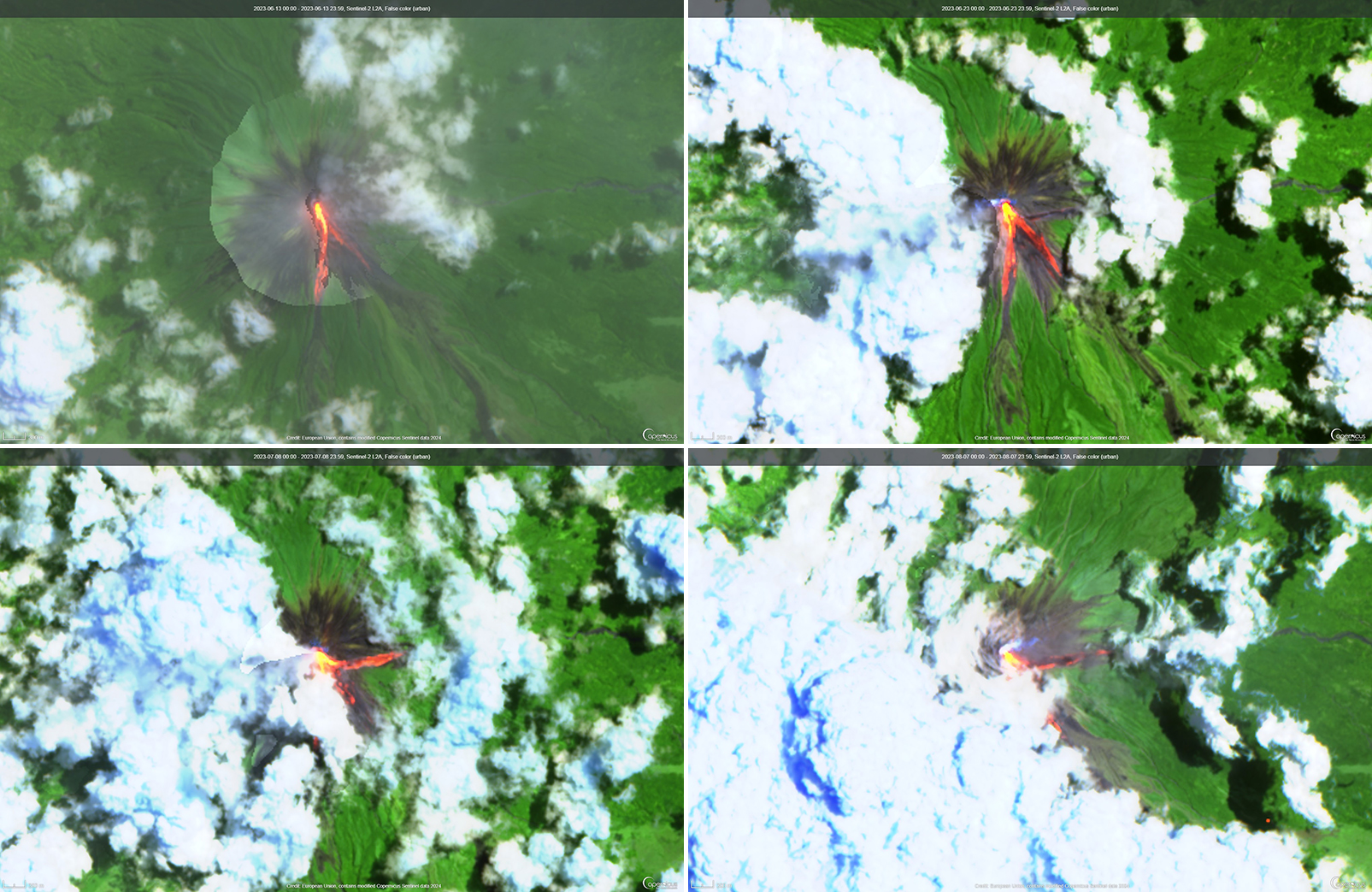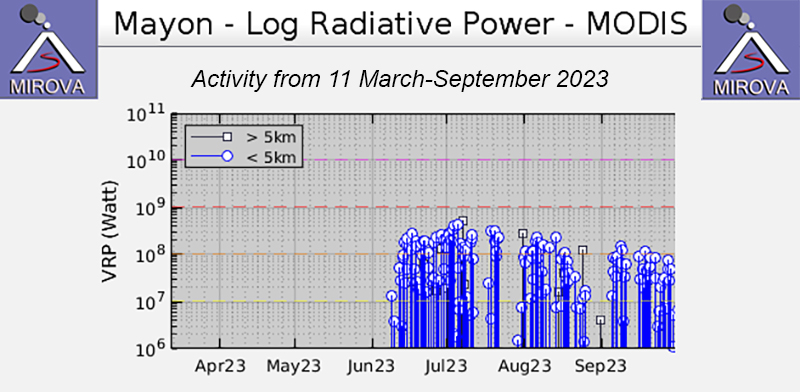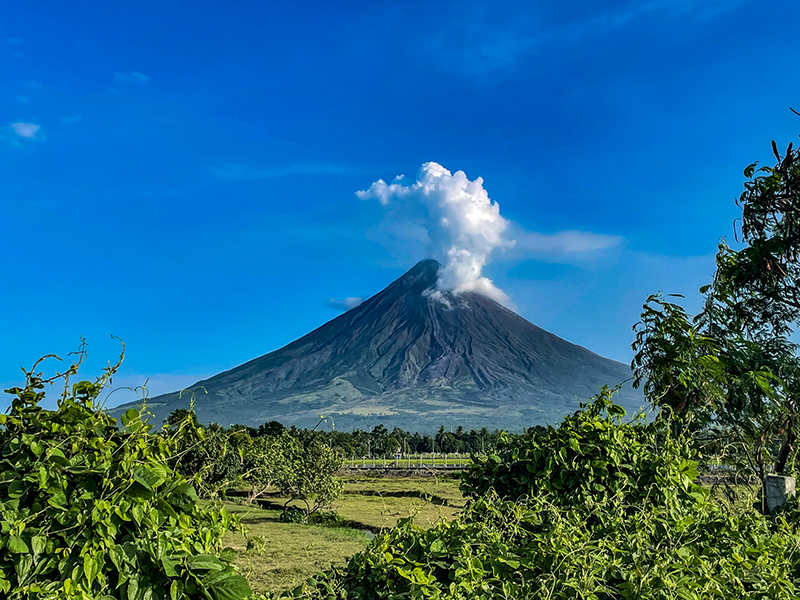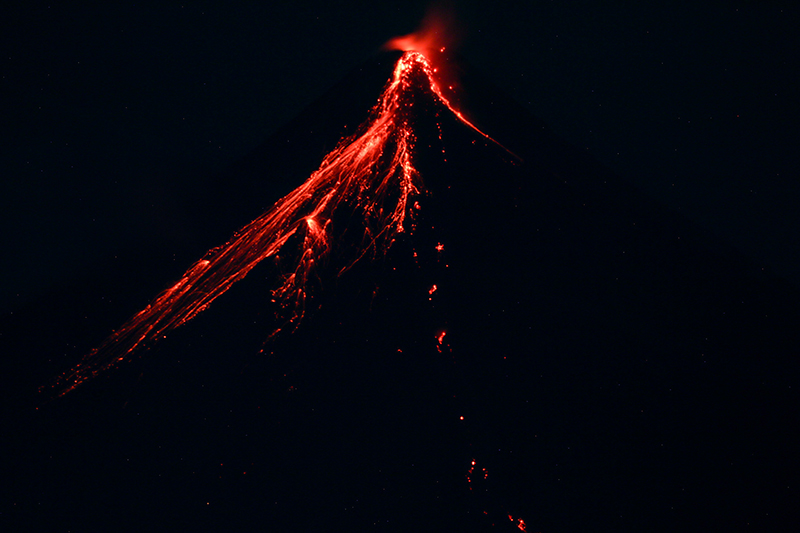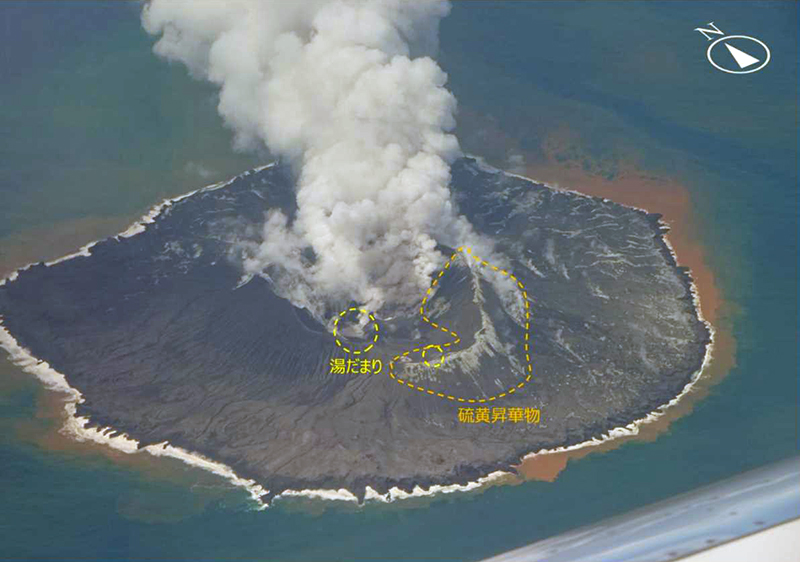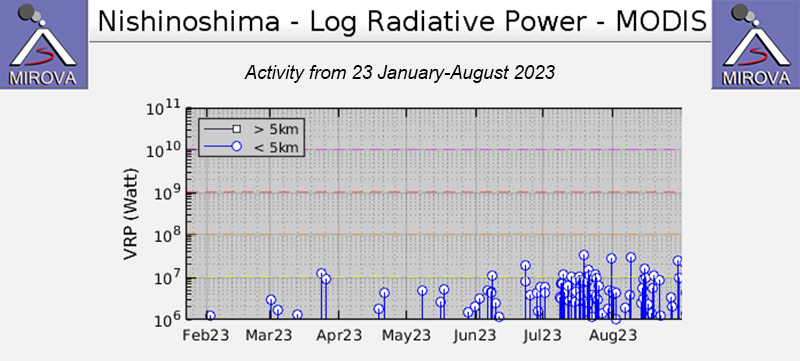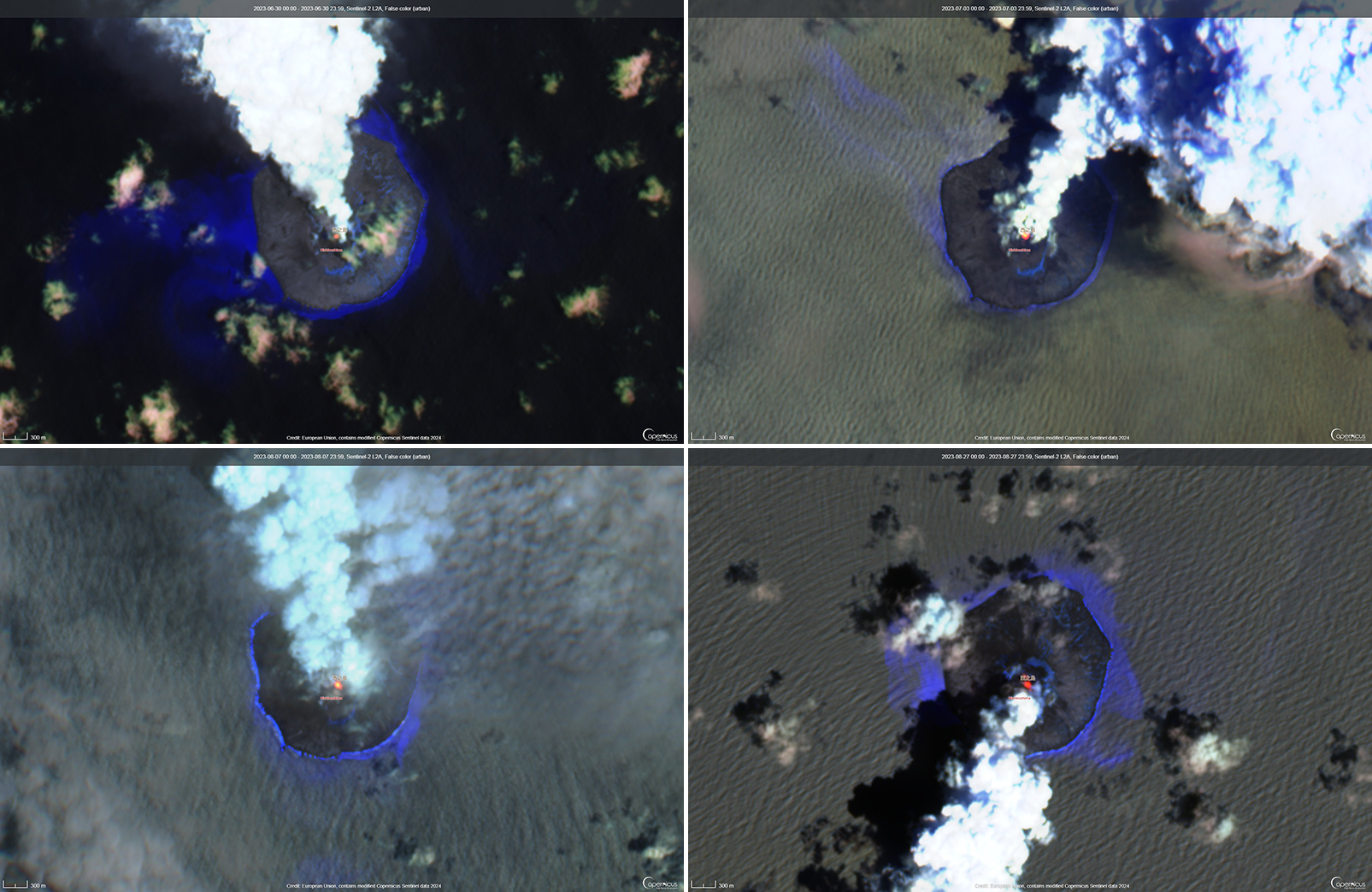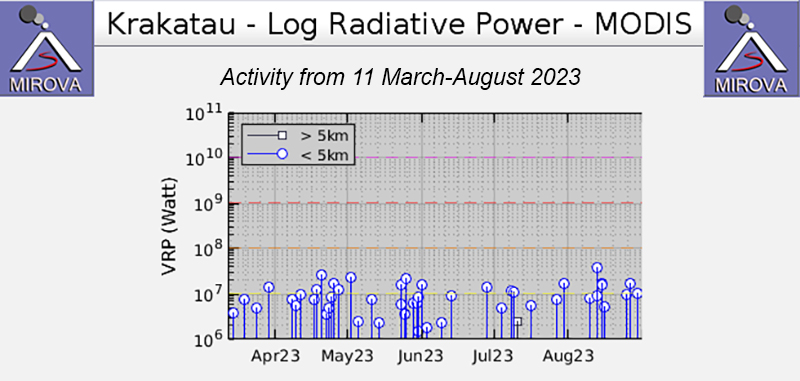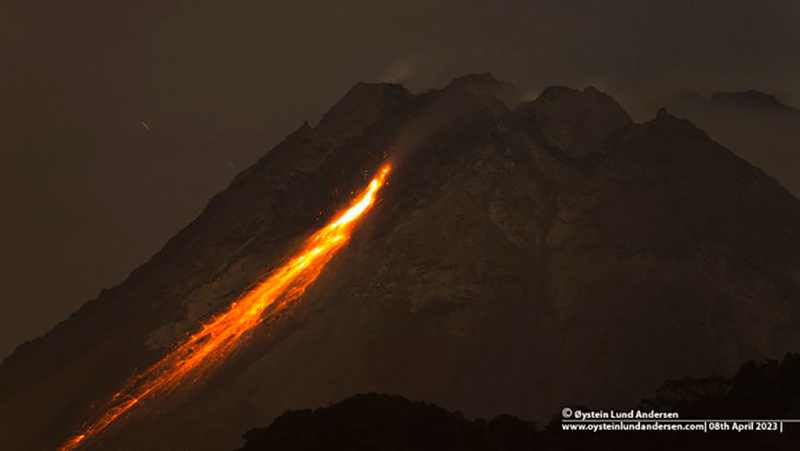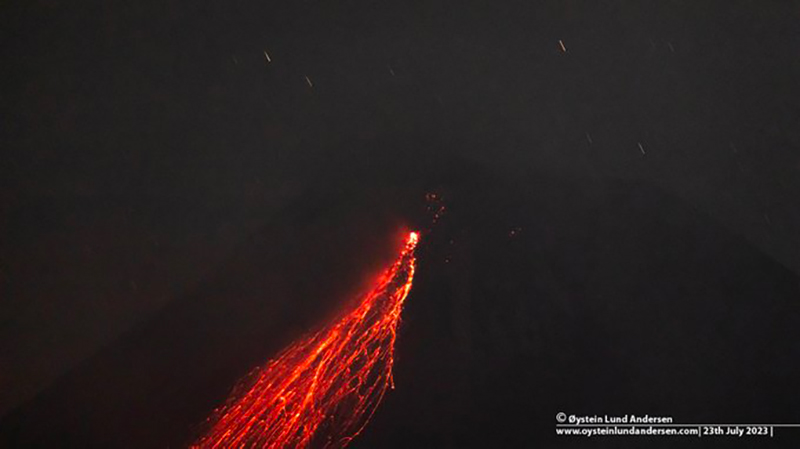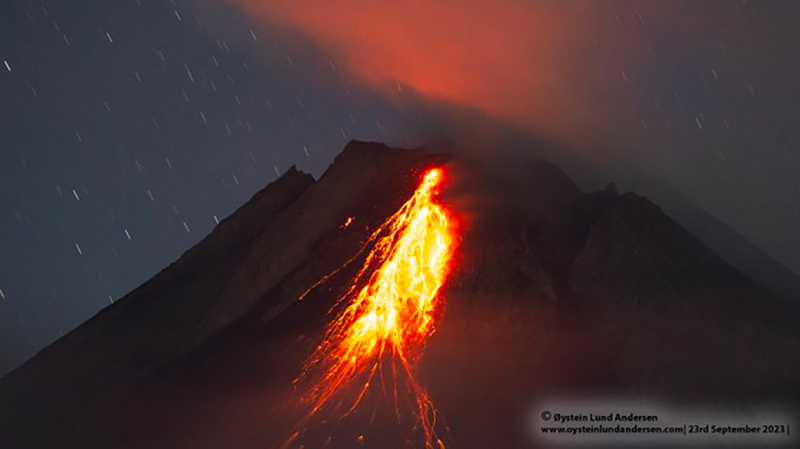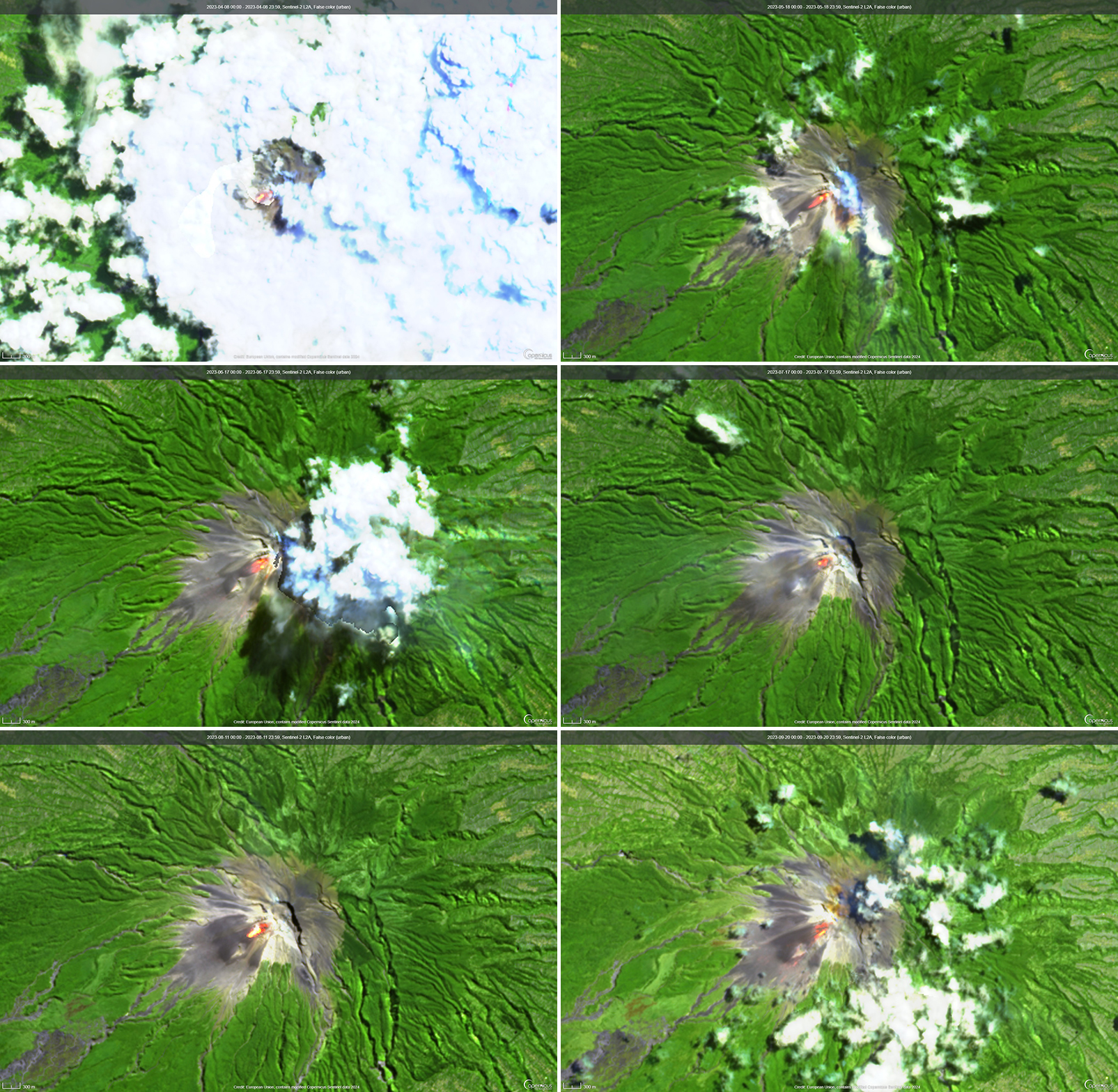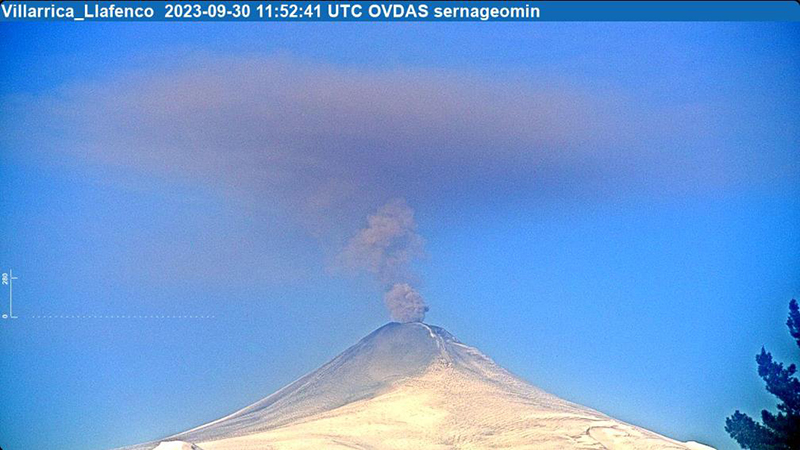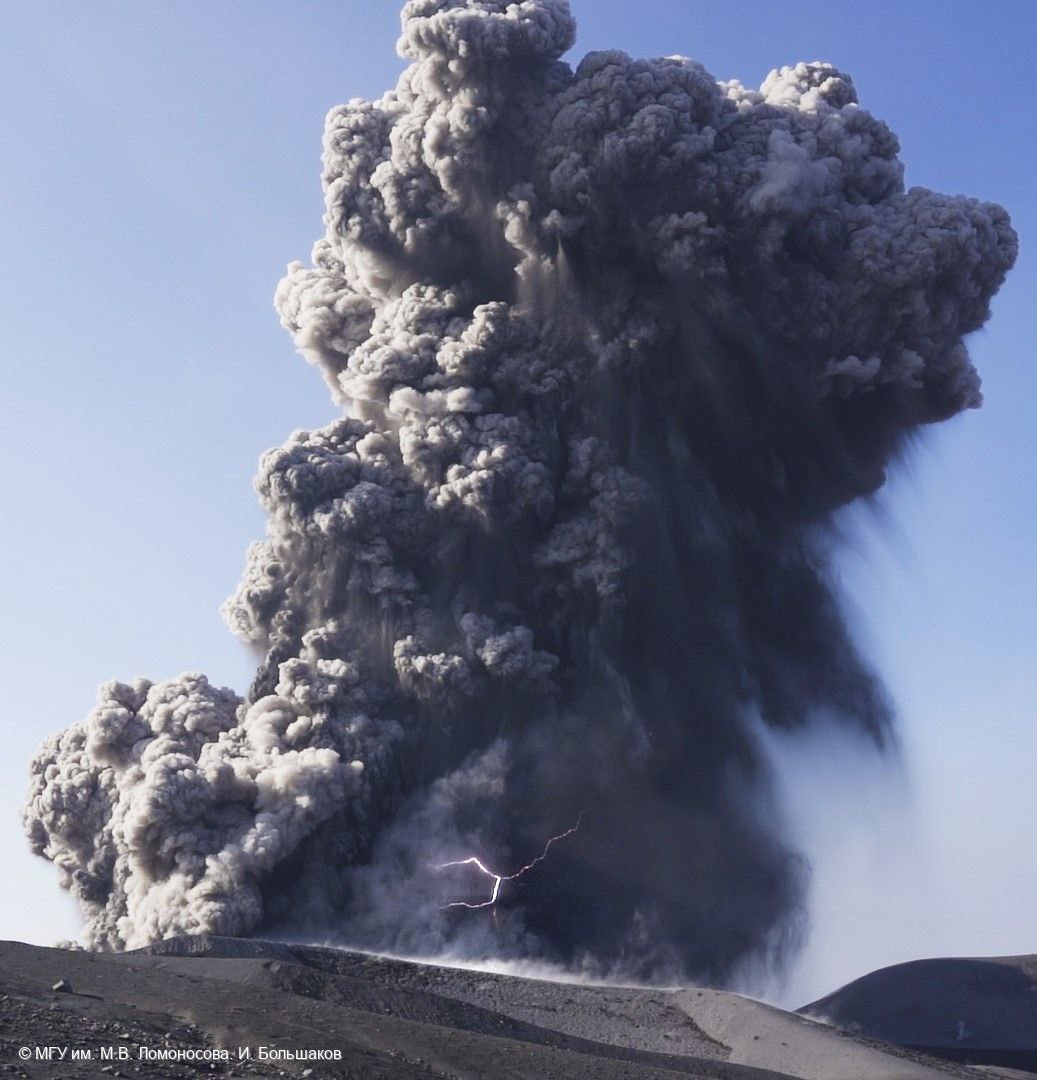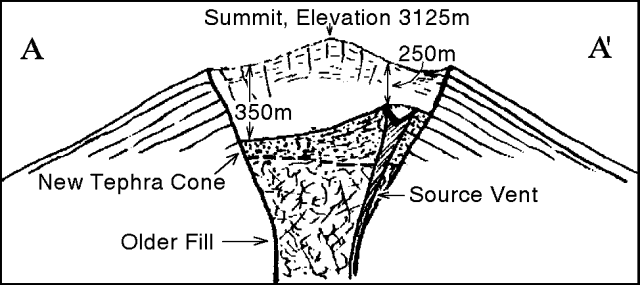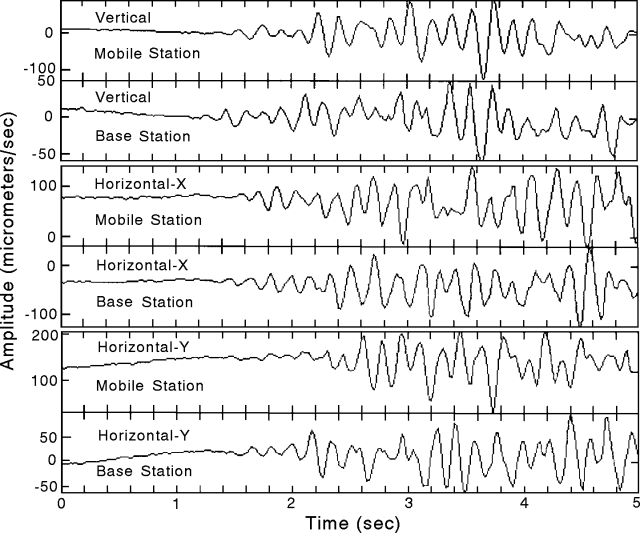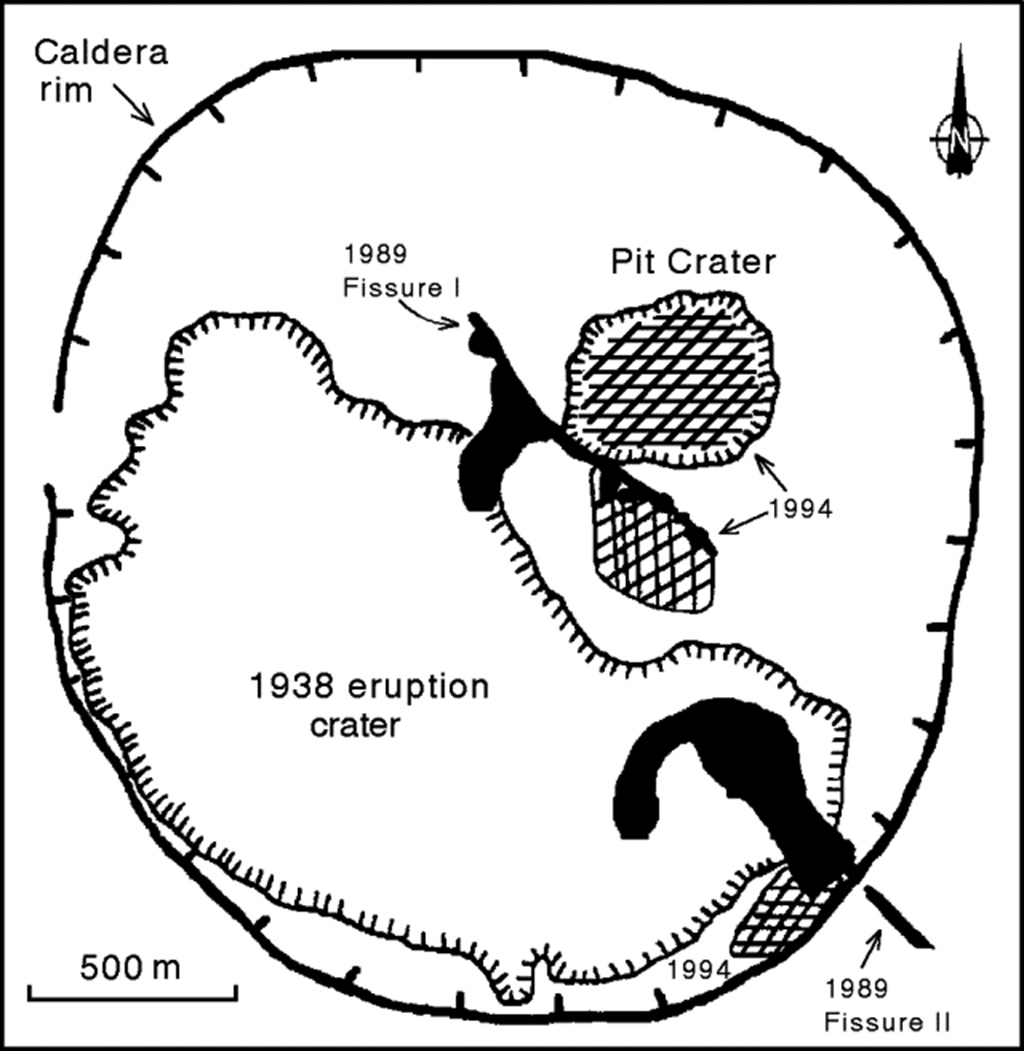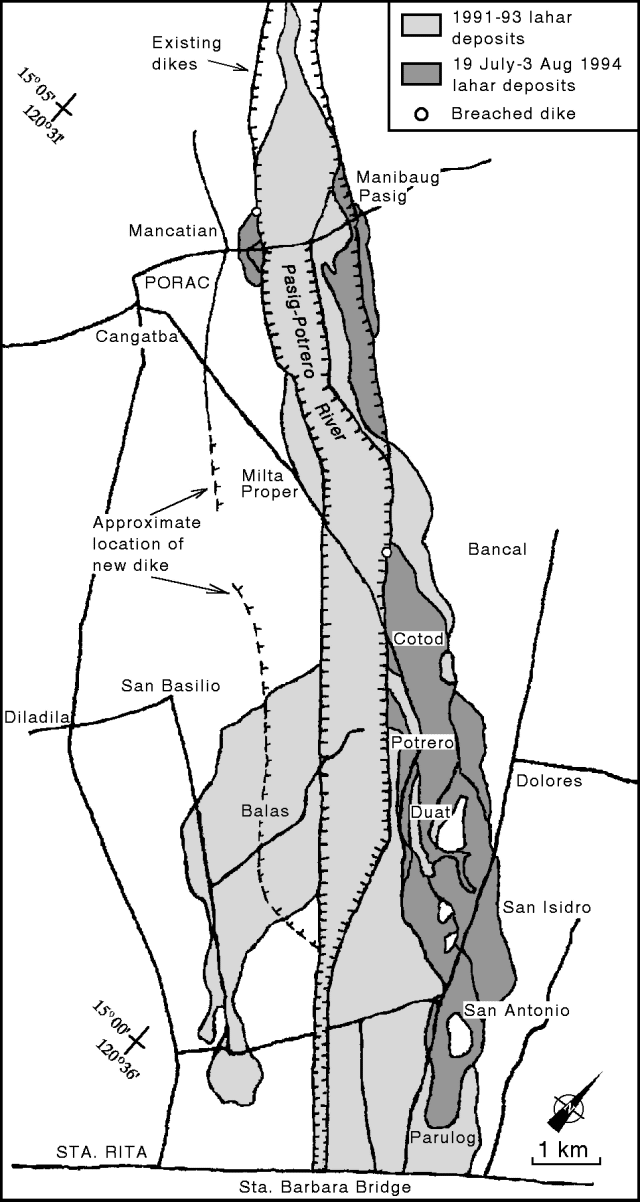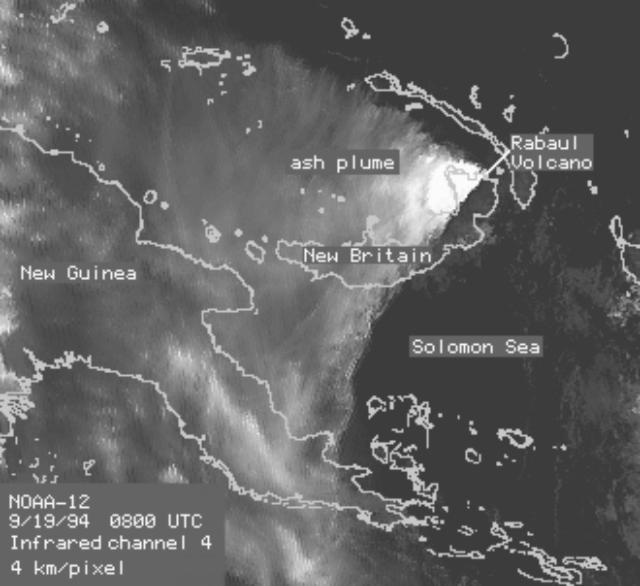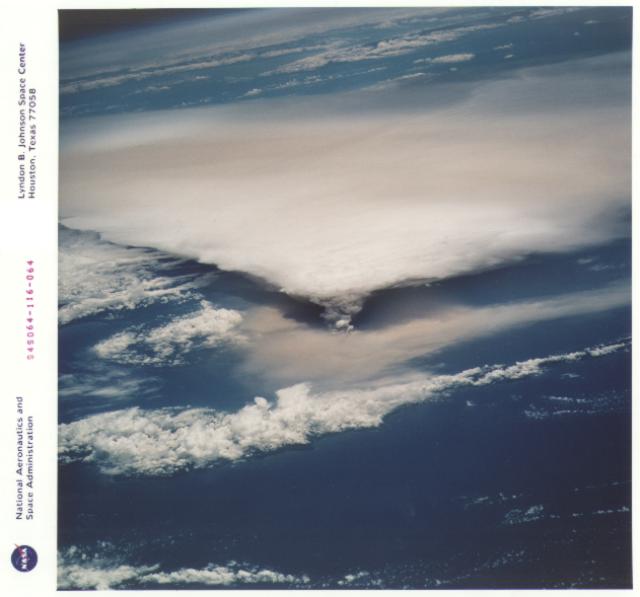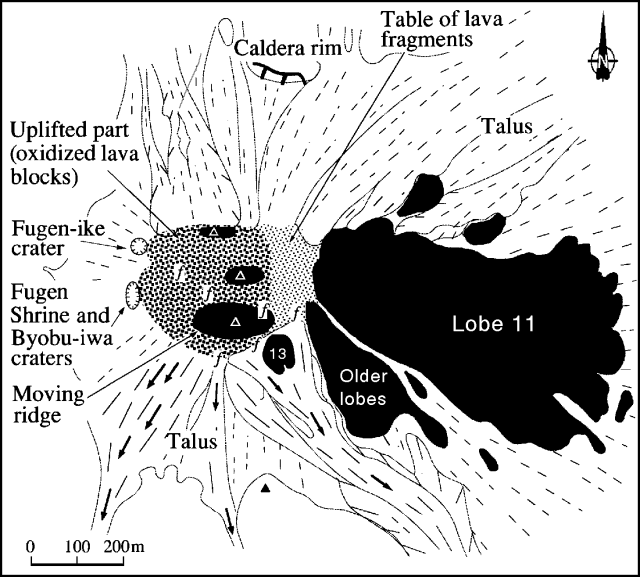Recently Published Bulletin Reports
Erebus (Antarctica) Lava lake remains active; most thermal alerts recorded since 2019
Rincon de la Vieja (Costa Rica) Frequent phreatic explosions during July-December 2023
Bezymianny (Russia) Explosion on 18 October 2023 sends ash plume 8 km high; lava flows and incandescent avalanches
Kilauea (United States) Low-level lava effusions in the lava lake at Halema’uma’u during July-December 2022
Nyamulagira (DR Congo) Lava flows and thermal activity during May-October 2023
Bagana (Papua New Guinea) Explosions, ash plumes, ashfall, and lava flows during April-September 2023
Mayon (Philippines) Lava flows, pyroclastic flows, ash emissions, and seismicity during April-September 2023
Nishinoshima (Japan) Eruption plumes and gas-and-steam plumes during May-August 2023
Krakatau (Indonesia) White gas-and-steam plumes and occasional ash plumes during May-August 2023
Merapi (Indonesia) Frequent incandescent avalanches during April-September 2023
Villarrica (Chile) Strombolian activity, gas-and-ash emissions, and crater incandescence during April-September 2023
Ebeko (Russia) Moderate explosive activity with ash plumes continued during June-November 2023
Erebus (Antarctica) — January 2024  Cite this Report
Cite this Report
Erebus
Antarctica
77.53°S, 167.17°E; summit elev. 3794 m
All times are local (unless otherwise noted)
Lava lake remains active; most thermal alerts recorded since 2019
The lava lake in the summit crater of Erebus has been active since at least 1972. Located in Antarctica overlooking the McMurdo Station on Ross Island, it is the southernmost active volcano on the planet. Because of the remote location, activity is primarily monitored by satellites. This report covers activity during 2023.
The number of thermal alerts recorded by the Hawai'i Institute of Geophysics and Planetology’s MODVOLC Thermal Alerts System increased considerably in 2023 compared to the years 2020-2022 (table 9). In contrast to previous years, the MODIS instruments aboard the Aqua and Terra satellites captured data from Erebus every month during 2023. Consistent with previous years, the lowest number of anomalous pixels were recorded in January, November, and December.
Table 9. Number of monthly MODIS-MODVOLC thermal alert pixels recorded at Erebus during 2017-2023. See BGVN 42:06 for data from 2000 through 2016. The table was compiled using data provided by the HIGP – MODVOLC Thermal Alerts System.
| Year |
Jan |
Feb |
Mar |
Apr |
May |
Jun |
Jul |
Aug |
Sep |
Oct |
Nov |
Dec |
SUM |
| 2017 |
0 |
21 |
9 |
0 |
0 |
1 |
11 |
61 |
76 |
52 |
0 |
3 |
234 |
| 2018 |
0 |
21 |
58 |
182 |
55 |
17 |
137 |
172 |
103 |
29 |
0 |
0 |
774 |
| 2019 |
2 |
21 |
162 |
151 |
55 |
56 |
75 |
53 |
29 |
19 |
1 |
0 |
624 |
| 2020 |
0 |
2 |
16 |
18 |
4 |
4 |
1 |
3 |
18 |
3 |
1 |
6 |
76 |
| 2021 |
0 |
9 |
1 |
0 |
2 |
56 |
46 |
47 |
35 |
52 |
5 |
3 |
256 |
| 2022 |
1 |
13 |
55 |
22 |
15 |
32 |
39 |
19 |
31 |
11 |
0 |
0 |
238 |
| 2023 |
2 |
33 |
49 |
82 |
41 |
32 |
70 |
64 |
42 |
17 |
5 |
11 |
448 |
Sentinel-2 infrared images showed one or two prominent heat sources within the summit crater, accompanied by adjacent smaller sources, similar to recent years (see BGVN 46:01, 47:02, and 48:01). A unique image was obtained on 25 November 2023 by the OLI-2 (Operational Land Imager-2) on Landsat 9, showing the upper part of the volcano surrounded by clouds (figure 32).
Geologic Background. Mount Erebus, the world's southernmost historically active volcano, overlooks the McMurdo research station on Ross Island. It is the largest of three major volcanoes forming the crudely triangular Ross Island. The summit of the dominantly phonolitic volcano has been modified by one or two generations of caldera formation. A summit plateau at about 3,200 m elevation marks the rim of the youngest caldera, which formed during the late-Pleistocene and within which the modern cone was constructed. An elliptical 500 x 600 m wide, 110-m-deep crater truncates the summit and contains an active lava lake within a 250-m-wide, 100-m-deep inner crater; other lava lakes are sometimes present. The glacier-covered volcano was erupting when first sighted by Captain James Ross in 1841. Continuous lava-lake activity with minor explosions, punctuated by occasional larger Strombolian explosions that eject bombs onto the crater rim, has been documented since 1972, but has probably been occurring for much of the volcano's recent history.
Information Contacts: Hawai'i Institute of Geophysics and Planetology (HIGP) - MODVOLC Thermal Alerts System, School of Ocean and Earth Science and Technology (SOEST), Univ. of Hawai'i, 2525 Correa Road, Honolulu, HI 96822, USA (URL: http://modis.higp.hawaii.edu/); Copernicus Browser, Copernicus Data Space Ecosystem, European Space Agency (URL: https://dataspace.copernicus.eu/browser/); NASA Earth Observatory, EOS Project Science Office, NASA Goddard Space Flight Center, Goddard, Maryland, USA (URL: https://earthobservatory.nasa.gov/images/152134/erebus-breaks-through).
Rincon de la Vieja (Costa Rica) — January 2024  Cite this Report
Cite this Report
Rincon de la Vieja
Costa Rica
10.83°N, 85.324°W; summit elev. 1916 m
All times are local (unless otherwise noted)
Frequent phreatic explosions during July-December 2023
Rincón de la Vieja is a volcanic complex in Costa Rica with a hot convecting acid lake that exhibits frequent weak phreatic explosions, gas-and-steam emissions, and occasional elevated sulfur dioxide levels (BGVN 45:10, 46:03, 46:11). The current eruption period began June 2021. This report covers activity during July-December 2023 and is based on weekly bulletins and occasional daily reports from the Observatorio Vulcanologico Sismologica de Costa Rica-Universidad Nacional (OVSICORI-UNA).
Numerous weak phreatic explosions continued during July-December 2023, along with gas-and-steam emissions and plumes that rose as high as 3 km above the crater rim. Many weekly OVSICORI-UNA bulletins included the previous week's number of explosions and emissions (table 9). For many explosions, the time of explosion was given (table 10). Frequent seismic activity (long-period earthquakes, volcano-tectonic earthquakes, and tremor) accompanied the phreatic activity.
Table 9. Number of reported weekly phreatic explosions and gas-and-steam emissions at Rincón de la Vieja, July-December 2023. Counts are reported for the week before the Weekly Bulletin date; not all reports included these data. Courtesy of OVSICORI-UNA.
| OVSICORI Weekly Bulletin |
Number of explosions |
Number of emissions |
| 28 Jul 2023 |
6 |
14 |
| 4 Aug 2023 |
10 |
12 |
| 1 Sep 2023 |
13 |
11 |
| 22 Sep 2023 |
12 |
13 |
| 29 Sep 2023 |
6 |
11 |
| 6 Oct 2023 |
12 |
5 |
| 13 Oct 2023 |
7 |
9 |
| 20 Oct 2023 |
1 |
15 |
| 27 Oct 2023 |
3 |
23 |
| 3 Nov 2023 |
3 |
10 |
| 17 Nov 2023 |
0 |
Some |
| 24 Nov 2023 |
0 |
14 |
| 8 Dec 2023 |
4 |
16 |
| 22 Dec 2023 |
8 |
18 |
Table 10. Summary of activity at Rincón de la Vieja during July-December 2023. Weak phreatic explosions and gas emissions are noted where the time of explosion was indicated in the weekly or daily bulletins. Height of plumes or emissions are distance above the crater rim. Courtesy of OVSICORI-UNA.
| Date |
Time |
Description of Activity |
| 1 Jul 2023 |
0156 |
Explosion. |
| 2 Jul 2023 |
0305 |
Explosion. |
| 4 Jul 2023 |
0229, 0635 |
Event at 0635 produced a gas-and-steam plume that rose 700 m and drifted W; seen by residents in Liberia (21 km SW). |
| 9 Jul 2023 |
1843 |
Explosion. |
| 21 Jul 2023 |
0705 |
Explosion. |
| 26 Jul 2023 |
1807 |
Explosion. |
| 28 Jul 2023 |
0802 |
Explosion generated a gas-and-steam plume that rose 500 m. |
| 30 Jul 2023 |
1250 |
Explosion. |
| 31 Jul 2023 |
2136 |
Explosion. |
| 11 Aug 2023 |
0828 |
Explosion. |
| 18 Aug 2023 |
1304 |
Explosion. |
| 21 Aug 2023 |
1224 |
Explosion generated gas-and-steam plumes rose 500-600 m. |
| 22 Aug 2023 |
0749 |
Explosion generated gas-and-steam plumes rose 500-600 m. |
| 24 Aug 2023 |
1900 |
Explosion. |
| 25 Aug 2023 |
0828 |
Event produced a steam-and-gas plume that rose 3 km and drifted NW. |
| 27-28 Aug 2023 |
0813 |
Four small events; the event at 0813 on 28 August lasted two minutes and generated a steam-and-gas plume that rose 2.5 km. |
| 1 Sep 2023 |
1526 |
Explosion generated plume that rose 2 km and ejected material onto the flanks. |
| 2-3 Sep 2023 |
- |
Small explosions detected in infrasound data. |
| 4 Sep 2023 |
1251 |
Gas-and-steam plume rose 1 km and drifted W. |
| 7 Nov 2023 |
1113 |
Explosion. |
| 8 Nov 2023 |
0722 |
Explosion. |
| 12 Nov 2023 |
0136 |
Small gas emissions. |
| 14 Nov 2023 |
0415 |
Small gas emissions. |
According to OVSICORI-UNA, during July-October the average weekly sulfur dioxide (SO2) flux ranged from 68 to 240 tonnes/day. However, in mid-November the flux increased to as high as 334 tonnes/day, the highest value measured in recent years. The high SO2 flux in mid-November was also detected by the TROPOMI instrument on the Sentinel-5P satellite (figure 43).
Geologic Background. Rincón de la Vieja, the largest volcano in NW Costa Rica, is a remote volcanic complex in the Guanacaste Range. The volcano consists of an elongated, arcuate NW-SE-trending ridge constructed within the 15-km-wide early Pleistocene Guachipelín caldera, whose rim is exposed on the south side. Sometimes known as the "Colossus of Guanacaste," it has an estimated volume of 130 km3 and contains at least nine major eruptive centers. Activity has migrated to the SE, where the youngest-looking craters are located. The twin cone of Santa María volcano, the highest peak of the complex, is located at the eastern end of a smaller, 5-km-wide caldera and has a 500-m-wide crater. A Plinian eruption producing the 0.25 km3 Río Blanca tephra about 3,500 years ago was the last major magmatic eruption. All subsequent eruptions, including numerous historical eruptions possibly dating back to the 16th century, have been from the prominent active crater containing a 500-m-wide acid lake located ENE of Von Seebach crater.
Information Contacts: Observatorio Vulcanológico Sismológica de Costa Rica-Universidad Nacional (OVSICORI-UNA), Apartado 86-3000, Heredia, Costa Rica (URL: http://www.ovsicori.una.ac.cr/); NASA Global Sulfur Dioxide Monitoring Page, Atmospheric Chemistry and Dynamics Laboratory, NASA Goddard Space Flight Center (NASA/GSFC), 8800 Greenbelt Road, Goddard MD 20771, USA (URL: https://so2.gsfc.nasa.gov/).
Bezymianny (Russia) — November 2023  Cite this Report
Cite this Report
Bezymianny
Russia
55.972°N, 160.595°E; summit elev. 2882 m
All times are local (unless otherwise noted)
Explosion on 18 October 2023 sends ash plume 8 km high; lava flows and incandescent avalanches
Bezymianny, located on Russia’s Kamchatka Peninsula, has had eruptions since 1955 characterized by dome growth, explosions, pyroclastic flows, ash plumes, and ashfall. Activity during November 2022-April 2023 included gas-and-steam emissions, lava dome collapses generating avalanches, and persistent thermal activity. Similar eruptive activity continued from May through October 2023, described here based on information from weekly and daily reports of the Kamchatka Volcano Eruptions Response Team (KVERT), notices from Tokyo VAAC (Volcanic Ash Advisory Center), and from satellite data.
Overall activity decreased after the strong period of activity in late March through April 2023, which included ash explosions during 29 March and 7-8 April 2023 that sent plumes as high as 10-12 km altitude, along with dome growth and lava flows (BGVN 48:05). This reduced activity can be seen in the MIROVA thermal detection system graph (figure 56), which was consistent with data from the MODVOLC thermal detection system and with Sentinel-2 satellite images that showed persistent hotspots in the summit crater when conditions allowed observations. A renewed period of strong activity began in mid-October 2023.
Activity increased significantly on 17 October 2023 when large collapses began during 0700-0830 on the E flanks of the lava dome and continued to after 0930 the next day (figure 57). Ash plumes rose to an altitude of 4.5-5 km, extending 220 km NNE by 18 October. A large explosion at 1630 on 18 October produced an ash plume that rose to an altitude of 11 km (8 km above the summit) and drifted NNE and then NW, extending 900 km NW within two days at an altitude of 8 km. Minor ashfall was noted in Kozyrevsk (45 km WNW). At 0820 on 20 October an ash plume was identified in satellite images drifting 100 km ENE at altitudes of 4-4.5 km.
Lava flows and hot avalanches from the dome down the SE flank continued over the next few days, including 23 October when clear conditions allowed good observations (figures 58 and 59). A large thermal anomaly was observed over the volcano through 24 October, and in the summit crater on 30 October (figure 60). Strong fumarolic activity continued, with numerous avalanches and occasional incandescence. By the last week of October, volcanic activity had decreased to a level consistent with that earlier in the reporting period.
Aviation warnings were frequently updated during 17-20 October. KVERT issued a Volcano Observatory Notice for Aviation (VONA) on 17 October at 1419 and 1727 (0219 and 0527 UTC) raising the Aviation Color Code (ACC) from Yellow to Orange (second highest level). The next day, KVERT issued a VONA at 1705 (0505 UTC) raising the ACC to Red (highest level) but lowered it back to Orange at 2117 (0917 UTC). After another decrease to Yellow and back to Orange, the ACC was reduced to Yellow on 20 October at 1204 (0004 UTC). In addition, the Tokyo VAAC issued a series of Volcanic Ash Advisories beginning on 16 October and continuing through 30 October.
Geologic Background. The modern Bezymianny, much smaller than its massive neighbors Kamen and Kliuchevskoi on the Kamchatka Peninsula, was formed about 4,700 years ago over a late-Pleistocene lava-dome complex and an edifice built about 11,000-7,000 years ago. Three periods of intensified activity have occurred during the past 3,000 years. The latest period, which was preceded by a 1,000-year quiescence, began with the dramatic 1955-56 eruption. This eruption, similar to that of St. Helens in 1980, produced a large open crater that was formed by collapse of the summit and an associated lateral blast. Subsequent episodic but ongoing lava-dome growth, accompanied by intermittent explosive activity and pyroclastic flows, has largely filled the 1956 crater.
Information Contacts: Kamchatka Volcanic Eruptions Response Team (KVERT), Far Eastern Branch, Russian Academy of Sciences, 9 Piip Blvd., Petropavlovsk-Kamchatsky, 683006, Russia (URL: http://www.kscnet.ru/ivs/kvert/); Kamchatka Volcanological Station, Kamchatka Branch of Geophysical Survey, (KB GS RAS), Klyuchi, Kamchatka Krai, Russia (URL: http://volkstat.ru/); Tokyo Volcanic Ash Advisory Center (VAAC), 1-3-4 Otemachi, Chiyoda-ku, Tokyo 100-8122, Japan (URL: http://ds.data.jma.go.jp/svd/vaac/data/); Hawai'i Institute of Geophysics and Planetology (HIGP) - MODVOLC Thermal Alerts System, School of Ocean and Earth Science and Technology (SOEST), Univ. of Hawai'i, 2525 Correa Road, Honolulu, HI 96822, USA (URL: http://modis.higp.hawaii.edu/); MIROVA (Middle InfraRed Observation of Volcanic Activity), a collaborative project between the Universities of Turin and Florence (Italy) supported by the Centre for Volcanic Risk of the Italian Civil Protection Department (URL: http://www.mirovaweb.it/); Copernicus Browser, Copernicus Data Space Ecosystem, European Space Agency (URL: https://dataspace.copernicus.eu/browser/).chr
Kilauea (United States) — January 2023  Cite this Report
Cite this Report
Kilauea
United States
19.421°N, 155.287°W; summit elev. 1222 m
All times are local (unless otherwise noted)
Low-level lava effusions in the lava lake at Halema’uma’u during July-December 2022
Kīlauea is the southeastern-most volcano in Hawaii and overlaps the E flank of the Mauna Loa volcano. Its East Rift Zone (ERZ) has been intermittently active for at least 2,000 years. An extended eruption period began in January 1983 and was characterized by open lava lakes and lava flows from the summit caldera and the East Rift Zone. During May 2018 magma migrated into the Lower East Rift Zone (LERZ) and opened 24 fissures along a 6-km-long NE-trending fracture zone that produced lava flows traveling in multiple directions. As lava emerged from the fissures, the lava lake at Halema'uma'u drained and explosions sent ash plumes to several kilometers altitude (BGVN 43:10).
The current eruption period started during September 2021 and has recently been characterized by lava effusions, spatter, and sulfur dioxide emissions in the active Halema’uma’u lava lake (BGVN 47:08). Lava effusions, some spatter, and sulfur dioxide emissions have continued during this reporting period of July through December 2022 using daily reports, volcanic activity notices, and abundant photo, map, and video data from the US Geological Survey's (USGS) Hawaiian Volcano Observatory (HVO).
Summary of activity during July-December 2022. Low-level effusions have continued at the western vent of the Halema’uma’u crater during July through early December 2022. Occasional weak ooze-outs (also called lava break outs) would occur along the margins of the crater floor. The overall level of the active lava lake throughout the reporting period gradually increased due to infilling, however it stagnated in mid-September (table 13). During September through November, activity began to decline, though lava effusions persisted at the western vent. By 9 December, the active part of the lava lake had completely crusted over, and incandescence was no longer visible.
Table 13. Summary of measurements taken during overflights at Kīlauea that show a gradual increase in the active lava lake level and the volume of lava effused since 29 September 2021. Lower activity was reported during September-October. Data collected during July-December 2022. Courtesy of HVO.
| Date: |
Level of the active lava lake (m): |
Cumulative volume of lava effused (million cubic meters): |
| 7 Jul 2022 |
130 |
95 |
| 19 Jul 2022 |
133 |
98 |
| 4 Aug 2022 |
136 |
102 |
| 16 Aug 2022 |
137 |
104 |
| 12 Sep 2022 |
143 |
111 |
| 5 Oct 2022 |
143 |
111 |
| 28 Oct 2022 |
143 |
111 |
Activity during July 2022. Lava effusions were reported from the western vent in the Halema’uma’u crater, along with occasional weak ooze-outs along the margins of the crater floor. The height of the lava lake was variable due to deflation-inflation tilt events; for example, the lake level dropped approximately 3-4 m during a summit deflation-inflation event reported on 1 July. Webcam images taken during the night of 6-12 July showed intermittent low-level spattering at the western vent that rose less than 10 m above the vent (figure 519). Measurements made during an overflight on 7 July indicated that the crater floor was infilled about 130 m and that 95 million cubic meters of lava had been effused since 29 September 2021. A single, relatively small lava ooze-out was active to the S of the lava lake. Around midnight on 8 July there were two brief periods of lava overflow onto the lake margins. On 9 July lava ooze-outs were reported near the SE and NE edges of the crater floor and during 10-11 July they occurred near the E, NE, and NW edges. On 16 July crater incandescence was reported, though the ooze-outs and spattering were not visible. On 18 July overnight webcam images showed incandescence in the western vent complex and two ooze-outs were reported around 0000 and 0200 on 19 July. By 0900 there were active ooze-outs along the SW edge of the crater floor. Measurements made from an overflight on 19 July indicated that the crater floor was infilled about 133 m and 98 million cubic meters of lava had erupted since 29 September 2021 (figure 520). On 20 July around 1600 active ooze-outs were visible along the N edge of the crater, which continued through the next day. Extensive ooze-outs occurred along the W margin during 24 July until 1900; on 26 July minor ooze-outs were noted along the N margin. Minor spattering was visible on 29 July along the E margin of the lake. The sulfur dioxide emission rates ranged 650-2,800 tons per day (t/d), the higher of which was measured on 8 July (figure 519).
Activity during August 2022. The eruption continued in the Halema’uma’u crater at the western vent. According to HVO the lava in the active lake remained at the level of the bounding levees. Occasional minor ooze-outs were observed along the margins of the crater floor. Strong nighttime crater incandescence was visible after midnight on 6 August over the western vent cone. During 6-7 August scattered small lava lobes were active along the crater floor and incandescence persisted above the western vent through 9 August. During 7-9 August HVO reported a single lava effusion source was active along the NW margin of the crater floor. Measurements from an overflight on 4 August indicated that the crater floor was infilled about 136 m total and that 102 million cubic meters of lava had been erupted since the start of the eruption. Lava breakouts were reported along the N, NE, E, S, and W margins of the crater during 10-16 August. Another overflight survey conducted on 16 August indicated that the crater floor infilled about 137 m and 104 million cubic meters of lava had been erupted since September 2021. Measured sulfur dioxide emissions rates ranged 1,150-2,450 t/d, the higher of which occurred on 8 August.
Activity during September 2022. During September, lava effusion continued from the western vent into the active lava lake and onto the crater floor. Intermittent minor ooze-outs were reported through the month. A small ooze-out was visible on the W crater floor margin at 0220 on 2 September, which showed decreasing surface activity throughout the day, but remained active through 3 September. On 3 September around 1900 a lava outbreak occurred along the NW margin of the crater floor but had stopped by the evening of 4 September. Field crews monitoring the summit lava lake on 9 September observed spattering on the NE margin of the lake that rose no higher than 10 m, before falling back onto the lava lake crust (figure 521). Overflight measurements on 12 September indicated that the crater floor was infilled a total of 143 m and 111 million cubic meters of lava had been erupted since September 2021. Extensive breakouts in the W and N part of the crater floor were reported at 1600 on 20 September and continued into 26 September. The active part of the lava lake dropped by 10 m while other parts of the crater floor dropped by several meters. Summit tiltmeters recorded a summit seismic swarm of more than 80 earthquakes during 1500-1800 on 21 September, which occurred about 1.5 km below Halema’uma’u; a majority of these were less than Mw 2. By 22 September the active part of the lava lake was infilled about 2 m. On 23 September the western vent areas exhibited several small spatter cones with incandescent openings, along with weak, sporadic spattering (figure 522). The sulfur dioxide emission rate ranged from 930 t/d to 2,000 t/d, the higher of which was measured on 6 September.
Activity during October 2022. Activity during October declined slightly compared to previous months, though lava effusions persisted from the western vent into the active lava lake and onto the crater floor during October (figure 523). Slight variations in the lava lake were noted throughout the month. HVO reported that around 0600 on 3 October the level of the lava lake has lowered slightly. Overflight measurements taken on 5 October indicated that the crater floor was infilled a total of about 143 m and that 111 million cubic meters of lava had been effused since September 2021. During 6-7 October the lake gradually rose 0.5 m. Sulfur dioxide measurements made on 22 October had an emission rate of 700 t/d. Another overflight taken on 28 October showed that there was little to no change in the elevation of the crater floor: the crater floor was infilled a total of 143 m and 111 million cubic meters of lava had erupted since the start of the eruption.
Activity during November 2022. Activity remained low during November, though HVO reported that lava from the western vent continued to effuse into the active lava lake and onto the crater floor throughout the month. The rate of sulfur dioxide emissions during November ranged from 300-600 t/d, the higher amount of which occurred on 9 November.
Activity during December 2022. Similar low activity was reported during December, with lava effusing from the western vent into the active lava lake and onto the crater floor. During 4-5 December the active part of the lava lake was slightly variable in elevation and fluctuated within 1 m. On 9 December HVO reported that lava was no longer erupting from the western vent in the Halema’uma’u crater and that sulfur dioxide emissions had returned to near pre-eruption background levels; during 10-11 December, the lava lake had completely crusted over, and no incandescence was visible (figure 524). Time lapse camera images covering the 4-10 December showed that the crater floor showed weak deflation and no inflation. Some passive events of crustal overturning were reported during 14-15 December, which brought fresh incandescent lava to the lake surface. The sulfur dioxide emission rate was approximately 200 t/d on 14 December. A smaller overturn event on 17 December and another that occurred around 0000 and into the morning of 20 December were also detected. A small seismic swarm was later detected on 30 December.
Geologic Background. Kilauea overlaps the E flank of the massive Mauna Loa shield volcano in the island of Hawaii. Eruptions are prominent in Polynesian legends; written documentation since 1820 records frequent summit and flank lava flow eruptions interspersed with periods of long-term lava lake activity at Halemaumau crater in the summit caldera until 1924. The 3 x 5 km caldera was formed in several stages about 1,500 years ago and during the 18th century; eruptions have also originated from the lengthy East and Southwest rift zones, which extend to the ocean in both directions. About 90% of the surface of the basaltic shield volcano is formed of lava flows less than about 1,100 years old; 70% of the surface is younger than 600 years. The long-term eruption from the East rift zone between 1983 and 2018 produced lava flows covering more than 100 km2, destroyed hundreds of houses, and added new coastline.
Information Contacts: Hawaiian Volcano Observatory (HVO), U.S. Geological Survey, PO Box 51, Hawai'i National Park, HI 96718, USA (URL: http://hvo.wr.usgs.gov/).
Nyamulagira (DR Congo) — November 2023  Cite this Report
Cite this Report
Nyamulagira
DR Congo
1.408°S, 29.2°E; summit elev. 3058 m
All times are local (unless otherwise noted)
Lava flows and thermal activity during May-October 2023
Nyamulagira (also known as Nyamuragira) is a shield volcano in the Democratic Republic of Congo with the summit truncated by a small 2 x 2.3 km caldera with walls up to about 100 m high. Documented eruptions have occurred within the summit caldera, as well as from numerous flank fissures and cinder cones. The current eruption period began in April 2018 and has more recently been characterized by summit crater lava flows and thermal activity (BGVN 48:05). This report describes lava flows and variable thermal activity during May through October 2023, based on information from the Observatoire Volcanologique de Goma (OVG) and various satellite data.
Lava lake activity continued during May. The MIROVA (Middle InfraRed Observation of Volcanic Activity) system recorded moderate-to-strong thermal activity throughout the reporting period; activity was more intense during May and October and relatively weaker from June through September (figure 95). The MODVOLC thermal algorithm, detected a total of 209 thermal alerts. There were 143 hotspots detected during May, eight during June, nine during September, and 49 during October. This activity was also reflected in infrared satellite images, where a lava flow was visible in the NW part of the crater on 7 May and strong activity was seen in the center of the crater on 4 October (figure 96). Another infrared satellite image taken on 12 May showed still active lava flows along the NW margin of the crater. According to OVG lava effusions were active during 7-29 May and moved to the N and NW parts of the crater beginning on 9 May. Strong summit crater incandescence was visible from Goma (27 km S) during the nights of 17, 19, and 20 May (figure 97). On 17 May there was an increase in eruptive activity, which peaked at 0100 on 20 May. Notable sulfur dioxide plumes drifted NW and W during 19-20 May (figure 98). Drone footage acquired in partnership with the USGS (United States Geological Survey) on 20 May captured images of narrow lava flows that traveled about 100 m down the W flank (figure 99). Data from the Rumangabo seismic station indicated a decreasing trend in activity during 17-21 May. Although weather clouds prevented clear views of the summit, a strong thermal signature on the NW flank was visible in an infrared satellite image on 22 May, based on an infrared satellite image. On 28 May the lava flows on the upper W flank began to cool and solidify. By 29 May seismicity returned to levels similar to those recorded before the 17 May increase. Lava effusion continued but was confined to the summit crater; periodic crater incandescence was observed.
Low-level activity was noted during June through October. On 1 June OVG reported that seismicity remained at lower levels and that crater incandescence had been absent for three days, though infrared satellite imagery showed continued lava effusion in the summit crater. The lava flows on the flanks covered an estimated 0.6 km2. Satellite imagery continued to show thermal activity confined to the lava lake through October (figure 96), although no lava flows or significant sulfur dioxide emissions were reported.
Geologic Background. Africa's most active volcano, Nyamulagira (also known as Nyamuragira), is a massive high-potassium basaltic shield about 25 km N of Lake Kivu and 13 km NNW of the steep-sided Nyiragongo volcano. The summit is truncated by a small 2 x 2.3 km caldera that has walls up to about 100 m high. Documented eruptions have occurred within the summit caldera, as well as from the numerous flank fissures and cinder cones. A lava lake in the summit crater, active since at least 1921, drained in 1938, at the time of a major flank eruption. Recent lava flows extend down the flanks more than 30 km from the summit as far as Lake Kivu; extensive lava flows from this volcano have covered 1,500 km2 of the western branch of the East African Rift.
Information Contacts: Observatoire Volcanologique de Goma (OVG), Departement de Geophysique, Centre de Recherche en Sciences Naturelles, Lwiro, D.S. Bukavu, DR Congo; Hawai'i Institute of Geophysics and Planetology (HIGP) - MODVOLC Thermal Alerts System, School of Ocean and Earth Science and Technology (SOEST), Univ. of Hawai'i, 2525 Correa Road, Honolulu, HI 96822, USA (URL: http://modis.higp.hawaii.edu/); MIROVA (Middle InfraRed Observation of Volcanic Activity), a collaborative project between the Universities of Turin and Florence (Italy) supported by the Centre for Volcanic Risk of the Italian Civil Protection Department (URL: http://www.mirovaweb.it/); NASA Global Sulfur Dioxide Monitoring Page, Atmospheric Chemistry and Dynamics Laboratory, NASA Goddard Space Flight Center (NASA/GSFC), 8800 Greenbelt Road, Goddard, Maryland, USA (URL: https://so2.gsfc.nasa.gov/); Copernicus Browser, Copernicus Data Space Ecosystem, European Space Agency (URL: https://dataspace.copernicus.eu/browser/); Charles Balagizi, Goma Volcano Observatory, Departement de Geophysique, Centre de Recherche en Sciences Naturelles, Lwiro, D.S. Bukavu, DR Congo.
Bagana (Papua New Guinea) — October 2023  Cite this Report
Cite this Report
Bagana
Papua New Guinea
6.137°S, 155.196°E; summit elev. 1855 m
All times are local (unless otherwise noted)
Explosions, ash plumes, ashfall, and lava flows during April-September 2023
The remote volcano of Bagana is located in central Bougainville Island, Papua New Guinea. Recorded eruptions date back to 1842 and activity has consisted of effusive activity that has built a small lava dome in the summit crater and occasional explosions that produced pyroclastic flows. The most recent eruption has been ongoing since February 2000 and has produced occasional explosions, ash plumes, and lava flows. More recently, activity has been characterized by ongoing effusive activity and ash emissions (BGVN 48:04). This report updates activity from April through September 2023 that has consisted of explosions, ash plumes, ashfall, and lava flows, using information from the Darwin Volcanic Ash Advisory Center (VAAC) and satellite data.
An explosive eruption was reported on 7 July that generated a large gas-and-ash plume to high altitudes and caused significant ashfall in local communities; the eruption plume had reached upper tropospheric (16-18 km altitude) altitudes by 2200, according to satellite images. Sulfur dioxide plumes were detected in satellite images on 8 July and indicated that the plume was likely a mixture of gas, ice, and ash. A report issued by the Autonomous Bougainville Government (ABG) (Torokina District, Education Section) on 10 July noted that significant ash began falling during 2000-2100 on 7 July and covered most areas in the Vuakovi, Gotana (9 km SW), Koromaketo, Laruma (25 km W) and Atsilima (27 km NW) villages. Pyroclastic flows also occurred, according to ground-based reports; small deposits confined to one drainage were inspected by RVO during an overflight on 17 July and were confirmed to be from the 7 July event. Ashfall continued until 10 July and covered vegetation, which destroyed bushes and gardens and contaminated rivers and streams.
RVO reported another eruption on 14 July. The Darwin VAAC stated that an explosive event started around 0830 on 15 July and produced an ash plume that rose to 16.5 km altitude by 1000 and drifted N, according to satellite images. The plume continued to drift N and remained visible through 1900, and by 2150 it had dissipated.
Ashfall likely from both the 7 and 15 July events impacted about 8,111 people in Torokina (20 km SW), including Tsito/Vuakovi, Gotana, Koromaketo, Kenaia, Longkogari, Kenbaki, Piva (13 km SW), and Atsinima, and in the Tsitovi district, according to ABG. Significant ashfall was also reported in Ruruvu (22 km N) in the Wakunai District of Central Bougainville, though the thickness of these deposits could not be confirmed. An evacuation was called for the villages in Wakunai, where heavy ashfall had contaminated water sources; the communities of Ruruvu, Togarau, Kakarapaia, Karauturi, Atao, and Kuritaturi were asked to evacuate to a disaster center at the Wakunai District Station, and communities in Torokina were asked to evacuate to the Piva District station. According to a news article, more than 7,000 people needed temporary accommodations, with about 1,000 people in evacuation shelters. Ashfall had deposited over a broad area, contaminating water supplies, affecting crops, and collapsing some roofs and houses in rural areas. Schools were temporarily shut down. Intermittent ash emissions continued through the end of July and drifted NNW, NW, and SW. Fine ashfall was reported on the coast of Torokina, and ash plumes also drifted toward Laruma and Atsilima.
A small explosive eruption occurred at 2130 on 28 July that ejected material from the crater vents, according to reports from Torokina, in addition to a lava flow that contained two lobes. A second explosion was detected at 2157. Incandescence from the lava flow was visible from Piva as it descended the W flank around 2000 on 29 July (figure 47). The Darwin VAAC reported that a strong thermal anomaly was visible in satellite images during 30-31 July and that ash emissions rose to 2.4 km altitude and drifted WSW on 30 July. A ground report from RVO described localized emissions at 0900 on 31 July.
The Darwin VAAC reported that ash plumes were identified in satellite imagery at 0800 and 1220 on 12 August and rose to 2.1 km and 3 km altitude and drifted NW and W, respectively. A news report stated that aid was sent to more than 6,300 people that were adversely affected by the eruption. Photos taken during 17-19 August showed ash emissions rising no higher than 1 km above the summit and drifting SE. A small explosion generated an ash plume during the morning of 19 August. Deposits from small pyroclastic flows were also captured in the photos. Satellite images captured lava flows and pyroclastic flow deposits. Two temporary seismic stations were installed near Bagana on 17 August at distances of 7 km WSW (Vakovi station) and 11 km SW (Kepox station). The Kepox station immediately started to record continuous, low-frequency background seismicity.
Satellite data. Little to no thermal activity was detected during April through mid-July 2023; only one anomaly was recorded during early April and one during early June, according to MIROVA (Middle InfraRed Observation of Volcanic Activity) data (figure 48). Thermal activity increased in both power and frequency during mid-July through September, although there were still some short gaps in detected activity. MODVOLC also detected increased thermal activity during August; thermal hotspots were detected a total of five times on 19, 20, and 27 August. Weak thermal anomalies were also captured in infrared satellite images on clear weather days throughout the reporting period on 7, 12, and 17 April, 27 May, 1, 6, 16, and 31 July, and 19 September (figure 48); a strong thermal anomaly was visible on 31 July. Distinct sulfur dioxide plumes that drifted generally NW were intermittently captured by the TROPOMI instrument on the Sentinel-5P satellite and sometimes exceeded two Dobson Units (DUs) (figure 49).
Geologic Background. Bagana volcano, in a remote portion of central Bougainville Island, is frequently active. This massive symmetrical cone was largely constructed by an accumulation of viscous andesitic lava flows. The entire edifice could have been constructed in about 300 years at its present rate of lava production. Eruptive activity is characterized by non-explosive effusion of viscous lava that maintains a small lava dome in the summit crater, although occasional explosive activity produces pyroclastic flows. Lava flows with tongue-shaped lobes up to 50 m thick and prominent levees descend the flanks on all sides.
Information Contacts: Rabaul Volcano Observatory (RVO), Geohazards Management Division, Department of Mineral Policy and Geohazards Management (DMPGM), PO Box 3386, Kokopo, East New Britain Province, Papua New Guinea; Darwin Volcanic Ash Advisory Centre (VAAC), Bureau of Meteorology, Northern Territory Regional Office, PO Box 40050, Casuarina, NT 0811, Australia (URL: http://www.bom.gov.au/info/vaac/); MIROVA (Middle InfraRed Observation of Volcanic Activity), a collaborative project between the Universities of Turin and Florence (Italy) supported by the Centre for Volcanic Risk of the Italian Civil Protection Department (URL: http://www.mirovaweb.it/); Hawai'i Institute of Geophysics and Planetology (HIGP) - MODVOLC Thermal Alerts System, School of Ocean and Earth Science and Technology (SOEST), Univ. of Hawai'i, 2525 Correa Road, Honolulu, HI 96822, USA (URL: http://modis.higp.hawaii.edu/); NASA Global Sulfur Dioxide Monitoring Page, Atmospheric Chemistry and Dynamics Laboratory, NASA Goddard Space Flight Center (NASA/GSFC), 8800 Greenbelt Road, Goddard, Maryland, USA (URL: https://so2.gsfc.nasa.gov/); Copernicus Browser, Copernicus Data Space Ecosystem, European Space Agency (URL: https://dataspace.copernicus.eu/browser/); Autonomous Bougainville Government, P.O Box 322, Buka, AROB, PNG (URL: https://abg.gov.pg/); Andrew Tupper (Twitter: @andrewcraigtupp); Simon Carn, Geological and Mining Engineering and Sciences, Michigan Technological University, 1400 Townsend Drive, Houghton, MI 49931, USA (URL: http://www.volcarno.com/, Twitter: @simoncarn); Radio NZ (URL: https://www.rnz.co.nz/news/pacific/494464/more-than-7-000-people-in-bougainville-need-temporary-accommodation-after-eruption); USAID, 1300 Pennsylvania Ave, NW, Washington DC 20004, USA (URL: https://www.usaid.gov/pacific-islands/press-releases/aug-08-2023-united-states-provides-immediate-emergency-assistance-support-communities-affected-mount-bagana-volcanic-eruptions).
Mayon (Philippines) — October 2023  Cite this Report
Cite this Report
Mayon
Philippines
13.257°N, 123.685°E; summit elev. 2462 m
All times are local (unless otherwise noted)
Lava flows, pyroclastic flows, ash emissions, and seismicity during April-September 2023
Mayon is located in the Philippines and has steep upper slopes capped by a small summit crater. Historical eruptions date back to 1616 CE that have been characterized by Strombolian eruptions, lava flows, pyroclastic flows, and mudflows. Eruptions mostly originated from a central conduit. Pyroclastic flows and mudflows have commonly descended many of the approximately 40 drainages that surround the volcano. The most recent eruption occurred during June through October 2022 and consisted of lava dome growth and gas-and-steam emissions (BGVN 47:12). A new eruption was reported during late April 2023 and has included lava flows, pyroclastic density currents, ash emissions, and seismicity. This report covers activity during April through September 2023 based on daily bulletins from the Philippine Institute of Volcanology and Seismology (PHIVOLCS).
During April through September 2023, PHIVOLCS reported near-daily rockfall events, frequent volcanic earthquakes, and sulfur dioxide measurements. Gas-and-steam emissions rose 100-900 m above the crater and drifted in different directions. Nighttime crater incandescence was often visible during clear weather and was accompanied by incandescent avalanches of material. Activity notably increased during June when lava flows were reported on the S, SE, and E flanks (figure 52). The MIROVA graph (Middle InfraRed Observation of Volcanic Activity) showed strong thermal activity coincident with these lava flows, which remained active through September (figure 53). According to the MODVOLC thermal algorithm, a total of 110 thermal alerts were detected during the reporting period: 17 during June, 40 during July, 27 during August, and 26 during September. During early June, pyroclastic density currents (PDCs) started to occur more frequently.
Low activity was reported during much of April and May; gas-and-steam emissions rose 100-900 m above the crater and generally drifted in different directions. A total of 52 rockfall events and 18 volcanic earthquakes were detected during April and 147 rockfall events and 13 volcanic events during May. Sulfur dioxide flux measurements ranged between 400-576 tons per day (t/d) during April, the latter of which was measured on 29 April and between 162-343 t/d during May, the latter of which was measured on 13 May.
Activity during June increased, characterized by lava flows, pyroclastic density currents (PDCs), crater incandescence and incandescent rockfall events, gas-and-steam emissions, and continued seismicity. Weather clouds often prevented clear views of the summit, but during clear days, moderate gas-and-steam emissions rose 100-2,500 m above the crater and drifted in multiple directions. A total of 6,237 rockfall events and 288 volcanic earthquakes were detected. The rockfall events often deposited material on the S and SE flanks within 700-1,500 m of the summit crater and ash from the events drifted SW, S, SE, NE, and E. Sulfur dioxide emissions ranged between 149-1,205 t/d, the latter of which was measured on 10 June. Short-term observations from EDM and electronic tiltmeter monitoring indicated that the upper slopes were inflating since February 2023. Longer-term ground deformation parameters based on EDM, precise leveling, continuous GPS, and electronic tilt monitoring indicated that the volcano remained inflated, especially on the NW and SE flanks. At 1000 on 5 June the Volcano Alert Level (VAL) was raised to 2 (on a 0-5 scale). PHIVOLCS noted that although low-level volcanic earthquakes, ground deformation, and volcanic gas emissions indicated unrest, the steep increase in rockfall frequency may indicate increased dome activity.
A total of 151 dome-collapse PDCs occurred during 8-9 and 11-30 June, traveled 500-2,000 m, and deposited material on the S flank within 2 km of the summit crater. During 8-9 June the VAL was raised to 3. At approximately 1947 on 11 June lava flow activity was reported; two lobes traveled within 500 m from the crater and deposited material on the S (Mi-isi), SE (Bonga), and E (Basud) flanks. Weak seismicity accompanied the lava flow and slight inflation on the upper flanks. This lava flow remained active through 30 June, moving down the S and SE flank as far as 2.5 km and 1.8 km, respectively and depositing material up to 3.3 km from the crater. During 15-16 June traces of ashfall from the PDCs were reported in Sitio Buga, Nabonton, City of Ligao and Purok, and San Francisco, Municipality of Guinobatan. During 28-29 June there were two PDCs generated by the collapse of the lava flow front, which generated a light-brown ash plume 1 km high. Satellite monitors detected significant concentrations of sulfur dioxide beginning on 29 June. On 30 June PDCs primarily affected the Basud Gully on the E flank, the largest of which occurred at 1301 and lasted eight minutes, based on the seismic record. Four PDCs generated between 1800 and 2000 that lasted approximately four minutes each traveled 3-4 km on the E flank and generated an ash plume that rose 1 km above the crater and drifted N and NW. Ashfall was recorded in Tabaco City.
Similar strong activity continued during July; slow lava effusion remained active on the S and SE flanks and traveled as far as 2.8 km and 2.8 km, respectively and material was deposited as far as 4 km from the crater. There was a total of 6,983 rockfall events and 189 PDCs that affected the S, SE, and E flanks. The volcano network detected a total of 2,124 volcanic earthquakes. Continuous gas-and-steam emissions rose 200-2,000 m above the crater and drifted in multiple directions. Sulfur dioxide emissions averaged 792-4,113 t/d, the latter of which was measured on 28 July. During 2-4 July three PDCs were generated from the collapse of the lava flow and resulting light brown plumes rose 200-300 m above the crater. Continuous tremor pulses were reported beginning at 1547 on 3 July through 7 July at 1200, at 2300 on 8 July and going through 0300 on 10 July, and at 2300 on 16 July, as recorded by the seismic network. During 6-9 July there were 10 lava flow-collapse-related PDCs that generated light brown plumes 300-500 m above the crater. During 10-11 July light ashfall was reported in some areas of Mabinit, Legazpi City, Budiao and Salvacion, Daraga, and Camalig, Albay. By 18 July the lava flow advanced 600 m on the E flank as well.
During 1733 on 18 July and 0434 on 19 July PHIVOLCS reported 30 “ashing” events, which are degassing events accompanied by audible thunder-like sounds and entrained ash at the crater, which produced short, dark plumes that drifted SW. These events each lasted 20-40 seconds, and plume heights ranged from 150-300 m above the crater, as recorded by seismic, infrasound, visual, and thermal monitors. Three more ashing events occurred during 19-20 July. Short-term observations from electronic tilt and GPS monitoring indicate deflation on the E lower flanks in early July and inflation on the NW middle flanks during the third week of July. Longer-term ground deformation parameters from EDM, precise leveling, continuous GPS, and electronic tilt monitoring indicated that the volcano was still generally inflated relative to baseline levels. A short-lived lava pulse lasted 28 seconds at 1956 on 21 July, which was accompanied by seismic and infrasound signals. By 22 July, the only lava flow that remained active was on the SE flank, and continued to extend 3.4 km, while those on the S and E flanks weakened markedly. One ashing event was detected during 30-31 July, whereas there were 57 detected during 31 July-1 August; according to PHIVOLCS beginning at approximately 1800 on 31 July eruptive activity was dominated by phases of intermittent ashing, as well as increased in the apparent rates of lava effusion from the summit crater. The ashing phases consisted of discrete events recorded as low-frequency volcanic earthquakes (LFVQ) typically 30 seconds in duration, based on seismic and infrasound signals. Gray ash plume rose 100 m above the crater and generally drifted NE. Shortly after these ashing events began, new lava began to effuse rapidly from the crater, feeding the established flowed on the SE, E, and E flanks and generating frequent rockfall events.
Intensified unrest persisted during August. There was a total of 4,141 rockfall events, 2,881 volcanic earthquakes, which included volcanic tremor events, 32 ashing events, and 101 PDCs detected throughout the month. On clear weather days, gas-and-steam emissions rose 300-1,500 m above the crater and drifted in different directions (figure 54). Sulfur dioxide emissions averaged 735-4,756 t/d, the higher value of which was measured on 16 August. During 1-2 August the rate of lava effusion decreased, but continued to feed the flows on the SE, S, and E flanks, maintaining their advances to 3.4 km, 2.8 km, and 1.1 km from the crater, respectively (figure 55). Rockfall and PDCs generated by collapses at the lava flow margins and from the summit dome deposited material within 4 km of the crater. During 3-4 August there were 10 tremor events detected that lasted 1-4 minutes. Short-lived lava pulse lasted 35 seconds and was accompanied by seismic and infrasound signals at 0442 on 6 August. Seven collapses were recorded at the front of the lava flow during 12-14 August.
During September, similar activity of slow lava effusion, PDCs, gas-and-steam emissions, and seismicity continued. There was a total of 4,452 rockfall events, 329 volcanic earthquakes, which included volcanic tremor events, two ashing events, and 85 PDCs recorded throughout the month. On clear weather days, gas-and-steam emissions rose 100-1,500 m above the crater and drifted in multiple directions. Sulfur dioxide emissions averaged 609-2,252 t/d, the higher average of which was measured on 6 September. Slow lava effusion continued advancing on the SE, S, and E flanks, maintaining lengths of 3.4 km, 2.8 km, and 1.1 km, respectively. Rockfall and PDC events generated by collapses along the lava flow margins and at the summit dome deposited material within 4 km of the crater.
Geologic Background. Symmetrical Mayon, which rises above the Albay Gulf NW of Legazpi City, is the most active volcano of the Philippines. The steep upper slopes are capped by a small summit crater. Recorded eruptions since 1616 CE range from Strombolian to basaltic Plinian, with cyclical activity beginning with basaltic eruptions, followed by longer periods of andesitic lava flows. Eruptions occur predominately from the central conduit and have also produced lava flows that travel far down the flanks. Pyroclastic density currents and mudflows have commonly swept down many of the approximately 40 ravines that radiate from the summit and have often damaged populated lowland areas. A violent eruption in 1814 killed more than 1,200 people and devastated several towns.
Information Contacts: Philippine Institute of Volcanology and Seismology (PHIVOLCS), Department of Science and Technology, University of the Philippines Campus, Diliman, Quezon City, Philippines (URL: http://www.phivolcs.dost.gov.ph/); MIROVA (Middle InfraRed Observation of Volcanic Activity), a collaborative project between the Universities of Turin and Florence (Italy) supported by the Centre for Volcanic Risk of the Italian Civil Protection Department (URL: http://www.mirovaweb.it/); Hawai'i Institute of Geophysics and Planetology (HIGP) - MODVOLC Thermal Alerts System, School of Ocean and Earth Science and Technology (SOEST), Univ. of Hawai'i, 2525 Correa Road, Honolulu, HI 96822, USA (URL: http://modis.higp.hawaii.edu/); Copernicus Browser, Copernicus Data Space Ecosystem, European Space Agency (URL: https://dataspace.copernicus.eu/browser/); William Rogers, Legazpi City, Albay Province, Philippines.
Nishinoshima (Japan) — October 2023  Cite this Report
Cite this Report
Nishinoshima
Japan
27.247°N, 140.874°E; summit elev. 100 m
All times are local (unless otherwise noted)
Eruption plumes and gas-and-steam plumes during May-August 2023
Nishinoshima, located about 1,000 km S of Tokyo, is a small island in the Ogasawara Arc in Japan. The island is the summit of a massive submarine volcano that has prominent submarine peaks to the S, W, and NE. Eruptions date back to 1973 and the current eruption period began in October 2022. Recent activity has consisted of small ash plumes and fumarolic activity (BGVN 48:07). This report covers activity during May through August 2023, using information from monthly reports of the Japan Meteorological Agency (JMA) monthly reports and satellite data.
Activity during May through June was relatively low. The Japan Coast Guard (JCG) did overflights on 14 and 22 June and reported white gas-and-steam emissions rising 600 m and 1,200 m from the central crater of the pyroclastic cone, respectively (figure 125). In addition, multiple white gas-and-steam emissions rose from the inner rim of the W side of the crater and from the SE flank of the pyroclastic cone. Discolored brown-to-green water was observed around almost the entire perimeter of the island; on 22 June light green discolored water was observed off the S coast of the island.
Observations from the Himawari meteorological satellite confirmed an eruption on 9 and 10 July. An eruption plume rose 1.6 km above the crater and drifted N around 1300 on 9 July. Satellite images acquired at 1420 and 2020 on 9 July and at 0220 on 10 July showed continuing emissions that rose 1.3-1.6 km above the crater and drifted NE and N. The Tokyo VAAC reported that an ash plume seen by a pilot and identified in a satellite image at 0630 on 21 July rose to 3 km altitude and drifted S.
Aerial observations conducted by JCG on 8 August showed a white-and-gray plume rising from the central crater of the pyroclastic cone, and multiple white gas-and-steam emissions were rising from the inner edge of the western crater and along the NW-SE flanks of the island (figure 126). Brown-to-green discolored water was also noted around the perimeter of the island.
Intermittent low-to-moderate power thermal anomalies were recorded in the MIROVA graph (Middle InfraRed Observation of Volcanic Activity), showing an increase in both frequency and power beginning in July (figure 127). This increase in activity coincides with eruptive activity on 9 and 10 July, characterized by eruption plumes. According to the MODVOLC thermal alert algorithm, one thermal hotspot was recorded on 20 July. Weak thermal anomalies were also detected in infrared satellite imagery, accompanied by strong gas-and-steam plumes (figure 128).
Geologic Background. The small island of Nishinoshima was enlarged when several new islands coalesced during an eruption in 1973-74. Multiple eruptions that began in 2013 completely covered the previous exposed surface and continued to enlarge the island. The island is the summit of a massive submarine volcano that has prominent peaks to the S, W, and NE. The summit of the southern cone rises to within 214 m of the ocean surface 9 km SSE.
Information Contacts: Japan Meteorological Agency (JMA), 1-3-4 Otemachi, Chiyoda-ku, Tokyo 100-8122, Japan (URL: http://www.jma.go.jp/jma/indexe.html); Tokyo Volcanic Ash Advisory Center (VAAC), 1-3-4 Otemachi, Chiyoda-ku, Tokyo 100-8122, Japan (URL: http://ds.data.jma.go.jp/svd/vaac/data/); MIROVA (Middle InfraRed Observation of Volcanic Activity), a collaborative project between the Universities of Turin and Florence (Italy) supported by the Centre for Volcanic Risk of the Italian Civil Protection Department (URL: http://www.mirovaweb.it/); Copernicus Browser, Copernicus Data Space Ecosystem, European Space Agency (URL: https://dataspace.copernicus.eu/browser/).
Krakatau (Indonesia) — October 2023  Cite this Report
Cite this Report
Krakatau
Indonesia
6.1009°S, 105.4233°E; summit elev. 285 m
All times are local (unless otherwise noted)
White gas-and-steam plumes and occasional ash plumes during May-August 2023
Krakatau is located in the Sunda Strait between Java and Sumatra, Indonesia. Caldera collapse during the catastrophic 1883 eruption destroyed Danan and Perbuwatan cones and left only a remnant of Rakata. The post-collapse cone of Anak Krakatau (Child of Krakatau) was constructed within the 1883 caldera at a point between the former Danan and Perbuwatan cones; it has been the site of frequent eruptions since 1927. The current eruption period began in May 2021 and has recently consisted of Strombolian eruptions and ash plumes (BGVN 48:07). This report describes lower levels of activity consisting of ash and white gas-and-steam plumes during May through August 2023, based on information provided by the Indonesian Center for Volcanology and Geological Hazard Mitigation, referred to as Pusat Vulkanologi dan Mitigasi Bencana Geologi (PVMBG), MAGMA Indonesia, and satellite data.
Activity was relatively low during May and June. Daily white gas-and-steam emissions rose 25-200 m above the crater and drifted in different directions. Five ash plumes were detected at 0519 on 10 May, 1241 on 11 May, 0920 on 12 May, 2320 on 12 May, and at 0710 on 13 May, and rose 1-2.5 km above the crater and drifted SW. A webcam image taken on 12 May showed ejection of incandescent material above the vent. A total of nine ash plumes were detected during 6-11 June: at 1434 and 00220 on 6 and 7 June the ash plumes rose 500 m above the crater and drifted NW, at 1537 on 8 June the ash plume rose 1 km above the crater and drifted SW, at 0746 and at 0846 on 9 June the ash plumes rose 800 m and 3 km above the crater and drifted SW, respectively, at 0423, 1431, and 1750 on 10 June the ash plumes rose 2 km, 1.5 km, and 3.5 km above the crater and drifted NW, respectively, and at 0030 on 11 June an ash plume rose 2 km above the crater and drifted NW. Webcam images taken on 10 and 11 June at 0455 and 0102, respectively, showed incandescent material ejected above the vent. On 19 June an ash plume at 0822 rose 1.5 km above the crater and drifted SE.
Similar low activity of white gas-and-steam emissions and few ash plumes were reported during July and August. Daily white gas-and-steam emissions rose 25-300 m above the crater and drifted in multiple directions. Three ash plumes were reported at 0843, 0851, and 0852 on 20 July that rose 500-2,000 m above the crater and drifted NW.
The MIROVA (Middle InfraRed Observation of Volcanic Activity) graph of MODIS thermal anomaly data showed intermittent low-to-moderate power thermal anomalies during May through August 2023 (figure 140). Although activity was often obscured by weather clouds, a thermal anomaly was visible in an infrared satellite image of the crater on 12 May, accompanied by an eruption plume that drifted SW (figure 141).
Geologic Background. The renowned Krakatau (frequently mis-named as Krakatoa) volcano lies in the Sunda Strait between Java and Sumatra. Collapse of an older edifice, perhaps in 416 or 535 CE, formed a 7-km-wide caldera. Remnants of that volcano are preserved in Verlaten and Lang Islands; subsequently the Rakata, Danan, and Perbuwatan cones were formed, coalescing to create the pre-1883 Krakatau Island. Caldera collapse during the catastrophic 1883 eruption destroyed Danan and Perbuwatan, and left only a remnant of Rakata. This eruption caused more than 36,000 fatalities, most as a result of tsunamis that swept the adjacent coastlines of Sumatra and Java. Pyroclastic surges traveled 40 km across the Sunda Strait and reached the Sumatra coast. After a quiescence of less than a half century, the post-collapse cone of Anak Krakatau (Child of Krakatau) was constructed within the 1883 caldera at a point between the former Danan and Perbuwatan cones. Anak Krakatau has been the site of frequent eruptions since 1927.
Information Contacts: Pusat Vulkanologi dan Mitigasi Bencana Geologi (PVMBG, also known as Indonesian Center for Volcanology and Geological Hazard Mitigation, CVGHM), Jalan Diponegoro 57, Bandung 40122, Indonesia (URL: http://www.vsi.esdm.go.id/); MAGMA Indonesia, Kementerian Energi dan Sumber Daya Mineral (URL: https://magma.esdm.go.id/v1); MIROVA (Middle InfraRed Observation of Volcanic Activity), a collaborative project between the Universities of Turin and Florence (Italy) supported by the Centre for Volcanic Risk of the Italian Civil Protection Department (URL: http://www.mirovaweb.it/); Copernicus Browser, Copernicus Data Space Ecosystem, European Space Agency (URL: https://dataspace.copernicus.eu/browser/).
Merapi (Indonesia) — October 2023  Cite this Report
Cite this Report
Merapi
Indonesia
7.54°S, 110.446°E; summit elev. 2910 m
All times are local (unless otherwise noted)
Frequent incandescent avalanches during April-September 2023
Merapi, located just north of the major city of Yogyakarta in central Java, Indonesia, has had activity within the last 20 years characterized by pyroclastic flows and lahars accompanying growth and collapse of the steep-sided active summit lava dome. The current eruption period began in late December 2020 and has more recently consisted of ash plumes, intermittent incandescent avalanches of material, and pyroclastic flows (BGVN 48:04). This report covers activity during April through September 2023, based on information from Balai Penyelidikan dan Pengembangan Teknologi Kebencanaan Geologi (BPPTKG), the Center for Research and Development of Geological Disaster Technology, a branch of PVMBG which specifically monitors Merapi. Additional information comes from the Pusat Vulkanologi dan Mitigasi Bencana Geologi (PVMBG, also known as Indonesian Center for Volcanology and Geological Hazard Mitigation, CVGHM), MAGMA Indonesia, the Darwin Volcanic Ash Advisory Centre (VAAC), and various satellite data.
Activity during April through September 2023 primarily consisted of incandescent avalanches of material that mainly affected the SW and W flanks and traveled as far as 2.3 km from the summit (table 25) and white gas-and-steam emissions that rose 10-1,000 m above the crater.
Table 25. Monthly summary of avalanches and avalanche distances recorded at Merapi during April through September 2023. The number of reported avalanches does not include instances where possible avalanches were heard but could not be visually confirmed as a result of inclement weather. Data courtesy of BPPTKG (April-September 2023 daily reports).
| Month |
Average number of avalanches per day |
Distance avalanches traveled (m) |
| Apr 2023 |
19 |
1,200-2,000 |
| May 2023 |
22 |
500-2,000 |
| Jun 2023 |
18 |
1,200-2,000 |
| Jul 2023 |
30 |
300-2,000 |
| Aug 2023 |
25 |
400-2,300 |
| Sep 2023 |
23 |
600-2,000 |
BPPTKG reported that during April and May white gas-and-steam emissions rose 10-750 m above the crater, incandescent avalanches descended 500-2,000 m on the SW and W flanks (figure 135). Cloudy weather often prevented clear views of the summit, and sometimes avalanches could not be confirmed. According to a webcam image, a pyroclastic flow was visible on 17 April at 0531. During the week of 28 April and 4 May a pyroclastic flow was reported on the SW flank, traveling up to 2.5 km. According to a drone overflight taken on 17 May the SW lava dome volume was an estimated 2,372,800 cubic meters and the dome in the main crater was an estimated 2,337,300 cubic meters.
During June and July similar activity persisted with white gas-and-steam emissions rising 10-350 m above the crater and frequent incandescent avalanches that traveled 300-2,000 m down the SW, W, and S flanks (figure 136). Based on an analysis of aerial photos taken on 24 June the volume of the SW lava dome was approximately 2.5 million cubic meters. A pyroclastic flow was observed on 5 July that traveled 2.7 km on the SW flank. According to the Darwin VAAC multiple minor ash plumes were identified in satellite images on 19 July that rose to 3.7 km altitude and drifted S and SW. During 22, 25, and 26 July a total of 17 avalanches descended as far as 1.8 km on the S flank.
Frequent white gas-and-steam emissions continued during August and September, rising 10-450 m above the crater. Incandescent avalanches mainly affected the SW and W flanks and traveled 400-2,300 m from the vent (figure 137). An aerial survey conducted on 10 August was analyzed and reported that estimates of the SW dome volume was 2,764,300 cubic meters and the dome in the main crater was 2,369,800 cubic meters.
Frequent and moderate-power thermal activity continued throughout the reporting period, according to a MIROVA (Middle InfraRed Observation of Volcanic Activity) analysis of MODIS satellite data (figure 138). There was an increase in the number of detected anomalies during mid-May. The MODVOLC thermal algorithm recorded a total of 47 thermal hotspots: six during April, nine during May, eight during June, 15 during July, four during August, and five during September. Some of this activity was captured in infrared satellite imagery on clear weather days, sometimes accompanied by incandescent material on the SW flank (figure 139).
Geologic Background. Merapi, one of Indonesia's most active volcanoes, lies in one of the world's most densely populated areas and dominates the landscape immediately north of the major city of Yogyakarta. It is the youngest and southernmost of a volcanic chain extending NNW to Ungaran volcano. Growth of Old Merapi during the Pleistocene ended with major edifice collapse perhaps about 2,000 years ago, leaving a large arcuate scarp cutting the eroded older Batulawang volcano. Subsequent growth of the steep-sided Young Merapi edifice, its upper part unvegetated due to frequent activity, began SW of the earlier collapse scarp. Pyroclastic flows and lahars accompanying growth and collapse of the steep-sided active summit lava dome have devastated cultivated lands on the western-to-southern flanks and caused many fatalities.
Information Contacts: Balai Penyelidikan dan Pengembangan Teknologi Kebencanaan Geologi (BPPTKG), Center for Research and Development of Geological Disaster Technology (URL: http://merapi.bgl.esdm.go.id/, Twitter: @BPPTKG); MAGMA Indonesia, Kementerian Energi dan Sumber Daya Mineral (URL: https://magma.esdm.go.id/v1); Pusat Vulkanologi dan Mitigasi Bencana Geologi (PVMBG, also known as Indonesian Center for Volcanology and Geological Hazard Mitigation, CVGHM), Jalan Diponegoro 57, Bandung 40122, Indonesia (URL: http://www.vsi.esdm.go.id/); Darwin Volcanic Ash Advisory Centre (VAAC), Bureau of Meteorology, Northern Territory Regional Office, PO Box 40050, Casuarina, NT 0811, Australia (URL: http://www.bom.gov.au/info/vaac/); MIROVA (Middle InfraRed Observation of Volcanic Activity), a collaborative project between the Universities of Turin and Florence (Italy) supported by the Centre for Volcanic Risk of the Italian Civil Protection Department (URL: http://www.mirovaweb.it/); Hawai'i Institute of Geophysics and Planetology (HIGP) - MODVOLC Thermal Alerts System, School of Ocean and Earth Science and Technology (SOEST), Univ. of Hawai'i, 2525 Correa Road, Honolulu, HI 96822, USA (URL: http://modis.higp.hawaii.edu/); Copernicus Browser, Copernicus Data Space Ecosystem, European Space Agency (URL: https://dataspace.copernicus.eu/browser/); Øystein Lund Andersen (URL: https://www.oysteinlundandersen.com/, https://twitter.com/oysteinvolcano).
Villarrica (Chile) — October 2023  Cite this Report
Cite this Report
Villarrica
Chile
39.42°S, 71.93°W; summit elev. 2847 m
All times are local (unless otherwise noted)
Strombolian activity, gas-and-ash emissions, and crater incandescence during April-September 2023
Villarrica, in central Chile, consists of a 2-km-wide caldera that formed about 3,500 years ago and is located at the base of the presently active cone at the NW margin of a 6-km-wide caldera. Historical eruptions eruptions date back to 1558 and have been characterized by mild-to-moderate explosive activity with occasional lava effusions. The current eruption period began in December 2014 and has recently consisted of nighttime crater incandescence, ash emissions, and seismicity (BGVN 48:04). This report covers activity during April through September 2023 and describes occasional Strombolian activity, gas-and-ash emissions, and nighttime crater incandescence. Information for this report primarily comes from the Southern Andes Volcano Observatory (Observatorio Volcanológico de Los Andes del Sur, OVDAS), part of Chile's National Service of Geology and Mining (Servicio Nacional de Geología y Minería, SERNAGEOMIN) and satellite data.
Seismicity during April consisted of long period (LP) events and tremor (TRE); a total of 9,413 LP-type events and 759 TR-type events were detected throughout the month. Nighttime crater incandescence persisted and was visible in the degassing column. Sulfur dioxide data was obtained using Differential Absorption Optical Spectroscopy Equipment (DOAS) that showed an average value of 1,450 ± 198 tons per day (t/d) during 1-15 April and 1,129 ± 201 t/d during 16-30 April, with a maximum daily value of 2,784 t/d on 9 April. Gas-and-steam emissions of variable intensities rose above the active crater as high as 1.3 km above the crater on 13 April. Strombolian explosions were not observed and there was a slight decrease in the lava lake level.
There were 14,123 LP-type events and 727 TR-type events detected during May. According to sulfur dioxide measurements taken with DOAS equipment, the active crater emitted an average value of 1,826 ± 482 t/d during 1-15 May and 912 ± 41 t/d during 16-30 May, with a daily maximum value of 5,155 t/d on 13 May. Surveillance cameras showed continuous white gas-and-steam emissions that rose as high as 430 m above the crater on 27 May. Nighttime incandescence illuminated the gas column less than 300 m above the crater rim was and no pyroclastic emissions were reported. A landslide was identified on 13 May on the E flank of the volcano 50 m from the crater rim and extending 300 m away; SERNAGEOMIN noted that this event may have occurred on 12 May. During the morning of 27 and 28 May minor Strombolian explosions characterized by incandescent ejecta were recorded at the crater rim; the last reported Strombolian explosions had occurred at the end of March.
Seismic activity during June consisted of five volcano-tectonic (VT)-type events, 21,606 LP-type events, and 2,085 TR-type events. The average value of sulfur dioxide flux obtained by DOAS equipment was 1,420 ± 217 t/d during 1-15 June and 2,562 ± 804 t/d, with a maximum daily value of 4,810 t/d on 17 June. White gas-and-steam emissions rose less than 480 m above the crater; frequent nighttime crater incandescence was reflected in the degassing plume. On 12 June an emission rose 100 m above the crater and drifted NNW. On 15 June one or several emissions resulted in ashfall to the NE as far as 5.5 km from the crater, based on a Skysat satellite image. Several Strombolian explosions occurred within the crater; activity on 15 June was higher energy and ejected blocks 200-300 m on the NE slope. Surveillance cameras showed white gas-and-steam emissions rising 480 m above the crater on 16 June. On 19 and 24 June low-intensity Strombolian activity was observed, ejecting material as far as 200 m from the center of the crater to the E.
During July, seismicity included 29,319 LP-type events, 3,736 TR-type events, and two VT-type events. DOAS equipment recorded two days of sulfur dioxide emissions of 4,220 t/d and 1,009 t/d on 1 and 13 July, respectively. Constant nighttime incandescence was also recorded and was particularly noticeable when accompanied by eruptive columns on 12 and 16 July. Minor explosive events were detected in the crater. According to Skysat satellite images taken on 12, 13, and 16 July, ashfall deposits were identified 155 m S of the crater. According to POVI, incandescence was visible from two vents on the crater floor around 0336 on 12 July. Gas-and-ash emissions rose as high as 1.2 km above the crater on 13 July and drifted E and NW. A series of gas-and-steam pulses containing some ash deposited material on the upper E flank around 1551 on 13 July. During 16-31 July, average sulfur dioxide emissions of 1,679 ± 406 t/d were recorded, with a maximum daily value of 2,343 t/d on 28 July. Fine ash emissions were also reported on 16, 17, and 23 July.
Seismicity persisted during August, characterized by 27,011 LP-type events, 3,323 TR-type events, and three VT-type events. The average value of sulfur dioxide measurements taken during 1-15 August was 1,642 ± 270 t/d and 2,207 ± 4,549 t/d during 16-31 August, with a maximum daily value of 3,294 t/d on 27 August. Nighttime crater incandescence remained visible in degassing columns. White gas-and-steam emissions rose 480 m above the crater on 6 August. According to a Skysat satellite image from 6 August, ash accumulation was observed proximal to the crater and was mainly distributed toward the E slope. White gas-and-steam emissions rose 320 m above the crater on 26 August. Nighttime incandescence and Strombolian activity that generated ash emissions were reported on 27 August.
Seismicity during September was characterized by five VT-type events, 12,057 LP-type events, and 2,058 TR-type events. Nighttime incandescence persisted. On 2 September an ash emission rose 180 m above the crater and drifted SE at 1643 (figure 125) and a white gas-and-steam plume rose 320 m above the crater. According to the Buenos Aires VAAC, periods of continuous gas-and-ash emissions were visible in webcam images from 1830 on 2 September to 0110 on 3 September. Strombolian activity was observed on 2 September and during the early morning of 3 September, the latter event of which generated an ash emission that rose 60 m above the crater and drifted 100 m from the center of the crater to the NE and SW. Ashfall was reported to the SE and S as far as 750 m from the crater. The lava lake was active during 3-4 September and lava fountaining was visible for the first time since 26 March 2023, according to POVI. Fountains captured in webcam images at 2133 on 3 September and at 0054 on 4 September rose as high as 60 m above the crater rim and ejected material onto the upper W flank. Sulfur dioxide flux of 1,730 t/d and 1,281 t/d was measured on 3 and 4 September, respectively, according to data obtained by DOAS equipment.
Strong Strombolian activity and larger gas-and-ash plumes were reported during 18-20 September. On 18 September activity was also associated with energetic LP-type events and notable sulfur dioxide fluxes (as high as 4,277 t/d). On 19 September Strombolian activity and incandescence were observed. On 20 September at 0914 ash emissions rose 50 m above the crater and drifted SSE, accompanied by Strombolian activity that ejected material less than 100 m SSE, causing fall deposits on that respective flank. SERNAGEOMIN reported that a Planet Scope satellite image taken on 20 September showed the lava lake in the crater, measuring 32 m x 35 m and an area of 0.001 km2. Several ash emissions were recorded at 0841, 0910, 1251, 1306, 1312, 1315, and 1324 on 23 September and rose less than 150 m above the crater. The sulfur dioxide flux value was 698 t/d on 23 September and 1,097 t/d on 24 September. On 24 September the Volcanic Alert Level (VAL) was raised to Orange (the third level on a four-color scale). SENAPRED maintained the Alert Level at Yellow (the middle level on a three-color scale) for the communities of Villarrica, Pucón (16 km N), Curarrehue, and Panguipulli.
During 24-25 September there was an increase in seismic energy (observed at TR-events) and acoustic signals, characterized by 1 VT-type event, 213 LP-type events, and 124 TR-type events. Mainly white gas-and-steam emissions, in addition to occasional fine ash emissions were recorded. During the early morning of 25 September Strombolian explosions were reported and ejected material 250 m in all directions, though dominantly toward the NW. On 25 September the average value of sulfur dioxide flux was 760 t/d. Seismicity during 25-30 September consisted of five VT-type events, 1,937 LP-type events, and 456 TR-type events.
During 25-29 September moderate Strombolian activity was observed and ejected material as far as the crater rim. In addition, ash pulses lasting roughly 50 minutes were observed around 0700 and dispersed ENE. During 26-27 September a TR episode lasted 6.5 hours and was accompanied by discrete acoustic signals. Satellite images from 26 September showed a spatter cone on the crater floor with one vent that measured 10 x 14 m and a smaller vent about 35 m NE of the cone. SERNAGEOMIN reported an abundant number of bomb-sized blocks up to 150 m from the crater, as well as impact marks on the snow, which indicated explosive activity. A low-altitude ash emission was observed drifting NW around 1140 on 28 September, based on webcam images. Between 0620 and 0850 on 29 September an ash emission rose 60 m above the crater and drifted NW. During an overflight taken around 1000 on 29 September scientists observed molten material in the vent, a large accumulation of pyroclasts inside the crater, and energetic degassing, some of which contained a small amount of ash. Block-sized pyroclasts were deposited on the internal walls and near the crater, and a distal ash deposit was also visible. The average sulfur dioxide flux measured on 28 September was 344 t/d. Satellite images taken on 29 September ashfall was deposited roughly 3 km WNW from the crater and nighttime crater incandescence remained visible. The average sulfur dioxide flux value from 29 September was 199 t/d. On 30 September at 0740 a pulsating ash emission rose 1.1 km above the crater and drifted NNW (figure 126). Deposits on the S flank extended as far as 4.5 km from the crater rim, based on satellite images from 30 September.
Infrared MODIS satellite data processed by MIROVA (Middle InfraRed Observation of Volcanic Activity) showed intermittent thermal activity during April through September, with slightly stronger activity detected during late September (figure 127). Small clusters of thermal activity were detected during mid-June, early July, early August, and late September. According to the MODVOLC thermal alert system, a total of four thermal hotspots were detected on 7 July and 3 and 23 September. This activity was also intermittently captured in infrared satellite imagery on clear weather days (figure 128).
Geologic Background. The glacier-covered Villarrica stratovolcano, in the northern Lakes District of central Chile, is ~15 km south of the city of Pucon. A 2-km-wide caldera that formed about 3,500 years ago is located at the base of the presently active, dominantly basaltic to basaltic andesite cone at the NW margin of a 6-km-wide Pleistocene caldera. More than 30 scoria cones and fissure vents are present on the flanks. Plinian eruptions and pyroclastic flows that have extended up to 20 km from the volcano were produced during the Holocene. Lava flows up to 18 km long have issued from summit and flank vents. Eruptions documented since 1558 CE have consisted largely of mild-to-moderate explosive activity with occasional lava effusion. Glaciers cover 40 km2 of the volcano, and lahars have damaged towns on its flanks.
Information Contacts: Servicio Nacional de Geología y Minería (SERNAGEOMIN), Observatorio Volcanológico de Los Andes del Sur (OVDAS), Avda Sta María No. 0104, Santiago, Chile (URL: http://www.sernageomin.cl/); Proyecto Observación Villarrica Internet (POVI) (URL: http://www.povi.cl/); Sistema y Servicio Nacional de Prevención y Repuesta Ante Desastres (SENAPRED), Av. Beauchef 1671, Santiago, Chile (URL: https://web.senapred.cl/); Buenos Aires Volcanic Ash Advisory Center (VAAC), Servicio Meteorológico Nacional-Fuerza Aérea Argentina, 25 de mayo 658, Buenos Aires, Argentina (URL: http://www.smn.gov.ar/vaac/buenosaires/inicio.php); MIROVA (Middle InfraRed Observation of Volcanic Activity), a collaborative project between the Universities of Turin and Florence (Italy) supported by the Centre for Volcanic Risk of the Italian Civil Protection Department (URL: http://www.mirovaweb.it/); Hawai'i Institute of Geophysics and Planetology (HIGP) - MODVOLC Thermal Alerts System, School of Ocean and Earth Science and Technology (SOEST), Univ. of Hawai'i, 2525 Correa Road, Honolulu, HI 96822, USA (URL: http://modis.higp.hawaii.edu/); Copernicus Browser, Copernicus Data Space Ecosystem, European Space Agency (URL: https://dataspace.copernicus.eu/browser/).
Ebeko
Russia
50.686°N, 156.014°E; summit elev. 1103 m
All times are local (unless otherwise noted)
Moderate explosive activity with ash plumes continued during June-November 2023
Ebeko, located on the N end of Paramushir Island in Russia’s Kuril Islands just S of the Kamchatka Peninsula, consists of three summit craters along a SSW-NNE line at the northern end of a complex of five volcanic cones. Observed eruptions date back to the late 18th century and have been characterized as small-to-moderate explosions from the summit crater, accompanied by intense fumarolic activity. The current eruptive period began in June 2022, consisting of frequent explosions, ash plumes, and thermal activity (BGVN 47:10, 48:06). This report covers similar activity during June-November 2023, based on information from the Kamchatka Volcanic Eruptions Response Team (KVERT) and satellite data.
Moderate explosive activity continued during June-November 2023 (figures 50 and 51). According to visual data from Severo-Kurilsk, explosions sent ash 2-3.5 km above the summit (3-4.5 km altitude) during most days during June through mid-September. Activity after mid-September was slightly weaker, with ash usually reaching less than 2 km above the summit. According to KVERT the volcano in October and November was, with a few exceptions, either quiet or obscured by clouds that prevented satellite observations. KVERT issued Volcano Observatory Notices for Aviation (VONA) on 8 and 12 June, 13 and 22 July, 3 and 21 August, and 31 October warning of potential aviation hazards from ash plumes drifting 3-15 km from the volcano. Based on satellite data, KVERT reported a persistent thermal anomaly whenever weather clouds permitted viewing.
Geologic Background. The flat-topped summit of the central cone of Ebeko volcano, one of the most active in the Kuril Islands, occupies the northern end of Paramushir Island. Three summit craters located along a SSW-NNE line form Ebeko volcano proper, at the northern end of a complex of five volcanic cones. Blocky lava flows extend west from Ebeko and SE from the neighboring Nezametnyi cone. The eastern part of the southern crater contains strong solfataras and a large boiling spring. The central crater is filled by a lake about 20 m deep whose shores are lined with steaming solfataras; the northern crater lies across a narrow, low barrier from the central crater and contains a small, cold crescentic lake. Historical activity, recorded since the late-18th century, has been restricted to small-to-moderate explosive eruptions from the summit craters. Intense fumarolic activity occurs in the summit craters, on the outer flanks of the cone, and in lateral explosion craters.
Information Contacts: Kamchatka Volcanic Eruptions Response Team (KVERT), Far Eastern Branch, Russian Academy of Sciences, 9 Piip Blvd., Petropavlovsk-Kamchatsky, 683006, Russia (URL: http://www.kscnet.ru/ivs/kvert/).
Search Bulletin Archive by Publication Date
Select a month and year from the drop-downs and click "Show Issue" to have that issue displayed in this tab.
The default month and year is the latest issue available.
Bulletin of the Global Volcanism Network - Volume 19, Number 08 (August 1994)
Managing Editor: Richard Wunderman
Aira (Japan)
Number of eruptions and amount of ashfall increase
Asosan (Japan)
Mud and stone ejections from crater floor
Batur (Indonesia)
Activity declines following 7-11 August eruption
Bezymianny (Russia)
Gas-and-steam plume seen for the first time since February 1994
Colima (Mexico)
Additional details about 21 July explosion; recent deposits described
Galeras (Colombia)
Long-period screw-type seismic events detected
Karangetang (Indonesia)
Description of fumaroles and morphology
Kilauea (United States)
New lava flow advances over a fault scarp; ocean entries remain active
Klyuchevskoy (Russia)
Eruption sends gas-and-ash bursts at least 3 km high; lava fountaining
Langila (Papua New Guinea)
Explosions produce thick eruption columns and light ashfall
Llaima (Chile)
New eruptive episode involves multiple explosive events
Lokon-Empung (Indonesia)
Description of fumaroles in the active crater
Mahawu (Indonesia)
Mudpots, small geysers, and vigorous, noisy fumaroles
Manam (Papua New Guinea)
Ash ejections from Southern Crater up to 1,000 m above the summit
Merapi (Indonesia)
Two new broad-band seismometers detect long-period pulses and tremor
Nyamulagira (DR Congo)
Summit caldera observations
Nyiragongo (DR Congo)
Seismicity associated with June-August activity
Pinatubo (Philippines)
Monsoon rains generate lahars and secondary explosions
Popocatepetl (Mexico)
Seismicity moderate, but distinct plume and very high SO2 flux
Rabaul (Papua New Guinea)
Major eruption sends plume to 18 km and covers Rabaul town with ash
Sheveluch (Russia)
Normal fumarolic activity and seismicity
Soputan (Indonesia)
Lava dome and fumarole descriptions
Ulawun (Papua New Guinea)
Low-frequency seismicity
Unzendake (Japan)
Slow endogenous growth of the lava dome; pyroclastic flows continue
Aira
Japan
31.5772°N, 130.6589°E; summit elev. 1117 m
All times are local (unless otherwise noted)
Number of eruptions and amount of ashfall increase
Volcanic activity increased in August . . . with 55 eruptions . . . including 17 explosive ones. No damage was caused. The highest ash plume of the month rose to 3,200 m at 1725 on 24 August. No volcanic swarms were registered, but 861 earthquakes were detected at a station 2.3 km NW of Minamidake crater. Heavy ashfall was observed on 21 August (159 g/m2) at [KLMO]. Total ashfall . . . during August was 425 g/m2.
Geologic Background. The Aira caldera in the northern half of Kagoshima Bay contains the post-caldera Sakurajima volcano, one of Japan's most active. Eruption of the voluminous Ito pyroclastic flow accompanied formation of the 17 x 23 km caldera about 22,000 years ago. The smaller Wakamiko caldera was formed during the early Holocene in the NE corner of the caldera, along with several post-caldera cones. The construction of Sakurajima began about 13,000 years ago on the southern rim and built an island that was joined to the Osumi Peninsula during the major explosive and effusive eruption of 1914. Activity at the Kitadake summit cone ended about 4,850 years ago, after which eruptions took place at Minamidake. Frequent eruptions since the 8th century have deposited ash on the city of Kagoshima, located across Kagoshima Bay only 8 km from the summit. The largest recorded eruption took place during 1471-76.
Information Contacts: JMA.
Asosan
Japan
32.8849°N, 131.085°E; summit elev. 1592 m
All times are local (unless otherwise noted)
Mud and stone ejections from crater floor
Activity from Crater 1 was moderate in August. However, at about 0800 on 11 September, intermittent mud ejection from the water-covered crater floor was detected seismically. Tremor registered at a station 800 m W of the crater had an amplitude of 4.8 µm. The seismic station detected similar activity on the evening of 12 September. During the daily crater visit on the morning of 14 September, several tens of stones were found outside the crater rim, within ~300 m of the crater center.
Geologic Background. The 24-km-wide Asosan caldera was formed during four major explosive eruptions from 300,000 to 90,000 years ago. These produced voluminous pyroclastic flows that covered much of Kyushu. The last of these, the Aso-4 eruption, produced more than 600 km3 of airfall tephra and pyroclastic-flow deposits. A group of 17 central cones was constructed in the middle of the caldera, one of which, Nakadake, is one of Japan's most active volcanoes. It was the location of Japan's first documented historical eruption in 553 CE. The Nakadake complex has remained active throughout the Holocene. Several other cones have been active during the Holocene, including the Kometsuka scoria cone as recently as about 210 CE. Historical eruptions have largely consisted of basaltic to basaltic andesite ash emission with periodic strombolian and phreatomagmatic activity. The summit crater of Nakadake is accessible by toll road and cable car, and is one of Kyushu's most popular tourist destinations.
Information Contacts: JMA.
Batur
Indonesia
8.2403°S, 115.3775°E; summit elev. 1711 m
All times are local (unless otherwise noted)
Activity declines following 7-11 August eruption
An . . . eruption . . . on 7 August . . . marked the first significant eruptive activity in 18 years. According to a 12 August Reuters news report, during 7-11 August Batur "spewed glowing ash and smoke more than 600 times." The Reuters report noted that a spokesman for the local governor's office said "the threat of a major volcanic blast on Indonesia's resort island of Bali appeared to lessen on Friday [12 August] after Mount Batur's activity slowed." The news report also quoted Wimpy Tjetjep (VSI): "The probability that there will be a big and destructive eruption is small."
Geologic Background. The historically active Batur is located at the center of two concentric calderas NW of Agung volcano. The outer 10 x 13.5 km caldera was formed during eruption of the Bali (or Ubud) Ignimbrite about 29,300 years ago and now contains a caldera lake on its SE side, opposite the Gunung Abang cone, the topographic high of the complex. The inner 6.4 x 9.4 km caldera was formed about 20,150 years ago during eruption of the Gunungkawi Ignimbrite. The SE wall of the inner caldera lies beneath Lake Batur; Batur cone has been constructed within the inner caldera to a height above the outer caldera rim. The Batur stratovolcano has produced vents over much of the inner caldera, but a NE-SW fissure system has localized the Batur I, II, and III craters along the summit ridge. Recorded eruptions have been characterized by mild-to-moderate explosive activity sometimes accompanied by lava emission. Basaltic lava flows from both summit and flank vents have reached the caldera floor and the shores of Lake Batur in historical time.
Information Contacts: W. Tjetjep, VSI; Reuters.
Bezymianny (Russia) — August 1994  Cite this Report
Cite this Report
Bezymianny
Russia
55.972°N, 160.595°E; summit elev. 2882 m
All times are local (unless otherwise noted)
Gas-and-steam plume seen for the first time since February 1994
Seismicity remained at background levels from mid-July through early September. However, during 7-14 July, a gas-and-steam plume with a small amount of ash was observed rising ~500 m above the extrusive dome. On 11 July the ash-and-steam plume rose to ~3,000 m asl and drifted generally NE. The gas-and-steam plume extended 150 m above dome through 24 July. During the week of 11-18 August a gas-and-steam plume rose ~200 m above the volcano. A small gas-and-steam plume (to 50-70 m above the volcano) continued during the last 2 weeks of August. On 2-8 September, E. Zhdanova (KVERT) observed a viscous lava flow being "squeezed" from the extrusive dome. A gas-and-ash plume reached 1 km above the volcano and extended >40 km from the volcano. The volcano was obscured by clouds during the next week.
Geologic Background. The modern Bezymianny, much smaller than its massive neighbors Kamen and Kliuchevskoi on the Kamchatka Peninsula, was formed about 4,700 years ago over a late-Pleistocene lava-dome complex and an edifice built about 11,000-7,000 years ago. Three periods of intensified activity have occurred during the past 3,000 years. The latest period, which was preceded by a 1,000-year quiescence, began with the dramatic 1955-56 eruption. This eruption, similar to that of St. Helens in 1980, produced a large open crater that was formed by collapse of the summit and an associated lateral blast. Subsequent episodic but ongoing lava-dome growth, accompanied by intermittent explosive activity and pyroclastic flows, has largely filled the 1956 crater.
Information Contacts: V. Kirianov, IVGG.
Colima
Mexico
19.514°N, 103.62°W; summit elev. 3850 m
All times are local (unless otherwise noted)
Additional details about 21 July explosion; recent deposits described
Increased seismicity in July 1994 culminated in a phreatic explosion on 21 July, destroying the 1991 lobe and producing avalanches and ashfall. The following report, from the geology group of the CUICT at the Universidad de Colima, provides additional details about this activity based on observations from La Yerbabuena village (8 km SW of Colima).
Rock avalanches occurred during the two days prior to the explosion at 2020 on 21 July. At La Yerbabuena it was possible to hear about 15 rock avalanches between 2230 and 2330 on 19 July, each lasting for 2-3 minutes. The day before the explosion, 11 rock avalanches with durations of 1-3 minutes were heard within 3.5 hours, but rain and fog hindered observations. On 21 July, two eyewitnesses, located 10 km (rancho El Jabalí) and 8.5 km (rancho La Joya) SSW of the volcano, respectively (figure 20), observed 30 minutes of incandescent rock avalanches down the SW flank just prior to the explosion. Following these avalanches there was a 15-second-long sharp hissing sound, a reddish glow at the summit, and then the explosion. A dark mushroom-shaped column rose above the summit and remained for about 15 minutes before dissipating. The explosion was heard within a radius of 20-35 km S of the volcano (figure 20). Rock avalanches continued throughout the rest of the night.
Light ashfall began 30 minutes after the explosion and lasted for 90 minutes. An accumulation of 36.6 g of ash was measured during the first hour within a 1 m2 area at La Yerbabuena. Observations of the ash that night using a binocular microscope revealed no juvenile glass. Winds with velocities of 7.5-11.8 m/s at 3,500 m altitude transported ash as far as 35 km W, forming a deposit2 (figure 20). The ashfall caused no adverse effects to people or vegetation because of rainfall during the next few days.
Block-and-ash flows left deposits in the upper part of El Cordobán valley that stopped at 2,700 and 2,325 m elevation in two branches of the valley. Because of these deposits, civil protection authorities were notified of the possibility of lahars farther down the valleys during the current rainy season, similar to those that occurred following the 1991 eruption. Six days after deposition, temperatures at 20 cm depth in pristine block-and-ash-flow deposits were 116-282°C; some blocks yeilded temperatures of 120°C. Gas pipe structures were identified where hot vapor was escaping and forming conical features on the surface of the deposit. The block-and-ash-flow deposits had an average thickness of ~4 m and an estimated total volume of 450,000 m3 (in both branches). A massive ash-cloud surge deposit found on both sides of the El Cordobán valley was 1-2 cm thick and 50-70 m wide; brushwood and small trees were inclined in the direction of the flow, and maguey plants close to the valley rim were scorched. The ash-cloud surge extended ~500 m beyond the block-and-ash flow, and covered surrounding vegetation with 1-3 cm of ash.
A new lahar deposit was discovered at 1,650 m elevation in the Cordobán Valley. It was 80 cm thick and had enlarged the width of the channel by 1.7 m. Two eyewitnesses confirmed that at 1700 on 25 August, following three hours of rainfall, a lahar descended with the sound of rolling rocks. The lahar traveled ~10 km downslope, and covered part of a road at about 1,250 m elevation.
COSPEC flights made on 25 July and 6 August revealed an SO2 flux of 270 metric tons/day, close to the baseline value of 300 tons/day. Seismicity recorded at the Red Sísmica de Colima (RESCO) was low for the first 48 hours after the 21 July explosion, but then increased above the level recorded in the 72 hours before the explosion. A few minor explosions were also detected seismically.
Geologic Background. The Colima complex is the most prominent volcanic center of the western Mexican Volcanic Belt. It consists of two southward-younging volcanoes, Nevado de Colima (the high point of the complex) on the north and the historically active Volcán de Colima at the south. A group of late-Pleistocene cinder cones is located on the floor of the Colima graben west and east of the complex. Volcán de Colima (also known as Volcán Fuego) is a youthful stratovolcano constructed within a 5-km-wide scarp, breached to the south, that has been the source of large debris avalanches. Major slope failures have occurred repeatedly from both the Nevado and Colima cones, producing thick debris-avalanche deposits on three sides of the complex. Frequent recorded eruptions date back to the 16th century. Occasional major explosive eruptions have destroyed the summit (most recently in 1913) and left a deep, steep-sided crater that was slowly refilled and then overtopped by lava dome growth.
Information Contacts: C. Navarro, A. Cortés, R. Saucedo, J-C. Gavilanes, J. Orozco, A. González, and I. Galindo (Director), CUICT-Universidad de Colima; G. Reyes and A. Ramírez, Centro de Investigación en Ciencias Básicas (RESCO-CICBAS), Universidad de Colima.
Galeras (Colombia) — August 1994  Cite this Report
Cite this Report
Galeras
Colombia
1.22°N, 77.37°W; summit elev. 4276 m
All times are local (unless otherwise noted)
Long-period screw-type seismic events detected
Long-period "screw-type" events, associated with fluid movements, appeared again on 9 August 1994. There were 18 of these events during 9-26 August, with a maximum of 2/day. These events are called "screws" because of the similarity on a seismograph record to the profile of a screw with a fine thread. This type of signal is significant at Galeras because it preceded five of the six eruptions between July 1992 and June 1993. After the 7 June 1993 eruption (18:6), 94 of these signals were recorded in July, August, September, October, and November 1993, and sporadically in January, March, and May 1994, without being followed by an eruption. However, the lack of eruptions following these occurrences does not decrease their importance. These signals, similar to those that preceded the 7 June 1993 eruption, were also the most monochromatic that have been seen, with frequencies of 2.6-3.2 Hz and durations of 20-120 seconds. These events occurred around the volcano at depths of <3 km. Some small-magnitude earthquakes were located NNE of the crater at a depth of 3-8 km; this source has remained active since the last swarm of screw-type signals between November and December 1993.
SO2 flux measurements taken by the mobile COSPEC were low. Deformation equipment indicated no variations; apparent changes at one tiltmeter were due to electronic problems.
Geologic Background. Galeras, a stratovolcano with a large breached caldera located immediately west of the city of Pasto, is one of Colombia's most frequently active volcanoes. The dominantly andesitic complex has been active for more than 1 million years, and two major caldera collapse eruptions took place during the late Pleistocene. Long-term extensive hydrothermal alteration has contributed to large-scale edifice collapse on at least three occasions, producing debris avalanches that swept to the west and left a large open caldera inside which the modern cone has been constructed. Major explosive eruptions since the mid-Holocene have produced widespread tephra deposits and pyroclastic flows that swept all but the southern flanks. A central cone slightly lower than the caldera rim has been the site of numerous small-to-moderate eruptions since the time of the Spanish conquistadors.
Information Contacts: INGEOMINAS, Pasto.
Karangetang (Indonesia) — August 1994  Cite this Report
Cite this Report
Karangetang
Indonesia
2.781°N, 125.407°E; summit elev. 1797 m
All times are local (unless otherwise noted)
Description of fumaroles and morphology
"During observations at 1145 on 15 July from the SW flank, a white plume rose above the volcano and extended toward the E. Two active lava domes were present on the summit, one in the S, and the other in the NE. Each generated white plumes from its top. Many fumaroles with yellow sulfur deposits covered the S side of the NE dome. A small chaotic-looking lava flow was located near the foot of the NE lava dome. It was possible to hear weak, rhythmic explosions from an area located between the two lava domes behind the summit pass, but no direct observations were possible because of the cover of rising clouds."
Geologic Background. Karangetang (Api Siau) volcano lies at the northern end of the island of Siau, about 125 km NNE of the NE-most point of Sulawesi. The stratovolcano contains five summit craters along a N-S line. It is one of Indonesia's most active volcanoes, with more than 40 eruptions recorded since 1675 and many additional small eruptions that were not documented (Neumann van Padang, 1951). Twentieth-century eruptions have included frequent explosive activity sometimes accompanied by pyroclastic flows and lahars. Lava dome growth has occurred in the summit craters; collapse of lava flow fronts have produced pyroclastic flows.
Information Contacts: H. Gaudru, C. Pittet, M. Auber, C. Bopp, and O. Saudan, EVS, Switzerland.
Kilauea (United States) — August 1994  Cite this Report
Cite this Report
Kilauea
United States
19.421°N, 155.287°W; summit elev. 1222 m
All times are local (unless otherwise noted)
New lava flow advances over a fault scarp; ocean entries remain active
"Lava continued to enter the ocean in the W Kamoamoa/Lae Apuki area. Surface flows broke out on the bench, directly behind the littoral cone formed in July. These flows extended the active bench area 300-400 m W and formed a new tube parallel to the shoreline. Lava initially entered the ocean along a 500-m-wide front, but by the end of August entries had consolidated and lava entered the ocean along a 150-m-wide front. Additional breakouts resurfaced much of the older part of the bench early in the month. Small bench collapses and moderate-sized littoral explosions were observed towards mid-month. High surf on 23-24 August deposited sand and debris 50 m inland, along the entire front of the bench. Breakouts immediately behind the active ocean entries covered parts of the new bench and the storm deposit. There were no major bench collapses during the last half of August; material swept in by the storm appeared to support and slow the seaward movement of the bench.
"On 16 August a small pahoehoe flow broke out of the tube at 90 m elevation. A much larger channelized aa and pahoehoe flow broke out at 285 m on 20 August and rapidly advanced below 90 m elevation. The flow was active along its entire length, and by the end of the month fingers of active lava extended below the Paliuli fault scarp.
"The pond in Pu`u `O`o was active throughout August and its surface fluctuated at 79-84 m below the crater rim. Circulation in the pond was sluggish."
Geologic Background. Kilauea overlaps the E flank of the massive Mauna Loa shield volcano in the island of Hawaii. Eruptions are prominent in Polynesian legends; written documentation since 1820 records frequent summit and flank lava flow eruptions interspersed with periods of long-term lava lake activity at Halemaumau crater in the summit caldera until 1924. The 3 x 5 km caldera was formed in several stages about 1,500 years ago and during the 18th century; eruptions have also originated from the lengthy East and Southwest rift zones, which extend to the ocean in both directions. About 90% of the surface of the basaltic shield volcano is formed of lava flows less than about 1,100 years old; 70% of the surface is younger than 600 years. The long-term eruption from the East rift zone between 1983 and 2018 produced lava flows covering more than 100 km2, destroyed hundreds of houses, and added new coastline.
Information Contacts: T. Mattox, HVO.
Klyuchevskoy (Russia) — August 1994  Cite this Report
Cite this Report
Klyuchevskoy
Russia
56.056°N, 160.642°E; summit elev. 4754 m
All times are local (unless otherwise noted)
Eruption sends gas-and-ash bursts at least 3 km high; lava fountaining
An eruption began on 8 September with lava fountaining and ash plumes that rose to an altitude of at least 8 km on 12 September. Explosive activity increased on 30 September, and on 1 October the ash column rose to >15 km altitude.
During 7-24 July, seismic stations continued to register weak intermediate-depth (10-30 km) earthquakes under the volcano (15-55/day); the duration of volcanic tremor averaged 8-22 hours/day. Weak fumarolic activity from the central crater was observed during the week of 7-14 July. Clouds frequently obscured the volcano through mid-August, but British climbers who visited the summit in early August reported no unusual activity. Seismicity increased from 24 July to 2 August, when 15-149 weak intermediate-depth earthquakes were recorded each day, accompanied by 1-20 hours/day of volcanic tremor. The number of weak intermediate-depth events decreased again during the next three weeks to 8-37 earthquakes/day. Tremor averaged 5-10 hours/day through 11 August, 3-4.5 hours/day the following week, and 5-17 hours/day by 2 September. Weak intermediate-depth earthquakes decreased from 2 to 8 September, averaging only 1-4 events/day. However, volcanic tremor was recorded for an average of 19-22 hours/day. Normal fumarolic activity was observed from the central crater early in September.
Seismic data indicated that an eruption began from the central crater at about 0400 on 8 September. Lava was observed fountaining 200-300 m above the crater from two separate vents. Gas and ash outbursts to 1 km were recorded every 10 minutes. Pilots from American Airlines reported an ash cloud as high as 11 km above sea level around 1445 on 9 September, and at 1010 the next day the cloud was reportedly moving SE at the same altitude.
On 12 September ground observers reported that the eruption sent gas and ash to 1.5 km above the crater. The ash plume reached an estimated 3 km above the 4.7-km-high volcano, to an altitude of ~8 km. The plume extended to the NE for more than 50 km and ashfall was reported in Kliuchi, [30 km NNE]. A 1-km-long lava flow was observed on the SW slope of the volcano; mudflows were also noted. Continuous volcanic tremor was recorded as far as 65 km from the volcano.
Kliuchevskoi was obscured by clouds on 13 September, but gas and ash explosions on 14 September rose 600-800 m above the crater with an ash column extending to 2 km above the crater. The ash plume was carried E for at least 50 km. A new lava flow 1.5 km long was observed on 14 September issuing from two NW-flank vents ~200 m below the crater rim. This flow is in addition to the lava flow on the SW flank of the volcano. Lava fountains were again observed extending to 200 m above the crater rim. Continuous volcanic tremor, with a maximum amplitude of 6.3 µm, was recorded at distances of 11 km from the volcano.
Geologic Background. Klyuchevskoy is the highest and most active volcano on the Kamchatka Peninsula. Since its origin about 6,000 years ago, this symmetrical, basaltic stratovolcano has produced frequent moderate-volume explosive and effusive eruptions without major periods of inactivity. It rises above a saddle NE of Kamen volcano and lies SE of the broad Ushkovsky massif. More than 100 flank eruptions have occurred during approximately the past 3,000 years, with most lateral craters and cones occurring along radial fissures between the unconfined NE-to-SE flanks of the conical volcano between 500 and 3,600 m elevation. Eruptions recorded since the late 17th century have resulted in frequent changes to the morphology of the 700-m-wide summit crater. These eruptions over the past 400 years have originated primarily from the summit crater, but have also included numerous major explosive and effusive eruptions from flank craters.
Information Contacts: V. Kirianov, IVGG; J. Lynch, SAB.
Langila (Papua New Guinea) — August 1994  Cite this Report
Cite this Report
Langila
Papua New Guinea
5.525°S, 148.42°E; summit elev. 1330 m
All times are local (unless otherwise noted)
Explosions produce thick eruption columns and light ashfall
"Eruptive activity at Crater 2 continued in August. Except for a quiet period during 1-11 August, on most days thick columns of mushroom-shaped grey-brown ash clouds were released. Light ashfall in coastal areas downwind was reported on 12 and 26 August. One explosion noise was heard on the 12th, and occasional rumbling noises were heard on the 17th and 23rd. Steady weak red glow was seen on 1 and 15 August.
"Crater 3 activity was generally low. Throughout August, Crater 3 produced weak emissions of thin, pale-grey and occasionally blue vapour. After the 26th the volume of blue emissions became moderate. The 30th marked the beginning of occasional moderate to thick emissions of grey-brown ash clouds producing light ash fall on the N and NW sides of the volcano.
"Seismicity was low throughout the month. Daily totals of volcanic earthquakes were between 1 and 5."
Geologic Background. Langila, one of the most active volcanoes of New Britain, consists of a group of four small overlapping composite basaltic-andesitic cones on the lower E flank of the extinct Talawe volcano in the Cape Gloucester area of NW New Britain. A rectangular, 2.5-km-long crater is breached widely to the SE; Langila was constructed NE of the breached crater of Talawe. An extensive lava field reaches the coast on the N and NE sides of Langila. Frequent mild-to-moderate explosive eruptions, sometimes accompanied by lava flows, have been recorded since the 19th century from three active craters at the summit. The youngest and smallest crater (no. 3 crater) was formed in 1960 and has a diameter of 150 m.
Information Contacts: I. Itikarai, R. Stewart, and C. McKee, RVO.
Llaima
Chile
38.692°S, 71.729°W; summit elev. 3125 m
All times are local (unless otherwise noted)
New eruptive episode involves multiple explosive events
On 25 August 1994 Llaima volcano began a new eruptive episode. Its last eruption started on 17 May, generating an ash column >4 km high, subglacial lava, lahars, and flooding. The subglacial lava left a melted ice channel down the SW side of the volcano. From a point ~5.4 km W of the summit (Las Paraguas) at 0900 and 0915 on 21 August people felt two earthquakes of intensity II and III. On 25 August, beginning at 0900, observers heard explosions from the principal crater, and at 1135 the first ash column became visible.
Between 1630 and 1800 on 26 August, a gas-and-ash cloud rose 350 m above the summit and a portion of the cloud extended along the ice channel. Continuing from 1930 through the night, the eruption increased in intensity, ejecting gases and incandescent tephra up to 500 m above the summit; some tephra fell as far away as the summit's outer flanks. On 27-28 August the volcano was completely cloud covered, preventing direct visual observations. Some sources reported feeling continuous explosion shocks throughout 27 August, and one source felt 3 clear explosion shocks at 5-second intervals on 28 August. These observations suggested continuing eruptions.
Several seismic stations were installed during the crisis; the first began operation at 1458 on 26 August. During its first 21.2 hours of operation station El Trueno, located 18 km WNW of the principal crater (N of Cherquenco village), revealed harmonic tremor with a predominant frequency of 1.1 Hz. It is fitting to emphasize that in this situation the gain of the seismic system was relatively low (66 on a MEQ-800 instrument), and in May higher gains were in use (78 and 84). In essence, the August tremor had higher amplitude than it did in a roughly 6-hour post-effusive period associated with the May eruption. In addition, other high-frequency signals were detected during parts of 26-27 August, which are still under study. In the last 15 hours of this interval the record contains banded tremor predominantly of 1.0 Hz frequency.
A second seismic station began operation at 1046 on 27 August when a portable MEQ-800 (filter 0-5, gain 72) was installed. Station MELI was placed 14.5 km from the principal crater (N of Melipeuco, a town 20 km SSE of the volcano). The instrument detected harmonic tremor of 1.0-1.2 Hz frequency at roughly 4-5 episodes/minute. The tremor signal was thought to arise from magma-water contact in Llaima's magma-laden conduit system. Tremor of the same frequency continued for the first 6 hours of 28 August (0000-0600), but grew in amplitude and frequency range (to 1.5 Hz). Banded tremor appeared, possibly indicating pressurization processes associated with the ascent of a new batch of magma from depth. In the interval 1100 to 1752 on 28 August the seismicity remained roughly constant, although there was a tendency toward increased energy release.
A third station, installed at 1300 on 27 August, was located 1.1 km from Lago Verde, 7 km E from the principal crater. During 1300-1700 this instrument received such strong tremor signal that it had to be set at minimum gain (60). Later, the station was moved farther away, to Pangueco, 10 km from the principal crater.
On 28 August, scientists monitoring the volcano made several "General Recommendations." These included an Orange alert, 72 hours of vigilant watching of the seismic data, warnings to stay away from Llaima's drainages, and to remain attentive for further official instructions.
A new eruptive phase started at midnight on 28 August when a strong explosion produced a gas-and-ash column. The column was observed in Melipeuco beginning at 0300 when the sky cleared. The activity decreased noticeably by 0510 but reactivated so that between 0640 and 0940 puffs of gas-and-ash in the crater reached 100-600 m above the rim. Thereafter they decayed and grew weak though constant. Between 1120 and 1209 pyroclastic emissions reactivated, discharging a continuous column to 1,000 m above the crater with explosions producing dense scrolls every 5 seconds (VEI = 2).
A 4-hour overflight began at 1125 on 29 August. During that interval the plume mainly rose 400-500 m, but sometimes 1,000 m, above the principal crater's rim. Strong winds came from the W, carrying a visible plume at least 80 km toward the Andean passes "Pino Hachado" and "El Arco" along the Argentine border. The plume lay between 3,200 and 4,000 m altitude; vapor appeared to be absent in both the plume and the column suggesting a very magmatic eruption. The source vent was a 100-m-diameter crater in the E side of the principal crater, surrounded by a small spatter-cone covering the crater floor. From mid-day until 1700 erupted material rose 600-1,000 m and the wind continued to carry the plume E. At 1740 the eruptive intensity decreased but at 1818 it increased, again sending ash 600-700 m above the crater. After 1930 frequent intermittent explosions tossed more ejecta onto the spatter cone verifying its mode of the construction.
Seismicity monitored at station MEI captured the 29 August midnight explosion noted above. In the interval from 2200 on 28 August to 0100 on 29 August, the seismic record showed increased tremor amplitude (3-5 mm at a gain setting of 66) at frequencies of 1.1-1.2 Hz. Later, from 0200-0430, tremor frequency remained stationary at 1.1 Hz, amplitude dropped, and intervals of banded tremor prevailed. Further decreases in amplitude occurred later (0841-1909, 29 August), and while the frequency range of the tremor remained approximately stationary, tremor dropped to a level from where it only appeared episodically.
On 28 or 29 August the Emergency Committee met with members of the community to explain Llaima's activity, including a summary of the eruption character and fundamentals to help maintain civil calm and at the same time to convey potential hazards. Civil calm was called for owing to preparedness by the regional government, community groups, Carabineros, firefighters, the Chilean Air Force, and other groups. Hazard status remained at alert-level Orange.
On 30 August the ash eruption intensified; column height oscillated 2-3.7 km above the crater (corresponding to VEI 2). At 1603 the first dense, vapor-rich ejection took place; 38 minutes later an intermediate phase began, with vapor discharge accompanied by increased amounts of ash. The highest ash column during this phase ascended to 1.5 km above the crater. Vapor-rich and ash-rich phases alternated for ~ 3 hours (until 1901). At 2100 venting stopped. On 31 August, vapor discharge became pronounced around 0900 and continued until 1600.
Beginning at 2000 on 30 August and again at 0155 on 31 August, there was continuous tremor in the 0.9-1.0 Hz frequency range followed by ~ 40 minutes of banded tremor of similar frequency. Seismic quiet prevailed during the next 6 hours at stations MELI and PANG. Seismicity also remained low from 31 August until at least 0941 on 2 September.
Figure 7 shows a sketch of the crater seen during a 1 September overflight of Llaima (in a Chilean Air Force aircraft); the flight took place during calm, clear weather and visibility into the principal crater was excellent. The crater's normally snow-and-ice-covered surface was completely blackened by ashfall; about 15 fumaroles remained, yet ash-emissions were absent. A small cone covered most of the crater floor, its 100-m-diameter, funnel-shaped source vent lay adjacent to the SE crater wall (figure 8). On 1 September, the fissure of melting ice created by the 17 May subglacial lava flow still continued to send up a significant vapor plume. Although mostly westerly winds were noted by observers, the weak ash distribution was over a wide arc, ranging from compass bearings 190-310 (figure 9). There were two lobes of heavier deposition, one toward the N, the other ESE.
Because of decreases in both volcanic and seismic activity, around 2 August scientists lowered the hazard status from Orange to Yellow. However, they expressed concern about potential restriction or blockage of the vent by new deposits in the main crater. They were also concerned about the recent shift in seismic character compared to the previous 4 years.
Geologic Background. Llaima, one of Chile's largest and most active volcanoes, contains two main historically active craters, one at the summit and the other, Pichillaima, to the SE. The massive, dominantly basaltic-to-andesitic, stratovolcano has a volume of 400 km3. A Holocene edifice built primarily of accumulated lava flows was constructed over an 8-km-wide caldera that formed about 13,200 years ago, following the eruption of the 24 km3 Curacautín Ignimbrite. More than 40 scoria cones dot the volcano's flanks. Following the end of an explosive stage about 7200 years ago, construction of the present edifice began, characterized by Strombolian, Hawaiian, and infrequent subplinian eruptions. Frequent moderate explosive eruptions with occasional lava flows have been recorded since the 17th century.
Information Contacts: H. Moreno1, M. Murillo, M. Petit-Breuilh, and P. Peña, SERNAGEOMIN, Temuco. 1Also at Univ de Chile, Santiago.
Lokon-Empung (Indonesia) — August 1994  Cite this Report
Cite this Report
Lokon-Empung
Indonesia
1.3644°N, 124.7992°E; summit elev. 1580 m
All times are local (unless otherwise noted)
Description of fumaroles in the active crater
"During our visit to the summit zone on 8 July, intense fumaroles escaped from several parts of the Tompaluan crater floor. This fumarolic activity was mainly concentrated in the N where an intracaldera structure was covered by yellow sulfur deposits. Many other fumaroles with sulfur deposits were also located in the S, E, and W parts of the crater. Temperatures measured with an electronic thermometer at the E fumaroles showed a maximum value of 95-96°C. The fumarolic gases were mainly composed of H2O and H2S."
Geologic Background. The Lokong-Empung volcanic complex, rising above the plain of Tondano in North Sulawesi, includes four peaks and an active crater. Lokon, the highest peak, has a flat craterless top. The morphologically younger Empung cone 2 km NE has a 400-m-wide, 150-m-deep crater that erupted last in the 18th century. A ridge extending 3 km WNW from Lokon includes the Tatawiran and Tetempangan peaks. All eruptions since 1829 have originated from Tompaluan, a 150 x 250 m crater in the saddle between Lokon and Empung. These eruptions have primarily produced small-to-moderate ash plumes that sometimes damaged croplands and houses, but lava-dome growth and pyroclastic flows have also occurred.
Information Contacts: H. Gaudru, C. Pittet, M. Auber, C. Bopp, and O. Saudan, EVS, Switzerland.
Mahawu (Indonesia) — August 1994  Cite this Report
Cite this Report
Mahawu
Indonesia
1.352°N, 124.865°E; summit elev. 1299 m
All times are local (unless otherwise noted)
Mudpots, small geysers, and vigorous, noisy fumaroles
Part of the EVS report follows. "During our observations at 1100 on 9 July intense and noisy gas emissions (like a jet engine) occurred near the low NW part of the inner wall of the crater. These gas emissions generated a gray-white plume. This area of the crater was covered by many yellow sulfur deposits. A strong smell of hydrogen sulfide was also noted. An important solfatara zone surrounded the NW, N, NE, and E sides of the green, ~40,000 m3, acidic crater lake. Two small geysers, the one in the N and the other in the NW, were very active (2-3 m height). Several boiling basins and mud pots were active around the lake. It was not possible to get down into the crater without rock climbing equipment, because the crater walls were very steep." EVS observers also proposed that a low part of the S wall had collapsed.
Geologic Background. The elongated Mahawu volcano immediately east of Lokon-Empung volcano is the northernmost of a series of young volcanoes along a SSW-NNE line near the margin of the Quaternary Tondano caldera. Mahawu is capped by a 180-m-wide, 140-m-deep crater that sometimes contains a small crater lake, and has two pyroclastic cones on its N flank. Historical activity has been restricted to occasional small explosive eruptions recorded since 1789. In 1994 fumaroles, mudpots, and small geysers were observed along the shores of a greenish-colored crater lake.
Information Contacts: H. Gaudru, C. Pittet, M. Auber, C. Bopp, and O. Saudan, EVS, Switzerland.
Manam (Papua New Guinea) — August 1994  Cite this Report
Cite this Report
Manam
Papua New Guinea
4.08°S, 145.037°E; summit elev. 1807 m
All times are local (unless otherwise noted)
Ash ejections from Southern Crater up to 1,000 m above the summit
"Increased activity at Southern Crater began on 8 August following a week of low-level activity. This change initiated with weak emissions of thick grey ash clouds. On the 9th, the emissions changed to forceful ejections of thick grey-brown ash clouds that caused light ashfall on the NW side of the volcano. Activity subsided after the 11th, but started again on the 18th and continued until 30 August. The thick grey-brown ash columns rose ~400-1,000 m above the summit. Most of the ash ejections were associated with explosion and low roaring and/or rumbling noises. Incandescent lava fragment projections were seen on 23 and 26-30 August.
"Activity from Main Crater consisted of emissions of weak-to-moderate white vapour through August. No noises or night glows were observed. Seismicity remained at low levels throughout the month except for a brief period during 21-29 August when it was moderate. This coincided with the period of thick brown ash cloud emissions and incandescent lava fragment projections. On average, ~1,200 volcanic earthquakes were recorded each day."
Geologic Background. The 10-km-wide island of Manam, lying 13 km off the northern coast of mainland Papua New Guinea, is one of the country's most active volcanoes. Four large radial valleys extend from the unvegetated summit of the conical basaltic-andesitic stratovolcano to its lower flanks. These valleys channel lava flows and pyroclastic avalanches that have sometimes reached the coast. Five small satellitic centers are located near the island's shoreline on the northern, southern, and western sides. Two summit craters are present; both are active, although most observed eruptions have originated from the southern crater, concentrating eruptive products during much of the past century into the SE valley. Frequent eruptions, typically of mild-to-moderate scale, have been recorded since 1616. Occasional larger eruptions have produced pyroclastic flows and lava flows that reached flat-lying coastal areas and entered the sea, sometimes impacting populated areas.
Information Contacts: I. Itikarai, R. Stewart, and C. McKee, RVO.
Merapi (Indonesia) — August 1994  Cite this Report
Cite this Report
Merapi
Indonesia
7.54°S, 110.446°E; summit elev. 2910 m
All times are local (unless otherwise noted)
Two new broad-band seismometers detect long-period pulses and tremor
Two STS2 broad-band seismometers were deployed on 27-29 July by collaborators of the Geophysical Laboratory of GMU and Martin Beisser of GFZ-Potsdam. The researchers investigated signal coherency at different points on the volcano to find suitable sites for a multi-station seismic array that will make permanent records at a 50-Hz sampling rate. The researchers measured Merapi seismicity at a base station located at Klathakan (1.8 km WNW of the summit between 1,200-1,300 m elev), the site of a seismic station for the last eight years. The second station was mobile and GPS-equipped; however, for the following comparisons and discussion the mobile site remained 400 m N of the base station.
Figure 10 shows amplitude data for three components of volcanic shock from the mobile station. The volcanic shock event that began at 1750 and 37 seconds on 27 July is here termed Event A. Figure 11 shows the arriving signals and allows for a visual comparison of the coherency in the vertical component (top two plots), and two orthogonal horizontal components (lower four plots). From visual inspection, the best coherency appeared in the vertical-component data. Some other types of events received appeared to show less coherency between the two sites.
Figure 12 shows three components of a previously undetected tremor type, a tremor preceded by or superimposed on a long-period pulse. On the record, the interval of greatest short-period amplitude came after the pulse's maximum. Examples of this kind of tremor were seen three times in 12 hours. Whether these events are common on Merapi and elsewhere still remains uncertain.
[The reported low-frequency signal was later found to be caused by instrumental problems not recognized at the time of submission.]
Geologic Background. Merapi, one of Indonesia's most active volcanoes, lies in one of the world's most densely populated areas and dominates the landscape immediately north of the major city of Yogyakarta. It is the youngest and southernmost of a volcanic chain extending NNW to Ungaran volcano. Growth of Old Merapi during the Pleistocene ended with major edifice collapse perhaps about 2,000 years ago, leaving a large arcuate scarp cutting the eroded older Batulawang volcano. Subsequent growth of the steep-sided Young Merapi edifice, its upper part unvegetated due to frequent activity, began SW of the earlier collapse scarp. Pyroclastic flows and lahars accompanying growth and collapse of the steep-sided active summit lava dome have devastated cultivated lands on the western-to-southern flanks and caused many fatalities.
Information Contacts: M. Beisser, GFZ-Potsdam, Germany; A. Brodscholl, GMU.
Nyamulagira (DR Congo) — August 1994  Cite this Report
Cite this Report
Nyamulagira
DR Congo
1.408°S, 29.2°E; summit elev. 3058 m
All times are local (unless otherwise noted)
Summit caldera observations
The eruptive activity . . . continued until 27 July, when seismic tremor ended and no more glow was observed. The lava flow moved over the 1971 Rugarama flow and partially filled Lake Magera at the W Precambrian escarpment. Heavy steaming from the unfilled portion of the lake was observed on 23 August during an overflight. Fumarolic activity was also observed along the 1989 fissure (figure 14), and the fresh lava plain in and around the pit crater appeared much larger than before. At the S end of the 1989 fissure a new solfataric area was noticed; a feature not formed during the 1989 or 1991 eruptions. Zairian scientists who visited the crater on 25 August observed ash emission from the 1989 fissure and confirmed that there had been fresh lava extrusion in the central crater. No evidence of lava flows on the S slope of the volcano was observed.
Geologic Background. Africa's most active volcano, Nyamulagira (also known as Nyamuragira), is a massive high-potassium basaltic shield about 25 km N of Lake Kivu and 13 km NNW of the steep-sided Nyiragongo volcano. The summit is truncated by a small 2 x 2.3 km caldera that has walls up to about 100 m high. Documented eruptions have occurred within the summit caldera, as well as from the numerous flank fissures and cinder cones. A lava lake in the summit crater, active since at least 1921, drained in 1938, at the time of a major flank eruption. Recent lava flows extend down the flanks more than 30 km from the summit as far as Lake Kivu; extensive lava flows from this volcano have covered 1,500 km2 of the western branch of the East African Rift.
Information Contacts: N. Zana, Centre de Recherche en Géophysique, Kinshasa.
Nyiragongo (DR Congo) — August 1994  Cite this Report
Cite this Report
Nyiragongo
DR Congo
1.52°S, 29.25°E; summit elev. 3470 m
All times are local (unless otherwise noted)
Seismicity associated with June-August activity
On the night of 22-23 June, glow above the central crater [indicated] a reactivation of the lava lake. A seismic station on the S slope of the volcano recorded a low-frequency microearthquake at 0232 on 23 June that may have coincided with the initial lava outburst; there were no felt earthquakes before this event. Long-period tremors recorded at Katale station ceased ~2 hours after the initial lava outburst. However, tremor activity increased significantly at 2355 later that same day.
A National Park team that visited the summit reported three active vents inside the crater, the northern-most of which had formed a small scoria cone. On 1 July, four lava fountains were active. Intense lava emission was accompanied by increasing tremor amplitude recorded at local seismic stations. Continuous activity lasted until about 17 July, but decreased notably after 4 July. Additional episodes of lava lake activity occurred during 13-15 August, 19-21 August, and from about 1920 on 25 August through the 29th. The rate of lava fountaining . . . seemed to be lower than that observed during 1982. Lava fountain heights of 30-40 m were also less than the 80-100 m heights reached in 1982. The level of the fresh lava lake was ~5-10 m below the 1982 lava lake height, and the lake was confined close to the central vent in an area of ~120-150 m.
Renewed lava lake activity was preceded by a general increase in amplitude and frequency of long-period volcanic earthquakes. Volcanic tremor and earthquake swarms were recorded on 5-9 January, 20 January, and 16 May 1994. Records from the S-flank seismic station (Bulengo) indicated increased seismicity in the SW Virunga area; the frequent volcanic tremor and microearthquakes recorded at this station were not recorded at other stations outside the Nyiragongo field. A seismic swarm on 5 January 1993 was dominated by A-type volcanic events with focal depths of <5 km. On 21 November 1990 a M 4.5 earthquake was centered on the S flank. This event, felt in Goma with an intensity of MM V-VI, resulted in cracked walls of several brick houses and the death of one woman caused by a falling concrete platform. There were several aftershocks, and tremor activity was recorded for several days.
Geologic Background. The Nyiragongo stratovolcano contained a lava lake in its deep summit crater that was active for half a century before draining catastrophically through its outer flanks in 1977. The steep slopes contrast to the low profile of its neighboring shield volcano, Nyamuragira. Benches in the steep-walled, 1.2-km-wide summit crater mark levels of former lava lakes, which have been observed since the late-19th century. Two older stratovolcanoes, Baruta and Shaheru, are partially overlapped by Nyiragongo on the north and south. About 100 cones are located primarily along radial fissures south of Shaheru, east of the summit, and along a NE-SW zone extending as far as Lake Kivu. Many cones are buried by voluminous lava flows that extend long distances down the flanks, which is characterized by the eruption of foiditic rocks. The extremely fluid 1977 lava flows caused many fatalities, as did lava flows that inundated portions of the major city of Goma in January 2002.
Information Contacts: N. Zana, Centre de Recherche en Géophysique, Kinshasa.
Pinatubo (Philippines) — August 1994  Cite this Report
Cite this Report
Pinatubo
Philippines
15.13°N, 120.35°E; summit elev. 1486 m
All times are local (unless otherwise noted)
Monsoon rains generate lahars and secondary explosions
Lahars from the upper slopes of Pinatubo began again in June 1994, induced by monsoon rains. This volcanic hazard has been frequent in the drainages of Pinatubo during every monsoon season following its June 1991 eruption. Tropical cyclones brought continuous rains on the Pinatubo area in June. Lahars developed in the major drainage channels of the O'Donnell (NE), Sacobia (E), Pasig-Potrero (SE), Marella-Santo Tomas (SW), and Bucao (NW) rivers. On the SE flank, the lahar crisis was more dramatic along the Pasig-Potrero River because it had captured the upper reaches of the Sacobia River in October 1993. The following report, from the Philippine Institute of Volcanology and Seismology, summarizes lahar activity during June-August 1994.
The first lahars were noted on 23 June. Other lahars on 10 July caused damage in downstream villages. They passed under Mancatian Bridge 2 and then curved to the left side of the Pasig-Potrero channel towards Bancal, in barangay Maliwalu (figure 31). These lahars resulted in 2-3 m of deposition on the Mancatian area (from the Angeles-Porac Road to ~2 km upstream) and at least 2 m of in-dike deposition, decreasing to 1-m-thick deposits near Bancal.
On 19 July, lahars cut through the Mancatian portion of the left dike and encroached on several houses at and near its outer base (figure 31). Aggradation on the left side of the channel forced the active channel to shift towards the right inner dike, so subsequent lahars (25 July) aggraded the right portion of the diked area. Average aggradation along the Mancatian area was ~3 m. Succeeding lahars (26 and 30-31 July) overtopped and breached the inner right dike ~600 m upstream from the road. The breach allowed the lahars to bury areas outside of the inner dike with 2 m of debris. Downstream, strong lahar flows (even as early as 19 July) breached the left dike at Bancal. The breach, ~100 m wide, allowed the lahars to be delivered as far as barangay San Antonio, Bacolor. The bulk of the lahars that passed through the breach were deposited at barangays Potrero and Cotod. Deposits in these areas were as thick as 4 m, especially very near the dike. Deposits in barangay San Antonio and Duat areas were 20-100 cm thick.
Significant deposition in the Mancatian area along the right side of the channel shifted the active flow back towards the left side of the channel so that by 1 August the lahars were again battering the left dike. The active channel maintained this course as of early September.
The passage of Typhoon Ritang on 6-7 August did not bring much rain over the Pinatubo area. However, the lahars generated filled the Pasig-Potrero River from the Delta 5 watchpoint (figure 32) to barangay Mancatian, and caused additional deposition at the alluvial fan area. In-channel aggradation left only a few meters of freeboard along some of the channel and lahars overflowed at the left bank, near the base of Delta 5. The overflowing lahar buried part of an old fan area between Pasig-Potrero River and Sapang Ebus (Taug River) with 0.2-2.0 m of debris. The overflow started on the afternoon of 6 August. The Typhoon Ritang lahars that were conveyed all the way down to the alluvial fan reaches had observed discharges of 60-300 m3/s upon reaching Mancatian. These laminar lahars further aggraded the Cotod and Potrero area by 50-100 cm.
After Typhon Ritang and beginning on 8 August, lahars continuously flowed in the Pasig-Potrero River. These non-streaming hyperconcentrated streamflow lahars had an average discharge of 6 m3/s at Delta 5 and 3 m3/s at Mancatian. It is suspected that these lahars were triggered by the breaching of a lake, because no rainfall was recorded by the Upper Sacobia rain gage during 8-16 August. Lahars with the same characteristics were observed in 1991 and 1992 during the release of water from lakes formed on the pyroclastic-flow field by the damming of tributaries with lahar and secondary pyroclastic-flow deposits.
On 16 August, shortly after a large secondary explosion and possibly a secondary pyroclastic flow on the Sacobia pyroclastic-flow field, lahars in the Pasig-Potrero River suddenly ceased and the river became dry. Debris from the secondary pyroclastic flow might have temporarily dammed the river because continuous lahars resumed on 20 August. Aerial surveys on 19 and 30 August revealed several lakes, the biggest of which was in the same location as the 1992 lake. A breach on the outer left dike ~500 m downstream of the Angeles-Porac road allowed these continuous non-rainfall lahars to be delivered and deposited at the alluvial fan area outside of the dike. The accumulation of sediment caused extensive damage outside of the left dike from Barangay Manibaug-Pasig down to Barangay San Antonio in Bacolor, Pampanga.
Geologic Background. Prior to 1991 Pinatubo volcano was a relatively unknown, heavily forested lava dome complex located 100 km NW of Manila with no records of historical eruptions. The 1991 eruption, one of the world's largest of the 20th century, ejected massive amounts of tephra and produced voluminous pyroclastic flows, forming a small, 2.5-km-wide summit caldera whose floor is now covered by a lake. Caldera formation lowered the height of the summit by more than 300 m. Although the eruption caused hundreds of fatalities and major damage with severe social and economic impact, successful monitoring efforts greatly reduced the number of fatalities. Widespread lahars that redistributed products of the 1991 eruption have continued to cause severe disruption. Previous major eruptive periods, interrupted by lengthy quiescent periods, have produced pyroclastic flows and lahars that were even more extensive than in 1991.
Information Contacts: R. Arboleda and M. Matinez, PHIVOLCS.
Popocatepetl (Mexico) — August 1994  Cite this Report
Cite this Report
Popocatepetl
Mexico
19.023°N, 98.622°W; summit elev. 5393 m
All times are local (unless otherwise noted)
Seismicity moderate, but distinct plume and very high SO2 flux
As usual, seismicity during July and August consisted primarily of B-type events (figure 3). During these two months, B-type events were recorded more frequently than during much of January-March and less frequently than during much of May. Type-A, -AB, and -B seismic events at Popocatépetl were defined in 19:1.
Guillermo González-Pomposo and Carlos Valdés-González noted that when B-type seismicity increased in July and August, A- and AB-type seismicity declined. Both A- and AB-type seismicity remained at 0-1 events/day for July-August, except for two days when one or the other type reached 2 events/day. Overall, during July type-A events took place 4 times, type-B events 150 times, and type-AB events 6 times. During August type-A events took place 5 times, type-B events 165 times, and type-AB events 6 times.
In contrast with the moderate levels of seismicity seen in July and August, early July ultraviolet absorption correlation spectrometry (COSPEC) measurements made by ASU and UNAM researchers indicated a prodigious SO2 flux: a minimum of 575 metric tons/day (t/d) and an estimated "true flux" of 2,700-3,500 t/d. Their report on the 5,420-m-high volcano follows.
"We were able to make a driven traverse [using an automobile] of the plume of Popocatépetl on 1 July, 1994. The data showed an SO2 flux of 575 t/d, if a standard wind velocity of 1 m/s was assumed; this must be considered as the absolute minimum. Our best estimate of the true wind velocity was based on the National Airport measurements at 5 km above sea level (on 2 July) of 5 m/s. Therefore, our best estimate of the true flux was 2,900 t/d. An estimate of the uncertainty in this flux is complicated by measurements made on 2 July using the Trimble GPS (Global Positioning System) instrument on board the chartered aircraft. One aircraft traverse, at the crater level, suggested a wind velocity of ~30 m/s. So, we are reporting what seems to be a minimum realistic SO2 flux.
"At ~0900 on 1 July, the sky was relatively clear and the plume was visibly blowing to the SW. It appeared to rise a few hundred meters above the crater, before being blown by the wind. The white, cloudy plume remained visible for tens of kilometers, perhaps a hundred kilometers. By the time we were on the road that passes around the W margin of the base of Popocatépetl and Iztaccíhuatl, the cloud cover became sufficient to block any certain view of the plume. At 1700 in the afternoon, however, we were in the saddle between Popocatépetl and Iztaccíhuatl and had another very clear view of the plume. Its appearance then was similar to the way it had looked before, suggesting approximate stability for intervals of hours and days. Using the standard approach (Stoiber and others, 1983), we mounted the COSPEC on the passenger seat of the van, with the telescope looking vertically, and drove at roughly constant velocity (~30-40 km/hr). The traverse was more than 40 km in total length, with its center being at a point approximately straight W of the volcano's crater. Good maps facilitated geometrical corrections to allow for portions of the traverse not normal to the plume's axis.
"The airplane traverses made on 2 July used a plane flown by Sergio Zambrano who used his on-board GPS instrument to minimize all of the usual uncertainties concerning location, aircraft velocity, length of traverse, and angle between the traverse and the plume axis. However, the one measurement that we did not recognize adequately while airborne was the ability to realistically estimate wind velocity at the elevation of the plume, as it was dispersed. The five traverses gave extremely repeatable graphs [on the strip chart records] and the estimated flux was 3,100 ± 400 t/d (using the 5 m/s wind velocity measurement from the National Airport). Because we failed to recognize the possibility of using the GPS instrument for measuring the wind velocity we cannot accept the one [~30 km/hr] measurement as well constrained. If it were true, then the SO2 flux was enormous.
"Our measurements of SO2, by two different COSPEC methods on two different days, were remarkably similar. The plume looked very homogeneous, when we were able to see it on these two days. The increase in SO2 flux since measured by T. Fisher and others by aircraft on 1 February 1994 (1,200 ± 400 t/d) is very difficult to escape [19:1]. An increased gas flux is also consistent with the visual impression of H. Delgado upon climbing to the crater rim in August, that the gas emissions were greater with more loud sounds from the fumaroles within the crater."
Although the reported SO2 flux is strikingly large for a volcano not in eruption, it is too small to confirm with the satellite-borne TOMS, which detects masses of SO2 greater than about 5 kilotons (Bluth and others, 1992). Popocatépetl looms over the México and Puebla valleys, potentially threatening over 20 million people.
References. Bluth, G.J.S., Doiron, S.D., Schnetzler, C.C., Krueger, A.J., and Walter, L.S., 1992, Global tracking of the SO2 clouds from the June, 1991 Mount Pinatubo eruptions: Geophysical Research Letters, v. 19, no. 2, p. 151-154.
Stoiber, R.E., Malinconico, Jr., L.L., and Williams, S.N., 1983, Use of the correlation spectrometer at volcanoes, in Forecasting Volcanic Events, H. Tazieff and J.C. Sabroux (eds.): Elsevier, New York, p. 425-444.
Geologic Background. Volcán Popocatépetl, whose name is the Aztec word for smoking mountain, rises 70 km SE of Mexico City to form North America's 2nd-highest volcano. The glacier-clad stratovolcano contains a steep-walled, 400 x 600 m wide crater. The generally symmetrical volcano is modified by the sharp-peaked Ventorrillo on the NW, a remnant of an earlier volcano. At least three previous major cones were destroyed by gravitational failure during the Pleistocene, producing massive debris-avalanche deposits covering broad areas to the south. The modern volcano was constructed south of the late-Pleistocene to Holocene El Fraile cone. Three major Plinian eruptions, the most recent of which took place about 800 CE, have occurred since the mid-Holocene, accompanied by pyroclastic flows and voluminous lahars that swept basins below the volcano. Frequent historical eruptions, first recorded in Aztec codices, have occurred since Pre-Columbian time.
Information Contacts: Departamento de Sismología y Volcanología, Instituto de Geofísica, UNAM; Stanley N. Williams and Tobias Fisher, Arizona State Univ, USA; Claus Siebe and Hugo Delgado, Instituto de Geofísica, UNAM, Circuito Exterior. 1 Also at Benemérita Univ Autónoma de Puebla, México.
Rabaul (Papua New Guinea) — August 1994  Cite this Report
Cite this Report
Rabaul
Papua New Guinea
4.2459°S, 152.1937°E; summit elev. 688 m
All times are local (unless otherwise noted)
Major eruption sends plume to 18 km and covers Rabaul town with ash
Vulcan and Tavurvur, two vents on opposite sides of Rabaul Caldera (figures 15 and 12), erupted on the morning of 19 September and sent ash as high as 18 km asl. This caldera forms a sheltered harbor whose N end is occupied by Rabaul, New Britain's largest city. The report of August seismicity was sent from RVO on 9 September. Satellite interpretations are courtesy of NOAA, with TOMS data from the NASA Goddard Space Flight Center. Although communication with Rabaul was cut off for many days, RVO reports were received for 23 and 27 September. Information based on reports from local and international news services is noted, and may not be accurate.
August seismicity. The total number of detected events for August was 448 . . . . The month was quiet until 25-28 August when 227 earthquakes were detected, with more than half of them on the 26th. Unusually for Rabaul, these earthquakes tended to be discrete events not occurring in swarms. Only 34 of the August events were located, 25 of them during 25-28 August. Most located earthquakes were along the ring fault near Tavurvur, or offshore to the S and SW; 17 hypocenters had location errors ofL 2.6, but none of the earthquakes were felt. On 28 August, the caldera network recorded what appeared to be a low-frequency earthquake. Signals with a dominant frequency of ~1 Hz recorded on some of the inner network stations were very complicated with no clear phase arrivals or onsets. These signals probably originated close to the Matupit Island seismometer. No seismicity was recorded after 29 August.
Seismic precursors, 18-19 September. RVO reported that at 0300 on 18 September, a M 5.1 earthquake occurred beneath the harbor. An aftershock sequence from this event merged into an intensifying swarm of high-frequency (A-type) earthquakes. Peak intensity of this swarm occurred around 2400 that night with ~2 felt events/minute, but then tapered off slightly toward morning. By 0600 on 19 September the eruption had begun. Thus, only 27 hours of unusual seismicity preceded the eruption. Inspection of the seismograms since the onset of the eruption revealed several long-period events in the 12 hours prior to the M 5.1 earthquake.
Initial eruptive activity, 19 September. Tavurvur began erupting around 0600 on 19 September, followed by an explosion from Vulcan ~1-1.5 hours later. RVO volcanologist Patrice de Saint-Ours was quoted in press reports that day as stating that the pattern of eruptions was very similar to 1937, and that the vents were no longer visible from the observatory because of the ash cloud, estimated by ground observers to be >3 km high. Most press reports described thick mushroom-shaped pulses of ash rising from the vents, hot ash falling near the vents, and loud explosion noises. Aerial video footage showed vigorous, thick, light-brown ash columns, and the surface of the harbor covered with ash and floating pumice. Other press reports on 19 September stated that Rabaul town was covered with 20-25 cm of ash, and that thunderstorms mixed rain with the ash, forming a heavy mud that damaged buildings and vegetation. The press reports also described columns of gray ash rising thousands of meters into the air, ejecta as large as trucks, and "black muddy rain." Ash fell across New Britain and New Ireland.
A pilot report received at Port Moresby at 1034 placed the top of the volcanic ash cloud between 15 and 18 km altitude. A later pilot report noted the presence of drifting ash ~185 km SW of Rabaul well above 6 km altitude. GMS satellite imagery as late as 2132 on 19 September revealed an obvious plume fanning out to the S through WNW. The W part of the plume was tracking W and WNW at ~110 km/hour, and had moved across central Papua New Guinea; plume height was estimated to be 21-30 km, well into the stratosphere. The S part of the plume, at an altitude of 12-18 km, had begun to move SE at ~55 km/hour around an upper tropospheric ridge. A satellite infrared image taken a few hours earlier, at 1800 on the 19th (figure 16), showed similar plume morphology. Initial estimates of plume height during the first two days of activity were between 18 and 30 km. Space Shuttle astronauts who observed and photographed the plume (figure 17) estimated its height as at least 18 km based on altitudes of storm clouds in the area.
Eruptive activity, 20-23 September. Video of the eruption, taken from a helicopter about 1.5 days after its start, showed massive, gray-to-black ash columns billowing vigorously from Vulcan and Tavurvur. The maximum height of the cloud was reported by the press to be ~20 km, with blocks as big as cars falling into the harbor. Black ash appeared to be falling over a wide area and scenes from Rabaul town showed buildings and vegetation blanketed by ash.
Night winds on 19 September, which were generally blowing NNE-NE (taking the ash over New Ireland), changed direction at dawn on the 20th and started blowing N-NNW, and as the afternoon progressed the winds became more westerly. By 1532 on 20 September the plume had narrowed compared to previous GMS satellite images and the core was moving WSW at ~55 km/hour at an altitude of ~12 km. As night fell on 20 September the cloud had reached the main island of Papua New Guinea between Lae and Milne Bay; residents in the town of Lae, 600 km away, reported ashfall.
On 21 September, witnesses said huge mushroom clouds of dense, black smoke and debris continued to rise high above Tavurvur and Vulcan. Much of the falling ash combined with rain, turning to a heavy mud mixture that demolished some houses and destroyed coconut plantations. The airport was buried under debris, many roads were blocked, and the harbor was covered with debris and floating pumice.
The plume was still moving WSW at 1832 on 21 September at ~7.5 km altitude, and was visible for up to 90 km SW of the origin. Soon after this time the plume was no longer clearly visible on GMS imagery, indicating that strong explosive activity, which had ejected ash high into the atmosphere almost continuously since about 0600 on 19 September, had declined. Some residents returned to Rabaul town during a brief respite from the falling ash. However, by the morning of 22 September Vulcan was ejecting massive amounts of whitish ash and Tavurvur was emitting dark blackish-gray ash. GMS satellite imagery for 1230 on 22 September revealed a new mid-high level plume that was ~40 km long and moving WSW. The plume was estimated to be at ~7.5 km altitude, and could still be seen at 1530 on GMS infrared images.
A report from RVO for the period from 1500 on 22 September through 0900 the next day indicated that volcanic and seismic activity remained relatively stable. Steady emissions continued from Tavurvur with a dark gray ash-and-vapor cloud rising ~2 km and blowing NE over Rabaul town. Low rumbling sounds accompanied the stronger emissions. At night, incandescent ejecta could be seen falling on the NW flank, but incandescence was rarely visible in the eruptive column due to its high ash content. Intermittent pulses of stronger activity from Vulcan produced jets of a vapor-rich ash at intervals of 5-15 minutes. Collapse of the column generated pyroclastic surges that traveled 2-5 km from the vent, mostly to the NE. Generally there was a low volume of ash in the eruption cloud. The column height was about 1.5 km. At night witnesses saw incandescent ejecta accumulate around the vent at the beginning of each pulse.
An aerial inspection by volcanologists at 1620-1640 on 22 September revealed little morphological change at Tavurvur, with the active vent located on the W side of the 1937 crater. At Vulcan, the only active vent was near sea level on the breached NE-flank crater. Eruptions were Surtseyan, highly explosive, and vapor-rich with low ash content. No great deformation was noted since the start of the eruption. Overall, volcano-seismic activity showed a steady small decline during 20-22 September. During the inspection, visibility over Rabaul was generally very good, but there were occasional ash falls.
On the morning of 27 September, RVO reported that Vulcan was no longer erupting, but an ash plume from Tavurvur was still present, and there was an ashy haze over Rabaul town. Seismicity had decreased to about the detection limit using the RSAM averaging method. The observatory reported ~40 mm of fine powdery ash at their location, and ~50 cm of ash at the airport, with the ash-fall layer thickening rapidly towards Matupit Island. The press initially reported up to a meter of ash in Rabaul town, but later estimates were consistently around 75 cm for most areas. No accurate mapping of the ashfall has been completed. Press reports on 25 September estimated that 25% of the buildings in the greater Rabaul area had been completely destroyed, and that another 50% had significant structural damage. Preliminary damage assessments reported on 27 September by the UNDHA indicated that 40% of the buildings in the area had been seriously damaged.
Satellite-based SO2 data. The Meteor-3 satellite overflew the eruption plume . . . at 1538 on 19 September. Preliminary results from the TOMS instrument showed SO2 column amounts no higher than background and a slight column ozone increase in the region that was most likely due to the presence of SO2. Another pass at 1520 on 20 September showed an SO2 plume of ~45,000 km2, with an SO2 mass estimated at a maximum of 80 kilotons (kt) ± 50%. At 1503 the next day, preliminary results showed that the estimated size of the SO2 plume was 50,000 km2, with an SO2 mass estimated at 70 kt ± 50%. The SO2 detected on 21 September had probably been produced since the overflight on the previous day because the small tropospheric plume noted at that time would have either dispersed or been chemically converted within 24 hours. Preliminary data from the overflight at 1430 on 23 September showed an estimated size of at least 40,000 km2 for the SO2 plume, with an estimated SO2 mass of 35 kt ± 50%. By 1410 on 24 September, SO2 column amounts were no higher than background levels in the vicinity of the volcano.
Evacuations and official response. On the night of 18-19 September, during the period of strong continuous seismicity, an estimated 30,000 people evacuated from Rabaul town and surrounding villages. Apparently, most of the people left before the eruptions began, but evacuations by road and sea to the towns of Kokopo (20 km SE) and Kerevat (~25 km SW), continued on 19 September. The airport closed just as Tavurvur began erupting. Evacuees went to missions and townships along the Gazelle Peninsula, where they were housed in camps, schools, church halls, and hospitals. Authorities were preparing to provide food and shelter for up to 70,000 people.
Ships rescued thousands of villagers off beaches near Rabaul town on 20 September. Press reports indicated that although Rabaul town was totally evacuated, there were small villages in the surrounding hills where people were trapped and taking shelter in schools and churches. As of 21 September, 45,000 people had been displaced, of whom 25,000 were located in Kokopo and the remainder at Kerevat and nearby mission and government stations. By 23 September, the UNDHA reported that a total of 53,000 people had been displaced. The only reported casualties were one boy killed when he was hit by a truck during the evacuation, and one man struck by lightning.
Following the declaration of a state of emergency in Rabaul, the Prime Minister of Papua New Guinea made a helicopter inspection on the afternoon of 19 September. NOTAMs issued from the Port Moresby Flight Information Region on 19-20 September advised pilots to exercise caution and informed them that the airspace within a 110 km radius of the Rabaul airport was closed to all air traffic unless authorized by emergency management officials. A NOTAM on the 22nd advised aircraft to avoid an abnormally colored cloud, especially yellow-brown or grayish layers. It further stated that the ash particles could contaminate engine oil and cause engine deterioration within hours. The duty manager of Air Niugini (national airline of Papua New Guinea) said all flights to and from New Britain and New Ireland provinces had been suspended. Relief flights were using an abandoned airstrip at Tokua (~20 km SE of Rabaul), which had received no ashfall.
Looting in Rabaul town was reported during both the evacuation and on 21 September, when military forces were brought in to help local police. News reports frequently mentioned looting by residents who had not evacuated or by non-residents going into the evacuated area. By the evening of 21 September, the army had sealed off all outlying roads and only allowed entry by authorized personnel.
At the request of the Papua New Guinea government, the USGS Volcano Disaster Assistance Program sent three volcanologists to Rabaul on 28 September. They took telemetered seismic stations with a PC-based data acquisition and analysis system, several telemetered tiltmeters, and other deformation-monitoring instrumentation. This equipment was requested because RVO was unable to locate earthquakes with only three seismic stations remaining in operation. The other stations were incapacitated by tsunamis, vandalism, or heavy ashfall.
References. Almond, R.A., and McKee, C.O., 1982, Location of volcano-tectonic earthquakes within the Rabaul Caldera: Geological Survey of Papua New Guinea report 82/19.
McKee, C.O., Johnson, R.W., Lowenstein, P.L., Riley, S.J., Blong, R.J., de Saint-Ours, P., and Talai, B., 1985, Rabaul caldera, Papua New Guinea: volcanic hazards, surveillance, and eruption contingency planning: Journal of Volcanology and Geothermal Research, v. 23, p. 195-237.
Mori, J., McKee, C., Itikarai, I., Lowenstein, P., de Saint-Ours, P., and Talai, B., 1989, Earthquakes of the Rabaul Seismo-Deformational Crisis September 1983 to July 1985: Seismicity on a caldera ring fault: IAVCEI Proceedings in Volcanology 1, J.H. Latter (ed.), Volcanic Hazards: Assessment and Monitoring, p. 429-462.
Geologic Background. The low-lying Rabaul caldera on the tip of the Gazelle Peninsula at the NE end of New Britain forms a broad sheltered harbor utilized by what was the island's largest city prior to a major eruption in 1994. The outer flanks of the asymmetrical shield volcano are formed by thick pyroclastic-flow deposits. The 8 x 14 km caldera is widely breached on the east, where its floor is flooded by Blanche Bay and was formed about 1,400 years ago. An earlier caldera-forming eruption about 7,100 years ago is thought to have originated from Tavui caldera, offshore to the north. Three small stratovolcanoes lie outside the N and NE caldera rims. Post-caldera eruptions built basaltic-to-dacitic pyroclastic cones on the caldera floor near the NE and W caldera walls. Several of these, including Vulcan cone, which was formed during a large eruption in 1878, have produced major explosive activity during historical time. A powerful explosive eruption in 1994 occurred simultaneously from Vulcan and Tavurvur volcanoes and forced the temporary abandonment of Rabaul city.
Information Contacts: C. McKee, R. Stewart, and I. Itikarai, RVO; J. Lynch, SAB; G. Stephens, NOAA/NESDIS; I. Sprod, GSFC; C. Evans, NASA-SSEOP; G. Wheller, Volcanex International Pty Ltd, Tasmania; Kevin Vang, Macquarie Univ, Sydney; ICAO; UNDHA; AP; UPI; Reuters; Papua New Guinea Post-Courier.
Sheveluch (Russia) — August 1994  Cite this Report
Cite this Report
Sheveluch
Russia
56.653°N, 161.36°E; summit elev. 3283 m
All times are local (unless otherwise noted)
Normal fumarolic activity and seismicity
Weak shallow seismic activity (1-4 events/day) continued to be registered beneath the volcano throughout July and August. Average duration of volcanic tremor was less than 30 minutes/day. The gas-and-steam plume (up to 500 m above the extrusive dome) observed during 7-14 July was blown E for about 30 km. Clouds frequently prevented observations in July and early August. Normal fumarolic activity was observed above the extrusive dome during mid-August. In late August and early September a gas-and-steam plume was observed up to ~3 km above the extrusive dome. Shallow seismicity remained at normal levels (1-5 events/day) through 12 September, with an average of 0.3 hours of tremor/day.
A strong eruption in April 1993 has been followed by a plume visible during clear weather (18:4-8 & 10-12, and 19:1-4 & 6). Prior to that eruption, the most recent explosive activity was in April 1991 (16:3). The largest historical eruptions from Shiveluch occurred in 1854 and 1964.
Geologic Background. The high, isolated massif of Sheveluch volcano (also spelled Shiveluch) rises above the lowlands NNE of the Kliuchevskaya volcano group. The 1,300 km3 andesitic volcano is one of Kamchatka's largest and most active volcanic structures, with at least 60 large eruptions during the Holocene. The summit of roughly 65,000-year-old Stary Shiveluch is truncated by a broad 9-km-wide late-Pleistocene caldera breached to the south. Many lava domes occur on its outer flanks. The Molodoy Shiveluch lava dome complex was constructed during the Holocene within the large open caldera; Holocene lava dome extrusion also took place on the flanks of Stary Shiveluch. Widespread tephra layers from these eruptions have provided valuable time markers for dating volcanic events in Kamchatka. Frequent collapses of dome complexes, most recently in 1964, have produced debris avalanches whose deposits cover much of the floor of the breached caldera.
Information Contacts: V. Kirianov, IVGG.
Soputan (Indonesia) — August 1994  Cite this Report
Cite this Report
Soputan
Indonesia
1.112°N, 124.737°E; summit elev. 1785 m
All times are local (unless otherwise noted)
Lava dome and fumarole descriptions
The EVS mounted an expedition to visit N Sulawesi volcanoes in July. They found that the morphology of Soputan's lava dome suggested continued endogenous growth. Some other parts of their Soputan report follow.
"Many fumaroles rose in different parts of the dome, mainly in its central part and in the space between the dome's foot and the crater wall. The summit area of the dome was strewn with chaotic blocks covered by white and yellow sulfur deposits. Two other fumarolic fields were located on the SW and W parts of the lava dome. Temperature measurements showed a maximum of 140°C; gases mainly consisted of H2S, SO2, and CO2."
Geologic Background. The Soputan stratovolcano on the southern rim of the Quaternary Tondano caldera on the northern arm of Sulawesi Island is one of Sulawesi's most active volcanoes. The youthful, largely unvegetated volcano is the only active cone in the Sempu-Soputan volcanic complex, which includes the Soputan caldera, Rindengan, and Manimporok (3.5 km ESE). Kawah Masem maar was formed in the W part of the caldera and contains a crater lake; sulfur has been extracted from fumarolic areas in the maar since 1938. Recent eruptions have originated at both the summit crater and Aeseput, a prominent NE-flank vent that formed in 1906 and was the source of intermittent major lava flows until 1924.
Information Contacts: H. Gaudru, C. Pittet, M. Auber, C. Bopp, and O. Saudan, EVS, Switzerland.
Ulawun (Papua New Guinea) — August 1994  Cite this Report
Cite this Report
Ulawun
Papua New Guinea
5.05°S, 151.33°E; summit elev. 2334 m
All times are local (unless otherwise noted)
Low-frequency seismicity
"Seismic activity in August continued the pattern of previous months, with mainly sub-continuous low-frequency tremor and occasional larger low-frequency earthquakes. No high-frequency earthquakes were recorded."
Geologic Background. The symmetrical basaltic-to-andesitic Ulawun stratovolcano is the highest volcano of the Bismarck arc, and one of Papua New Guinea's most frequently active. The volcano, also known as the Father, rises above the N coast of the island of New Britain across a low saddle NE of Bamus volcano, the South Son. The upper 1,000 m is unvegetated. A prominent E-W escarpment on the south may be the result of large-scale slumping. Satellitic cones occupy the NW and E flanks. A steep-walled valley cuts the NW side, and a flank lava-flow complex lies to the south of this valley. Historical eruptions date back to the beginning of the 18th century. Twentieth-century eruptions were mildly explosive until 1967, but after 1970 several larger eruptions produced lava flows and basaltic pyroclastic flows, greatly modifying the summit crater.
Information Contacts: I. Itikarai, R. Stewart, and C. McKee, RVO.
Unzendake
Japan
32.761°N, 130.299°E; summit elev. 1483 m
All times are local (unless otherwise noted)
Slow endogenous growth of the lava dome; pyroclastic flows continue
The lava dome grew endogenously SE to SW during mid- to late-August. The S ridge on the dome top 0moved S by ~1 m/day and rose vertically by ~0.5 m/day; the central ridge decreased in height. Crest-line measurements from 3.5 km SE of the dome confirmed the endogenous growth. EDM measurements by the JMA in cooperation with the GSJ were hampered by poor weather conditions and volcanic ash. The eruption (magmatic extrusion) rate remained at a low level. The GSJ calculated the average eruption rate from early-April to mid-July as 60,000 m3/day, based on aerial photographs. This value is similar to those for February-April, although no values for the calculation error were given.
The N and S parts of the presently growing dome had no room for talus deposition (figure 75). Therefore, the advancing dome easily triggered rockfalls in both directions that moved straight downward as pyroclastic flows. Most parts of lobe 13 collapsed during 15-29 August, generating pyroclastic flows to the SW, S, and SE, which reached the Akamatsu valley. Pyroclastic flows detected seismically at a station ~1 km WSW of the dome totaled 264 during August. Real-time monitoring of pyroclastic flows is also conducted at the UWS using four sets of visible and thermal-infrared video cameras. In late August, JMA recorded the second largest daily number of pyroclastic flows since 20 May 1991, based on signals registered at the seismic station SW of the dome. This large number of events reflected smaller distances between pyroclastic flow routes and the seismic station than was previously the case.
On the nights of 15 and 16 August, pyroclastic flows descended SE ~400 m through a deep gully, which developed during rainy seasons at the S margin of the Akamatsu valley floor. Field inspection on 24 August showed that the 15-16 products were block-and-ash-flow deposits consisting of multiple layers each ~2 m thick. The deposits included still-hot lava blocks up to 3 m across in an ash matrix, and were covered with an ashfall layer ~10 cm thick. No associated surge deposits were evident. Gently sloped depressions ~2 m across, indicating underlying fumarolic pipes, were found on the surface of the 15-16 August deposits. The depression surfaces were reddish to yellowish brown, and lava pebbles (3. Density has increased roughly with time during this eruption (1.8 to 2.5 g/cm3); there has been a roughly negative correlation between density of lava blocks and eruption rate. The SiO2 contents of new samples were 64.7-65.1 wt.%, remaining roughly constant with previous lavas (63.5-65.5%). These results indicate that the vesicularity (porosity) of lava blocks probably decreased with time.
Pyroclastic flows moving SW passed through a gully in the S slope of the dome, crossed the Akamatsu valley floor, and came against the N wall of Mt. Iwatoko, generating frequent ash clouds. A pyroclastic flow late on 27 August traveled 2.0 km SE and produced a signal that lasted for almost 30 minutes, the longest duration since pyroclastic flows began in May 1991. Many pyroclastic flows in the last 10 days of the month had long durations, but all were considered to be triggered by small-scale collapses. On 29 August, pyroclastic flows again moved SE through the gully in the Akamatsu valley; the horizontal travel distance was ~3 km from the source. The volume of the largest pyroclastic-flow deposits during this period was estimated to be ~100,000 m3.
Microearthquakes beneath the lava dome were registered at a rate of ~50/day during the first half of August, and gradually increased in number later in the month. On 28 August, 474 earthquakes were detected at a seismic station 3.6 km SW of the dome. In total, 7,306 earthquakes were registered during August.
Geologic Background. The massive Unzendake volcanic complex comprises much of the Shimabara Peninsula east of the city of Nagasaki. An E-W graben, 30-40 km long, extends across the peninsula. Three large stratovolcanoes with complex structures, Kinugasa on the north, Fugen-dake at the east-center, and Kusenbu on the south, form topographic highs on the broad peninsula. Fugendake and Mayuyama volcanoes in the east-central portion of the andesitic-to-dacitic volcanic complex have been active during the Holocene. The Mayuyama lava dome complex, located along the eastern coast west of Shimabara City, formed about 4000 years ago and was the source of a devastating 1792 CE debris avalanche and tsunami. Historical eruptive activity has been restricted to the summit and flanks of Fugendake. The latest activity during 1990-95 formed a lava dome at the summit, accompanied by pyroclastic flows that caused fatalities and damaged populated areas near Shimabara City.
Information Contacts: S. Nakada, Kyushu Univ; JMA.

